
- Best Hikes In The World
- Appalachian Trail
- European Hikes
- Nepal Hikes
- Patagonia Hikes
- See All Hikes
- Mount Kenya
- Mount Kilimanjaro
- Mount Toubkal
- See All Mountains
- South Africa
- New Zealand
- Switzerland
- United Kingdom
- Packing Lists

Chadar Trek – One Of The Most Wild And Beautiful Hikes On The Planet
Asia , India
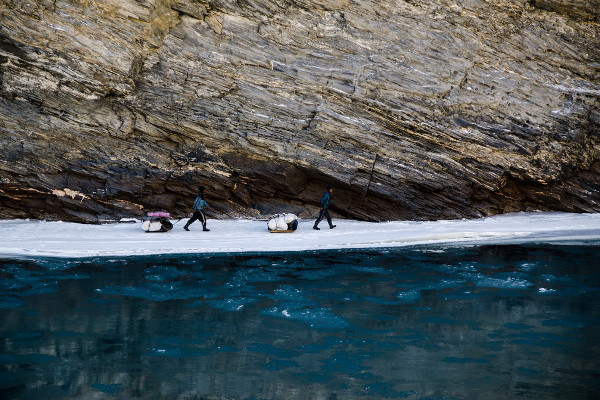
The Chadar Trek, or Zanskar Gorge, is widely known as one of the most difficult treks in the world . If you're an avid trekker, then chances are this wild and challenging trek is on your bucket list.
Chadar Trek Overview
The Chadar Trek is one of the most wild and beautiful hikes on the planet . Frequently covered by the world's top adventure channels and media outlets, the Chadar Trek takes hikers through a frozen river valley into the very heartland of India’s Ladakh region.
The region’s harsh desert environment and towering mountains make the Chadar trek one of the most popular treks in the Ladakh area . Very few treks are as remote as the Chadar and even fewer are conducted in high winter. The trek is not for the lighthearted as temperatures are often lower than -10 degrees celsius in the day and -20 at night.
Cut off entirely from the outside world, the Zanskar river is the only outlet for locals wishing to venture further into the Ladakh region. The trail has been used for nearly a thousand years by the Buddhist monks living in the region. You’ll trek the same route, walking over the frozen river as you cut a path towards Naerak. You will need to have a good level of stamina and fitness to have a really good time.
Accommodation is riverside camping.
Please Note: The Chadar trek is ideally suited to seasoned trekkers looking to experience one of the most remote places on earth.
Regional Map
The Chadar Trek is located in the Zanskar region of Ladakh which is part of the Indian state of Jammu and Kashmir .
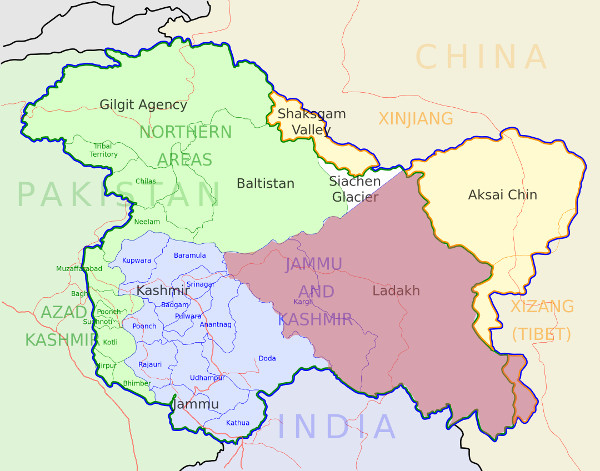
Chadar Hike Itinerary
Below is a detailed Chadar Trek itinerary. Please note that this is a typical itinerary that we would expect many operators to adhere to. However, some tour operators offer variations on this route.
Day 1-2: Arrival in Leh (3500 m)
After taking a flight from Delhi, you will arrive in Leh – the highest airport on earth! Take in the cool mountain air as you explore town before bedding down in your hotel for the night.
Day 3: Drive to Chilling – Hike to Tilad Do (3100 m)
After breakfast, your operator will take you by car to your starting point at Chilling roughly 3 hours away. Along the way, you will no doubt visit the important Buddhist temple of Shanti Stupa. Once in Chilling you will drive a little further to Tildad Do where your hike begins. The drive is fairly high and windy and you’ll need to hold your nerve as the road becomes tighter and more narrow.
You will then trek for several kilometres to reach your first coming ground. Along the path, you will walk for the first time on the river ice and get to grips with the cold weather of the region. Set up your tent quickly before the cold night sets in!
Day 4: Tilad Do to Shingra Koma (3170 m)
Today, you will be walking for almost 12 km as you venture along the valley floor towards your campsite at Shingra Koma. Make sure to follow the lead guide as you will be walking on river ice that can often crack.
As you walk, make sure to take in the incredible rock faces and surrounding snow-capped peaks as you walk in the footsteps of generations before you. The landscape is truly spectacular during winter and very few people get to witness such remote valleys.
Day 5: Shingra Koma to Tib Cave/Tibb (3225 m)
Today, you continue your journey along the river valley taking in the incredible gorges and frozen inlets as you venture towards Tib Cave.
The cave is a huge opening in the rock face in which you will camp for the night to shelter from the snow. Make sure to drink plenty of butter tea to keep your body warm and strong.
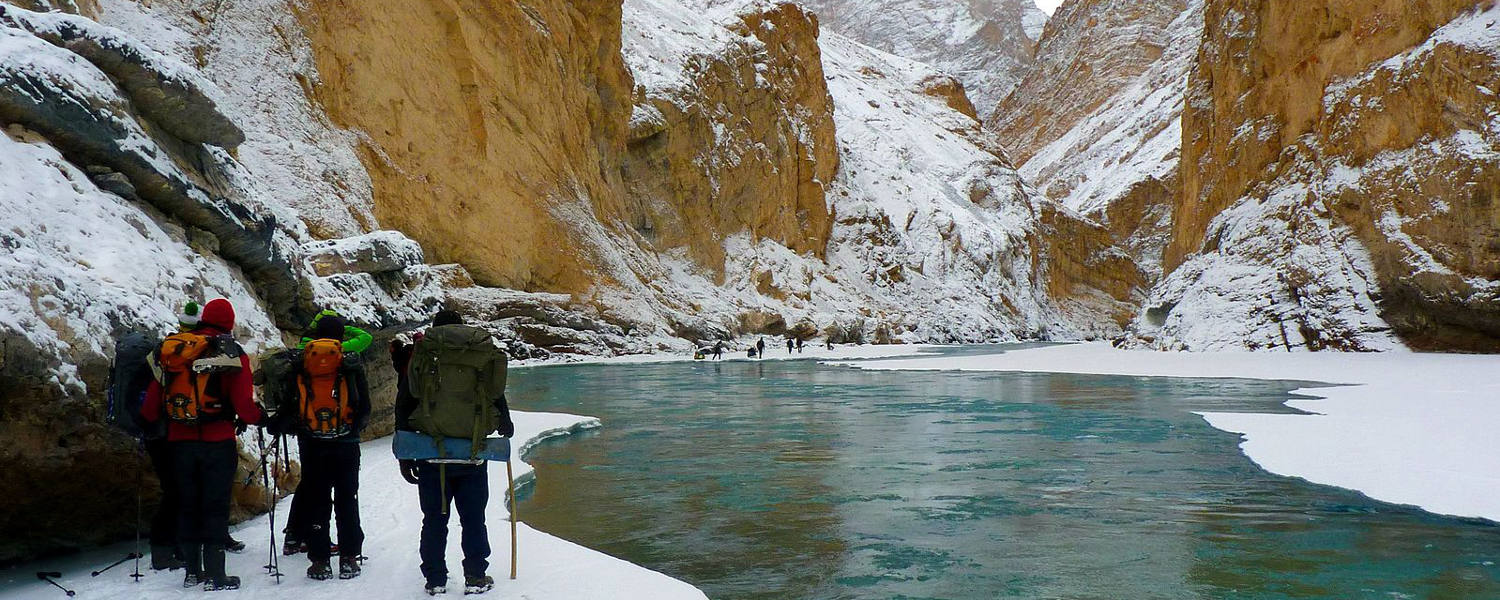
Day 6: Dib Cave/Tibb to Camp at Naerak (3390 m)
Today, you’ll be walking for roughly 10km as you trek the most beautiful section of the valley. Along the route you’ll be dazzled by one of the world's largest frozen waterfalls and large prayer flags fluttering in the cool breeze.
In the late afternoon, you’ll reach the village of Naerak where you have the chance to explore and talk to the locals – maybe share a drink or two!
Day 7: Naerak to Tibb
Today, your return journey begins as you proceed back to Tibb. However, your path may very well be different as the river reacts to the slightest temperature changes. Sections that were frozen may now be running and vice versa. Always follow the steps of your guide.
Day 8: Tibb to Shingra Koma
As you return down the river valley, you’ll have plenty of time to react on the stunning landscape and take pictures to show your relatives and friends back home. Keep a sharp eye out for wildlife including foxes, ibex and the elusive snow leopard. Although rarely spotted, you can be assured the leopards are watching.
Day 9: Shingra Koma to Chilling – Chilling to Leh
This is your last day on the Zanskar River. You’ll trek back to Tilad Do where you will say a final goodbye to the locals before taking a car back to Leh. Relax in a warm and cozy bed for the night to rest your tired muscles.
Day 10: Departure
Today, you say farewell to your crew and depart Leh for Delhi. Here, you will take your international flight home.
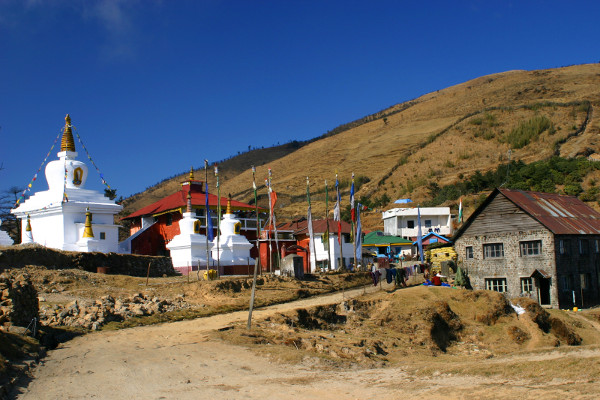
Chadar Trek FAQ
How much does the chadar trek cost.
The cost of the Chadar Trek varies depending on what operator you use. Local agencies often offer a guided trek for as little as US$250 per person (excluding flights). However, for an established western operator, you should look to pay at least double this. The trek can be dangerous and finding the right operator is important as your safety should be paramount.
You will also need to factor in flights, equipment, visas, vaccinations and food and drink. Each operator will offer a slightly varying package when it comes to food and drink on your trek.
- Visa, Vaccinations, Insurance etc: ~$300-$500
- Equipment (buying and hiring): ~$300-$800
- Flights to Leh: ~$1,000
- Tour Agency: ~$250 – 350 for a cheap local agency to ~$500 – 1000 for a Western trekking agency
- Tips: ~$50-$100
- Misc (additional food, unplanned travel / hotels ect): $200
- Total Costs: $2,200 – $4000
Are permits required for the Chadar Trek?
Permits are generally included with your trek costs. However, operators will often ask you to pay around US$50 for a wildlife/environment charge levied by the Indian government.
When is the best time to complete the Chadar Trek?
The best time to trek the Chadar Trek is January and February during the peak winter season . This is when the river is frozen and can be walked on (gently).
The Chadar Trek does not operate at any other point in the year.
Is altitude sickness a risk on the Chadar Trek?
Yes, the entire area is at high-altitude, and you’ll want to make sure you arrive several days before your trek to acclimatise to the thin air.
It is important to have a detailed understanding of the risks associated with high altitude trekking and how the body acclimatises.
We recommend you read our detailed article on Altitude Sickness and Acclimatisation .
How difficult is the Chadar Trek?
The Chadar Trek is considered to be one of the toughest treks in the Ladakh Region. The trail is cold, icy, often steep and always at high altitude.
Only experienced trekkers are recommended for this trek. You will need to be in good physical condition before attempting the route and have a good stamina built up.
The freezing temperatures also make the trek difficult with temperatures often exceeding -20 degrees at night and -10 degrees during the day.
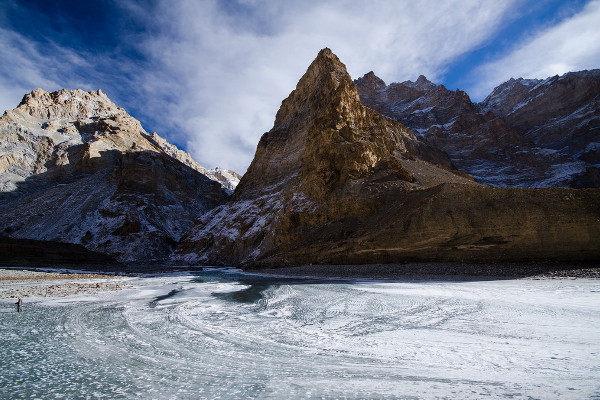
What gear do I need for the Chadar Trek?
Trekking in the Ladakh region requires a number of essential pieces of trekking clothing and equipment. The Chadar trek however requires some cold weather gear that is often not nesscary on the summer treks.
Many pieces of equipment can be rented or bought in Leh, but we recommend bringing the most important pieces of gear with you. The important thing is warmth. You’ll need a winter sleeping bag (may be provided) and good quality thermal gear.
To help you plan and prepare for your trek, we have written a detailed hiking gear list for multi-day treks .
What travel insurance do I need for the Chadar Trek?
Trekking insurance is a must on multi day hikes. This is particularly important on the Chadar Trek which is extremely remote. If an accident should occur that requires medical assistance and evacuation you will definitely want trekking insurance that can cover the costs of air ambulance and treatment.
Moreover, it is prudent to have insurance that covers you for any travel related risks, like lost, stolen, damaged or delayed baggage; flight delays and interruptions; and tour operators default.
Moreover, it is prudent to have insurance that covers you for any travel related risks, like lost, stolen, damaged or delayed baggage; flight delays and interruptions; and tour operators' default.
Are there any recommended guidebooks for the Chadar Trek?
There are a number of excellent guides we recommend for the Chadar Trek. These are:
- Trekking in Ladakh by Radek Kucharski.
- Trekking in the Indian Himalaya by Lonely Planet
- Trekking Guide to the Western Himalayas by Depi Chaudhry
- Ladakh: the Essential Guide: Including Kashmir & Manali by Partha S. Banerjee
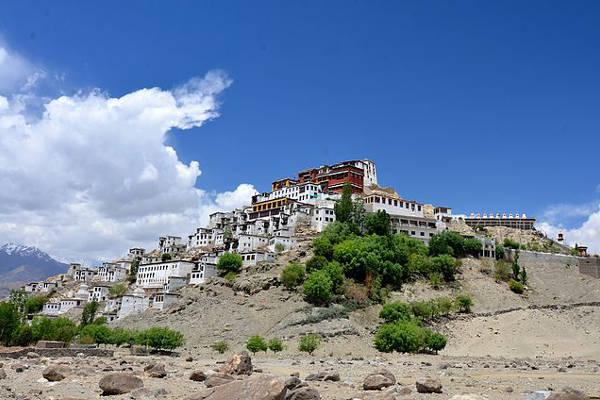
Are there other Indian Hikes besides the Chadar Trek?
Absolutely. We also recommend doing hikes like the Singalila Ridge , Markha Valley and Ladakh for unparallelled sightseeing and experiencing Indian culture and history firsthand.
Continue browsing
See more information on India . Or check out these other Indian Hiking articles:
- Hiking the Himachal Pradesh
- Trekking the Uttarakhand
- Roopkund Hike India
- Arunachal Pradesh India Treks
- Guide to India hikes
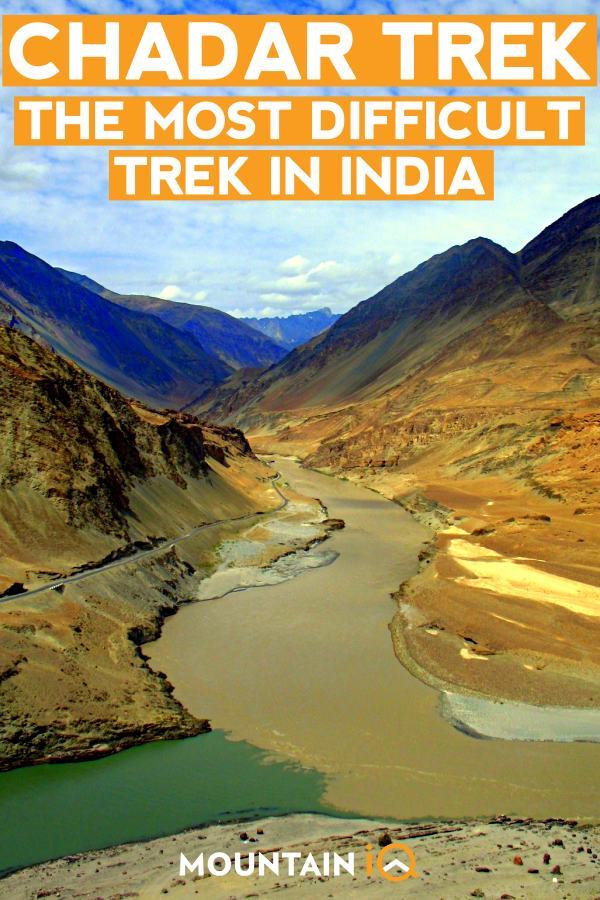
About the author
Mark Whitman
Mark has trekked extensively in Asia, Europe, South America and Africa. He founded Mountain IQ in 2014 with the sole aim to be the best online information portal to some of the most popular mountain destinations around the world. When not writing for Mountain IQ, Mark is out exploring the outdoors with his wife!
Leave a Reply
Your email address will not be published. Required fields are marked
We work with local guides to offer great value adventures at unbeatable prices

- Treks in Himachal Pradesh
- Treks in Uttarakhand
- Treks in Sikkim
- Treks In Jammu & Kashmir
- Uttarakhand
- Himachal Pradesh

Chadar Trek Guide 2024: Distance, Route, Map, Best Time & Itinerary
Table of Contents
Displaying a surreal backdrop of vibrant colors, the Frozen River Trek popularly known as the Chadar Trek is one of the most challenging and strenuous treks in the Ladakh region of Jammu and Kashmir State in India.
Therefore such a trek is only and only meant for those amateur and experienced trekkers that have one or two trekking experiences and also, wish to experience the ultimate thrill and excitement.

This trek is a winter trail in the Zanskar region of Ladakh . Moreover, the Zanskar region is famous for its stunning scenery and Tibetan-style Buddhist monasteries.
This arduous trek trail on the ice-clogged river under the gleaming blue winter sky passes through numerous beautiful valleys, mountain caves, and frozen waterfalls.
It is also one of the most strenuous treks in the Indian Himalayas as trekkers have to pass through rugged rocks and temperatures may surprisingly dip to minus 10 degrees, a rare climatic condition that can be difficult to acclimate to.
Chadar Trek Images
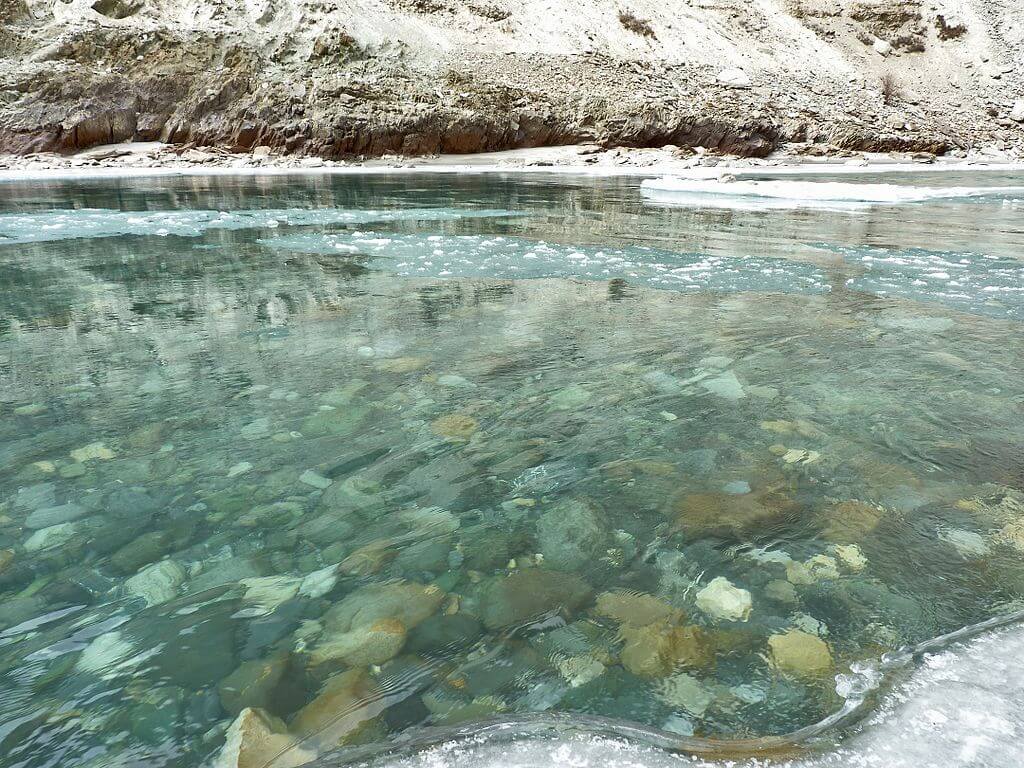
Where is Chadar Trek?
During the winter season, the Zanskar River freezes, giving trekkers a perfect solid platform for trekking. So just imagine, the trail to the Zanskar valley is going to be a challenging yet thrilling experience for the trekkers as the frozen vertical cliffs are 600 m high, and the Zanskar river is about 5 m wide.
Best Time to Visit Chadar Trek
The ideal time to visit the Frozen River Chadar Trek is between mid-January to February as during this time the upper layer of the Zanskar River freezes. The river looks like a sheet of ice; hence, it is referred to in the local language as ‘Chadar’ which means blanket.
Read more: Hidden Hill Stations In India
The winter in Ladakh region is frigid with nature. From January to February the days are relatively warmer but there will be a chill in the air. January is the coldest month in Ladakh. Early mornings, evenings and night times are extremely cold.
Daytime temperatures in Leh, and on the trek, will be between –25°C to 6°C and night-time temperatures can drop to -25°C to – 35°C. There is heavy snowfall in January and February and everything around is covered in pristine white snow.
Chadar Trek Highlights
- Trek along the conventional winter trading route connecting Padum to Ladakh along the frozen Zanskar River.
- This is an arduous adventure with only a couple of groups making the trek every year. The conditions on the river can vary so a flexible approach is required!
- Gain insight into the local culture of Zanskar and you will get a unique opportunity to homestay in the beautiful Zanskari villages along the way.
- Go for a sightseeing tour to explore the architecturally rich Gompas and forts around Leh as you
- let yourself acclimatise to the altitude.
How to Reach Chadar Trek?
Leh Kushok Bakula Rimpochee Airport is the main airport in Leh City. There are quite a number of flights like Air India and Go Air that connect Leh with Delhi and with a few other major cities in India. You can opt for air travel and have a very unique and thrilling experience of flying over the mountains.
Leh is inaccessible via roadways and railways during this time period(winter season).
Read more: Sham Valley Trek Ladakh
Places To Visit Near Chadar Trek (Zanskar Region)
1. Zanskar Valley
An acute and mesmerizing sight, Zanskar Valley is popular for the challenging treks it offers. With the craggy landscape of the surrounding mountains, the snow-covered peaks, the smooth flow of the misty clouds, the breathlessness offered by the isolation, and the flawless glory of nature, the valley is a breathtaking sight. This valley sits in the Zanskar range of the great Himalayan Mountains.
The range, rising to an elevation of about 6000 meters, is home to several exotic flora and fauna species. On the way to the valley, you can witness captivating meadows, gleaming streams, and the Drang-Drung Glacier among other sights.
2. Pensi La Pass
Known for separating the Zanskar valley from the Suru valley, Pensi La Pass is located at 4400 meters above sea level in the Zanskar range of mountains.
Rich with exotic medicinal plants, blue-green water springs and a spectacular view of the circumscribing mountains, this region is the best campsite for trekkers who wish to refresh themselves before resuming their journey. A variety of fauna are also present here including the commonly observed marmots and brown bears .
The Pass is also bounded by glaciers on both sides, from which streams flow into the Suru and Zanskar river, creating an enchanting sight.
But it is accessible only during the months from May to September, and the region is submerged and hazardous due to heavy snowfall observed during the rest of the months.
Named after an ancient Indian Buddhist master called Padmasambhava who was known as the second Buddha, the historically rich town of Padum rests at an altitude of 3669 metres in the Zanskar range.
The most populated town of Zanskar, Padum also serves as the abode of flora and fauna species.
Once the known capital of the ancient Zanskar Kingdom, the region still holds ancient relics like intricate carvings on a large rock situated on the banks of the river Lung-nak, dating back to the 8th century.
The town also consists of two ancient Buddhist monasteries situated on the hilltop. Apart from these attractions, the breathtaking beauty of the surrounding areas from this region is too lovely to be put into words.
Also acting as a trekking base, the landscape comprises of vast grasslands, huge agricultural fields, lush green forests, beautiful streams and the ruggedness of the mountains.
4. Zanskar River
As mentioned above, the Zanskar River trek or the Chadar Trek is a winter trail and is undertaken by some of the bravest souls of the land. One of the largest tributaries of the river Indus, Zanskar River emerges from the north-facing Himalayan slopes.
Further, the Zanskar River bifurcates into the Doda tributary, which begins in close proximity to the Pensi La Pass and flows alongside the Zanskar Valley towards Padum, whereas the Kargyag river tributary forms the second branch emerging from the Shingo La and Tsarap river.
The confluence of these two tributaries forms the Lungnak river which is also called as Lingti or Tsarap river. The entire area of the Zanskar river forms a U-shaped valley owing to the surrounding glaciers.
A captivating sight by day as well as during the night, the river provides an enthralling trek, especially during the winter months at a whopping elevation of 3800 metres making it a must-visit site.
Situated between Kargil and Padum, Rangdum is an elliptically shaped plateau in the Kargil district of the Jammu and Kashmir State. Situated at an elevation of 3657 metres, the plateau lies in the Suru Valley region about 100 kilometres away from the Kargil city.
Surrounded by colourful hills on one side and dazzling white glaciers on the other, the region is an alluring place. The Drang-drung glacier can also be witnessed from this region.
A beautiful region in the north of India, Zanskar is home to such amazing places that you can explore to relish your lovely vacation.
Frozen River Chadar Trek Itinerary
Day 1: Delhi – Leh (Rest for acclimatization)
Take a flight from Delhi to Leh. I would suggest a morning flight. On arrival at Ladakh, take a taxi in order to reach the hotel. Then you can visit the local markets of Leh like the Tibetan market for clothes and the Moti market in the evening. Try to return early from the markets and take proper rest in the hotel.
Day 2: Leh – Shey – Thiksey – Hemis
So, today you will be heading on a sightseeing tour to some important monasteries in the area. You will be visiting Shey Gompa, which was once the summer capital of Ladakhi kings; Thiksey Gompa, which is said to be one of the most beautiful structures in Ladakh and the famous Hemis Monastery belonging to Drukpa Order. Then, you may stay at the guest house in Leh.
Day 3: Leh – Chilling (3200 mts/ 5 hrs drive)
Start the day with a hearty breakfast and then embark on a trip to Pishu Village, through the roads that are bestowed with the sheer charisma of nature. Overnight, stay in the guest house.
Day 4: Chilling – Zaribago (3250 mts / 5 hrs)
Try to wake up by 7 am. I know it is difficult to wake up so early when you are on vacation. Yet, to make your vacation special try to follow some tips. Then get fresh and eat a proper, light, and healthy breakfast. Also remember to carry some biscuits, fruits, water bottles, and napkins along with you.
Begin the first day of the trek to Zaribago, which will take approximately five hours to reach. Overnight, stay in Zaribago.
Day 5: Zaribago – Deepyokma (3300 mts/ 5 hrs)
Today, it is going to be a thrilling yet exciting experience as you will walk on the frozen Zanskar River till you reach Deepyokma. Overnight, stay in the Deepyokma camp.
Day 6: Deepyokma – Nyarakpulu (3400 mts/5-6 hrs)
Today you need to reach Nyarakpulu below the Nyarak village from Deepyokma by trekking for about 5-6 hours. Overnight, stay in the camp.
Day 7: Nyarakpulu – Lingshed (3800 mts/ 4 hrs)
Depart from Nyarakpulu and have an hour’s walk to reach the small village of Lingshed. Relish the local culture and pleasing atmosphere of the private houses equipped with central heating systems.
Day 8: Lingshed (3800 mts)
Get ready for a fun-filled and exciting day of the Frozen River Chadar Trek. Witness the breathtaking landscapes of Lingshed, visit the monasteries and spend time with the natives of Lingshed. Stay in a Lingshed guest house.
Day 9: Lingshed – Nyarakpulu ( 3400 mts/ 5 hrs)
Today you need to trek till Nyarakpulu. Overnight, stay in a Nyarakpulu guest house.
Day 10: Nyarakpulu – Tso Mopoaldar (3200 mts/8 hrs)
Today, get ready for a long walk of around 5 hours from Nyarakpulu to the campsite at Tso Mopoaldar.
Day 11: Tso Mopoaldar – Tilatdo
Post a nutritious breakfast and embark on a trek till Tilatdo. Overnight, stay in Tilatdo.
Day 12: Tilatdo – Chilling – Leh
Return to Chilling. Drive ahead and reach Leh. Overnight, stay at a hotel in Leh.
Day 13: Leh – Delhi
Now your trip is still not got over. You still have to reach your home. So, reach the airport in time to catch the flight to Delhi and also, for those who have come by road, I wish you a safe journey ahead. Do not forget to capture some photos,and shoot videos while driving through the hills, forests, and then the plains.
I know you must be feeling quite tired and also sad at the same time because your trip has now come to an end. But I hope you enjoyed your trip to Frozen River Chadar Trek. Till then, keep on trying new trekking activities. We will meet soon with a new trek!
Frequently Asked Questions About Chadar Trek
When should i book for chadar trek.
You should book this trek two to three months in advance so that you get an ample amount of time to prepare for the trek.
What is the Minimum Age Required for Chadar Trek?
The Chadar trek is a moderate trek with a maximum altitude of 3850 mts/12628 ft, so the minimum age required is 15 years.
What kind of shoes will be Required for Chadar Trek?
Trekking shoes with good ankle support are a must for any trek in the Himalayas. Quechua Forlclaz 500, Hi-Tec Colman, and Salomon are some of the ideal shoes with value for money.
Is it Safe to Drink Water From Streams?
Himalayan stream water is safe to drink as well as for cooking but it is better if you can carry a few chlorine tablets for disinfecting water.
Which Vehicles are Used for Transportation Purposes?
Most of the Himalayan roads towards the trek are rugged, so a vehicle with good ground clearance like Mahindra Bolero, Scorpio, Safari Dicor, Tata Sumo, etc are used for transportation purposes
Is Chadar Trek for Beginners?
What i believe is that yes, chadar treks are for beginners but if they follow your guide instructions properly so there is no harm and the rest of thing is dependent upon yourself.
- Share This Post:
Related Articles
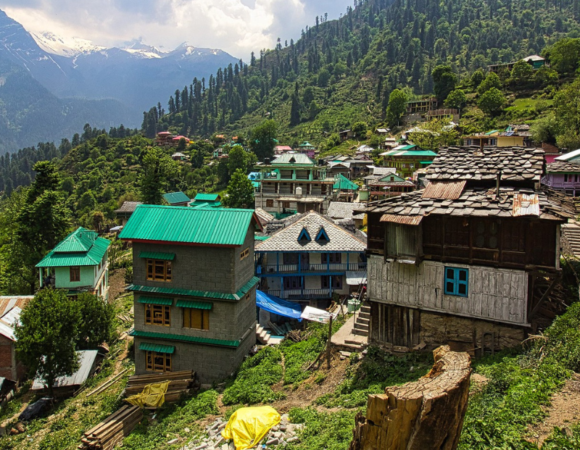
10 Best Hill Station In Himachal Pradesh, Highlights, FAQ’s
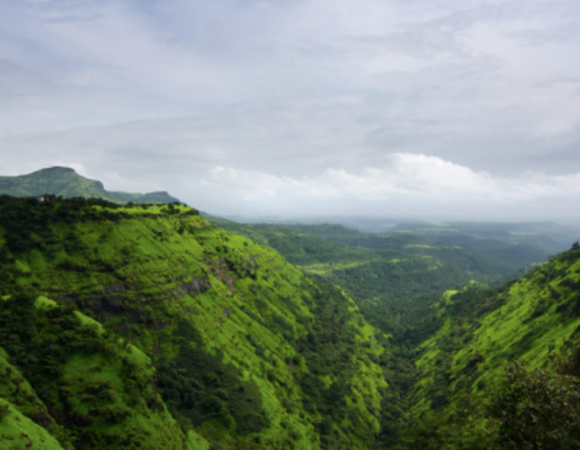
10 Best Hill Stations In Maharashtra, Highlights & FAQ’s
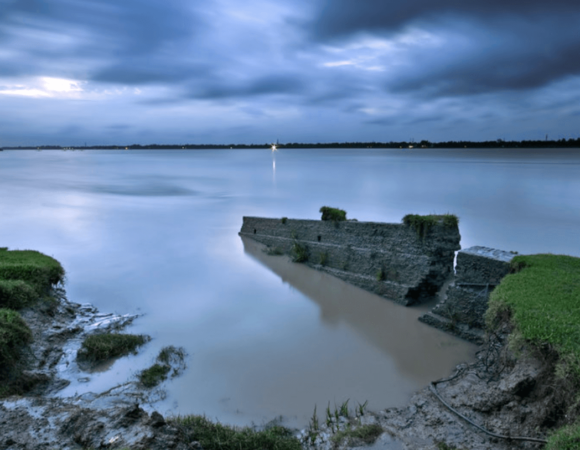
10 Best Hill Stations In West Bengal – Best Time, How to Reach Highlights & FAQs
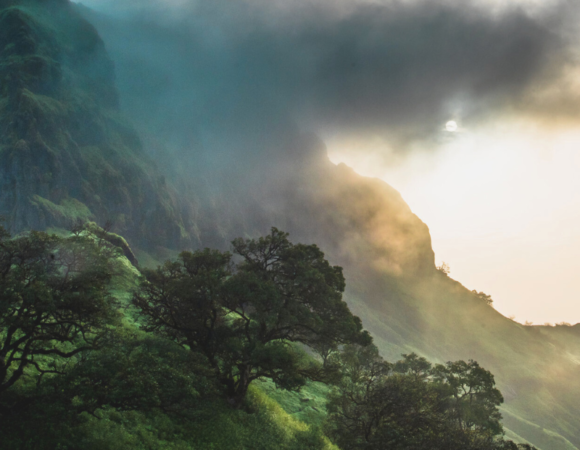
10 Best Maharashtra Trekking Places, Highlights, Treks & FAQ’s
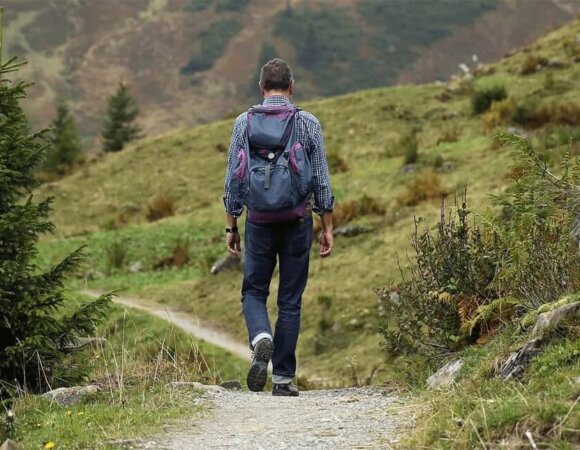
10 Best Trekking Places Near Delhi In 2024 & FAQ’s

10 Best Treks in Himachal That You Can Do in Winters
Add a comment cancel reply.
Save my name, email, and website in this browser for the next time I comment.
Things To Carry On Your Trek
Book your experience with us.
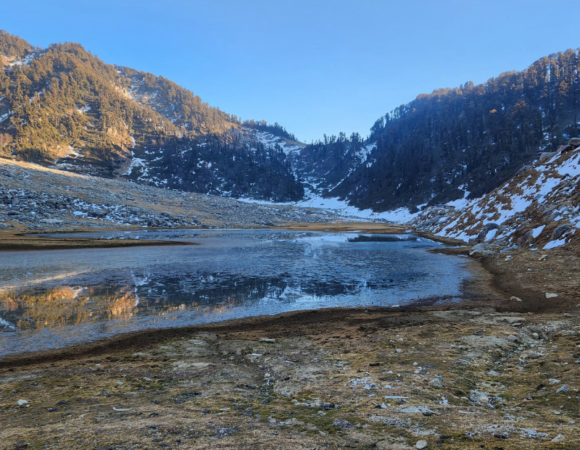
- Amenities 5
Kareri Lake Trek
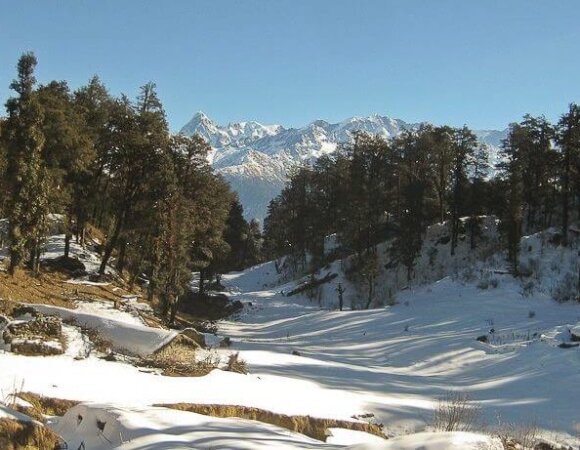
Dayara Bugyal Trek
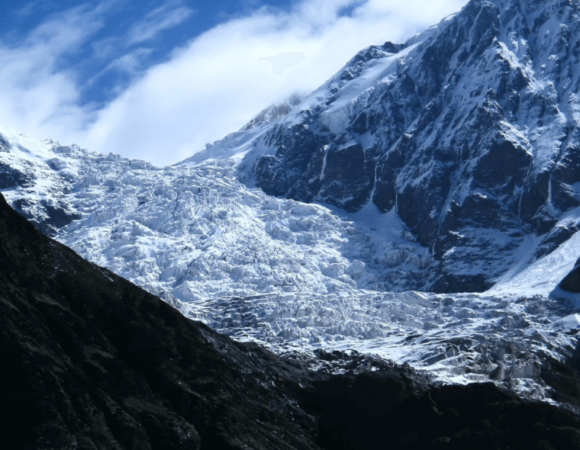
Pindari Glacier Trek
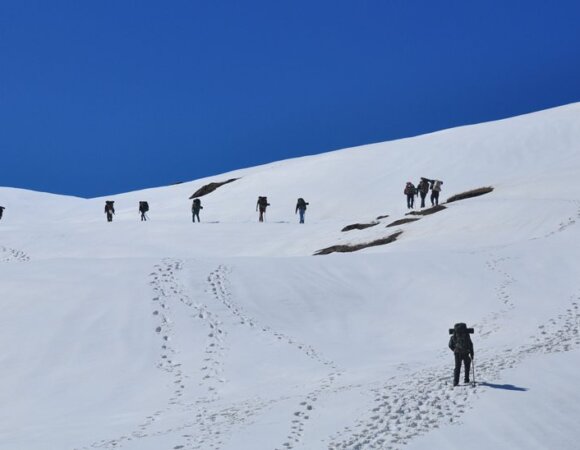
Panwali Kantha Trek
Book your unforgettable experience with us, reset password.
WhatsApp Us
- More Networks
.png?w=auto&h=400)
Chadar Trek
Chadar trek overview.
Situated in the Leh region of Ladakh, the Chadar trek is one of the most magnificent treks in the Himalayas that allows you to cover a distance of 62 kilometers in just nine days. It is one of the most popular and longest trekking trails that provides a dream come true experience to the trekkers while hiking along the dramatic mountains. The Chadar lake trek feels like a journey to the North Pole as the temperature drops to -30 degrees Celsius, thereby grading it high on the difficulty level.
The Chadar trek Ladakh lets the trekkers walk on a thick layer of ice that covers the Zanskar river. It is not the only reason that draws thrill seekers to this fantastic attraction, but people are attracted to several other fascinating and ethereal sights. This trek brings you close to the natural wonders of the world, such as the frozen Nerak waterfall, white sand, and knee-length snow, and all these beautiful sights in your trekking experience will ignite your senses and will create a mark down your memory lane.
The landscape and the overall experience of the Chadar frozen river trek will also leave an imprint on the heart of the trekkers. So, if you are looking for a remarkable trekking experience, the Chadar trek should be on the top of your bucket list.
Book Chadar Trek Package
Chadar trek, ladakh - frozen river trek, quick facts of chadar trek.
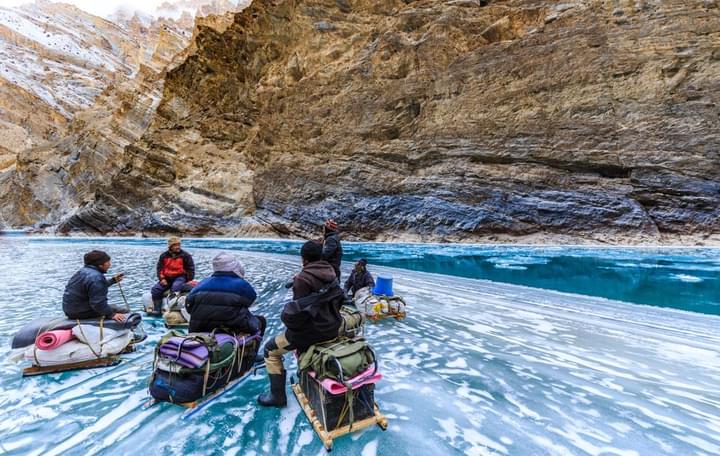
- Maximum altitude: 11150 feet
- Grade: Difficult
- Duration: Nine days
- Trekking distance: 62 kilometers
- Trail type: One-way trail. The trek commences and ends at Shingra Koma.
- Rail head: No rail head
- Airport: Kushok Bakula Rimpochee Airport (Leh)
- Snow Season: January and February
- Service from: Leh Airport to Leh Airport (Transport included)
- Base camp: Leh
- Best season: Winter season (January and February)
- Region: Ladakh
Who can Participate: - Serious trekkers who are fond of experiencing freezing temperatures.- Should have a minimum age of 15 years.- People with enough stamina to cover a distance of five kilometers in just 30 minutes.- Has an experience of at least one high-altitude trek of 5000 meters or 16400 feet.- Should have the capacity to carry a 12 to 16 kg backpack.
Why to Go for Chadar Trek?
Chadar trek is one of the best trekking experiences that you should have at least once in a lifetime. Walking on the frozen sheet of ice on the surface of the river with dramatic snow-capped mountains on either side is indeed a remarkable experience in itself. This trekking experience allows you to witness the Nerak waterfall which is completely iced from top to bottom. There is also a possibility that you may encounter exotic wildlife, like snow leopards, blue sheep, and ibex in the chilling surroundings of your trek. Thus, it is a do-before-you-die adventure that lets you witness the in-depth Zanskari cultures, jaw-dropping scenery, and bone-chilling climates.
Short Itinerary for Chadar Trek
Day 1 : The Chadar trek Ladakh starts with your arrival at Leh. Rest for the day or explore the attractions of Leh.
Day 2 : The second day of your Chadar Lake trek will be your acclimatization day when you will be adapting to the cold weather conditions of the surroundings.
Day 3 : Go to the Government Medical Camp to get all your medical tests done. Complete all your insurance formalities and other documentation work before moving forward for the Chadar winter trek.
Day 4 : It is the actual day of the Chadar trek Ladakh when you will move from Leh to Gyalpo through Chilling and then to Tilad Do.
Day 5 : On the next day, the journey included in the Chadar trek package will continue to the Tibb Cave.
Day 6 : It is an iconic day of the Chadar winter trek as you will reach Nerak from Tibb Cave, where you can witness the Frozen Waterfall that garners the interest of tourists from across the globe.
Day 7 : The seventh day included in the Chadar trek package will be a return day from Nerak to Tibb Cave.
Day 8 : Moving forward, you will return to Shingra Koma through Gyalpo and then take an adventurous ride back to Leh.
Day 9 : It is officially the last day of the Chadar Lake trek when you will be returning to your homes with tons of memories of the trek.
Chadar Trek Detailed Itinerary
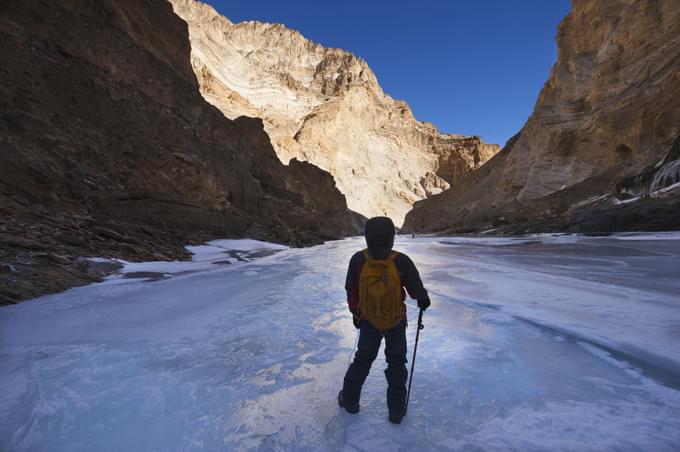
- The Chadar trek commences after you arrive at the Kushok Bakula Rimpochee Airport in Leh.
- On your way to your hotel on the outskirts of Leh, you will experience gorgeous snow-capped mountains that will definitely leave you awestruck with their striking beauty.
- It is advisable to keep your woolen caps and gloves handy as you may feel an immediate drop in temperature when you arrive at the Leh airport.
- After you reach Leh, you can rest for the day and acclimatize to the cold weather conditions.
- The weather in Leh will give you a taste of what it will be like when you go for the Chadar trek.
- In the evening time, you can go window shopping on the streets of Leh market to grab things that you would require in the trekking expedition.
- You are not allowed to start your trekking journey on the same day of your arrival because it is extremely necessary for your body to adapt to the cold weather condition as the temperature may drop even further when you start climbing towards the Zanskar River.
- Now, get back to your rooms and have a good night's sleep to revitalize your body for the trip.
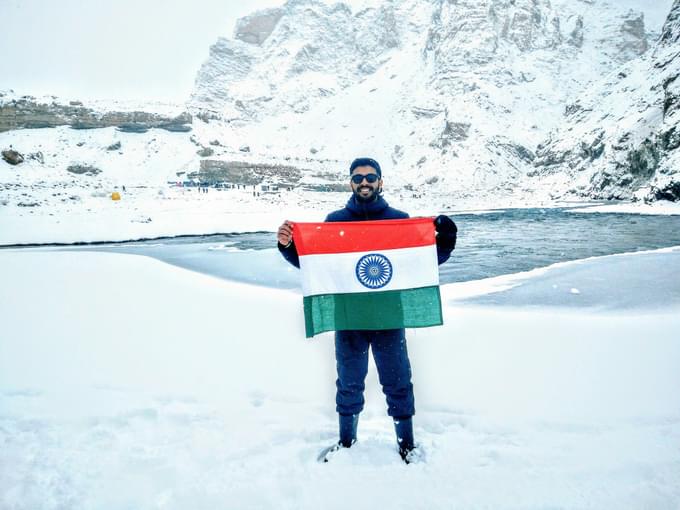
Rest and Acclimatize in Leh
- Considering the health conditions of the trekkers and according to the new regulations, trekkers who are willing to go on the Chadar trek are required to acclimatize their bodies completely to the cold weather conditions in Leh for two days.
- In order to acclimatize, you can either spend the day visiting the nearby attractions of Leh or rest in a centrally-heated room at your hotel.
- Every trekker is advisable not to go to places with higher altitudes on this day.
- The second day gets completed by packing your travel backpack with all the essentials and rest for the day.
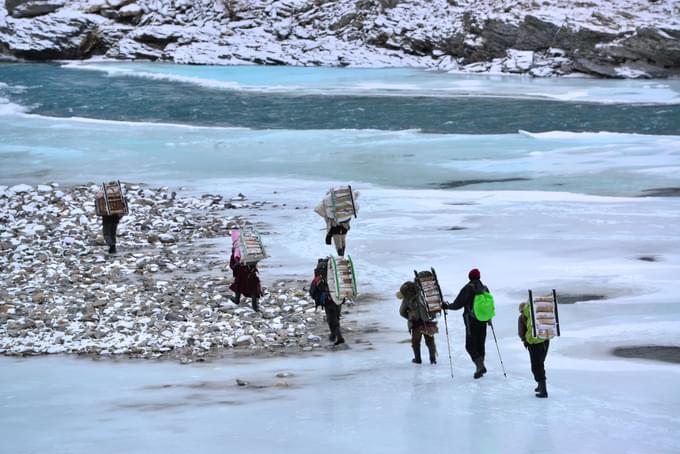
Undergo Medical Checkup in Leh
- The third day is the most significant day of the trek. This day decides whether your body is eligible for continuing the Chadar trek or not.
- For this, you need to wake up early in the morning and drive or walk to the Government Medical Camp.
- You must reach the location as early as possible because the tests get delayed due to the rush of tourists. It will not take more than three to four hours to complete all your checkup depending on the rush.
- After the tests, you must proceed further to finish any insurance formalities, wildlife permits, and other significant documents.
- By any chance, the tests state that you are unfit for the Chadar trek, you can take a physical wild card and select the ‘Flavor of winter Ladakh’ tour without any additional cost.
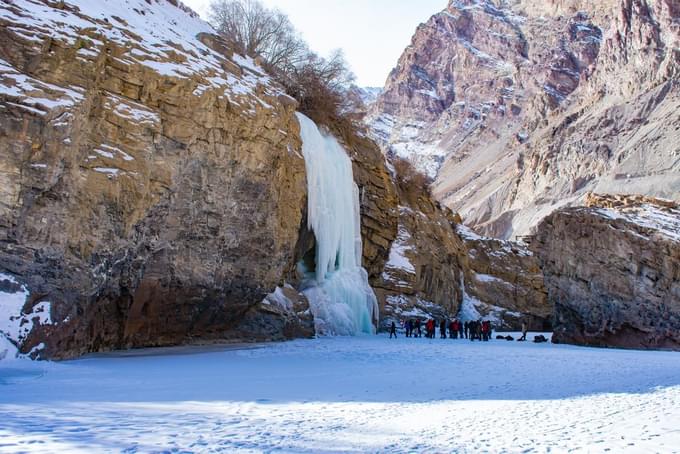
Move from Leh to Gyalpo via Chilling and Tilad do
- This is the actual day of your Chadar trek. On this day, you will head towards your first campsite in Shingra Koma through Chilling.
- The day will start with a drive from Leh that will let you spot some scenic attractions in Ladakh.
- On your way, you will come across plenty of remarkable sights, like Gurudwara Pathar Sahib, Magnetic Hill, and the convergence of the Indus and Zanskar river.
- After a short drive of 90 minutes along the Zanskar River, you will reach Chilling.
- It is the place where the car will drop you at the end of the road. From there, you will start your walk on the Zanskar river.
- Initially, it may be difficult for you to walk on the ice with your gumboots on as the sheet may be thin, but you will understand the ice patterns slowly and gradually.
- It is advisable to plant your foot and walking sheet on the ice to check the steadiness before moving on it wholeheartedly.
- You must also ensure that the weight of your backpack is not heavy so you can carry it yourself effortlessly.
- After a walking struggle of about one and a half hours, you will reach your first campsite at Gyalpo, where you will experience your first sub-zero temperature camping.
- Rest for an overnight sleep in Gyalpo.
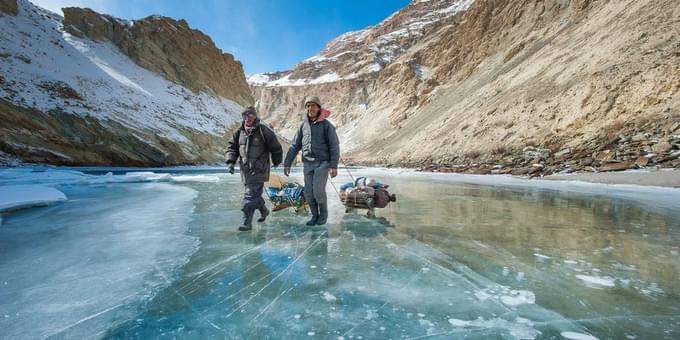
Gyalpo to Tibb Cave
- Chadar trek is one of the treks where you will not be able to see altitudes in quick succession. But, when you slowly move to Tibb Cave from Gyalpo after five to six hours, you will find yourself rising at an altitude of 300 feet.
- After spending a chilling night in your tent at Gyalpo, you are required to have a sumptuous breakfast to regain energy for the further trekking expedition. A hot cup of tea will also revitalize your senses in this cold temperature.
- After breakfast, the trek will resume, and the next campsite is Tibb Cave.
- While trekking, you will come across plenty of attractive frozen waterfalls, but the emerald green water of the Zanskar river will keep on flowing all along the trail.
- Midway to Tibb Cave, you can have your lunch.
- Post lunch, you will continue your trek, where you will discover varied rock patterns that shine uniquely as the rays of the sun fall on them.
- Finally, the day ends when you reach the campsite at Tibb Cave which is completely covered with dry sand.
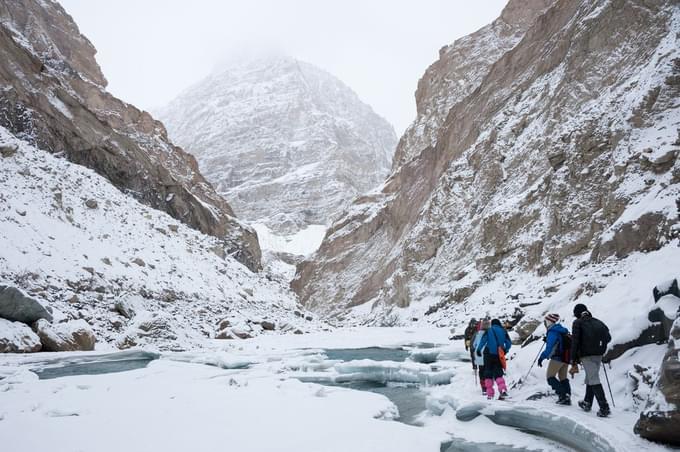
Tibb Cave to Nerak
- The destination of Day 6 will be Nerak, which is a 13 kilometers long trail that takes you to the exemplary landmark of the Chadar trek named the Frozen Waterfall. The Frozen Waterfall is one of the beautiful attractions that garner the interest of tourists from around the globe.
- You will be served with hot lunch on your way to Nerak.
- It is by far the coldest campsite where the temperature drops to -30 degrees Celsius at night. Hence, you must wear appropriate clothing to keep the chilling atmosphere at bay.
- Day 6 ends with reaching Nerak campsite, which is situated around 15 to 20 minutes from the Frozen Waterfall.
- If the trekkers reach the Nerak campsite on time, they can also pay a visit to the Nerak village.
- The day ends with an overnight sleep in the Nerak camp.
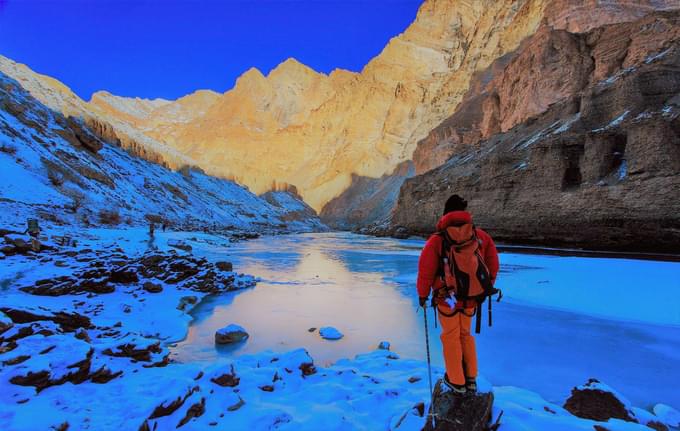
Nerak to Tibb Cave
- Day 7 will be the returning day of your Chadar trek. It is indeed your last chance to embrace and relive the moments on the Zanskar River near the Frozen Waterfall.
- Chadar trek is completely a unique experience in itself. The weather conditions are very unpredictable in this region. You may find that the layer of Chadar has completely vanished from where you have come. However, at the same time, you will find that a new layer has been formed in some other place. Thus, it is advisable to take back all the memories in your backpack before returning from the trek.
- Say goodbye to the locals and start your trek on your way back to the Tibb Cave.
- On your way back, you will find locals negotiating the conventional woolen Gonchas at the Chadar where the monks are returning to Leh from the monastery at Lingshed. You may also find the young students returning to school after their vacation in Leh. This sight of local people is heartwarming to see as they are surviving in such a cold climate yet keep a long smile on their faces.
- You can sign off for the day after reaching Tibb Cave.
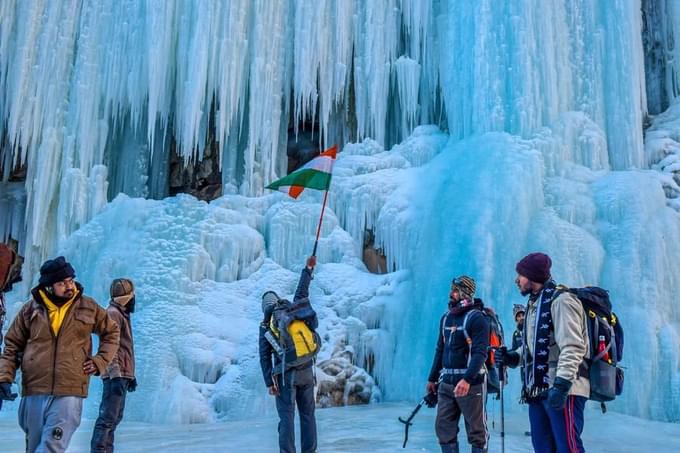
Tibb Cave to Shingra Koma via Gyalpo and then to Leh
- On Day 8, it is time to go back home and you need to wake up early to cover a long distance from Tibb Cave to Shingra Koma.
- While moving down to Shingra Koma, you will discover high walls of mountains rising on the sides of the river that almost looks like a castle.
- You will also notice the steps and footprints of foxes, ibex, or snow leopards on the Chadar trek.
- If you are lucky, you may even spot snow leopards. But you must rest assured that someone will keep a watch on you all the time on your way back to Gyalpo.
- You will not get a chance to retrace the steps while going back as the way might have changed a lot. The layer of chadar has melted and become thin. You may also see the formation of rocks on your way down to Shingra Koma.
- After reaching Shingra Koma, you will be asked to board a bumpy ride back to Leh at around 6.30 pm in the evening.
- You can rest after the tiring day at Leh in the warm guest house and get ready for your way back home on the next day.
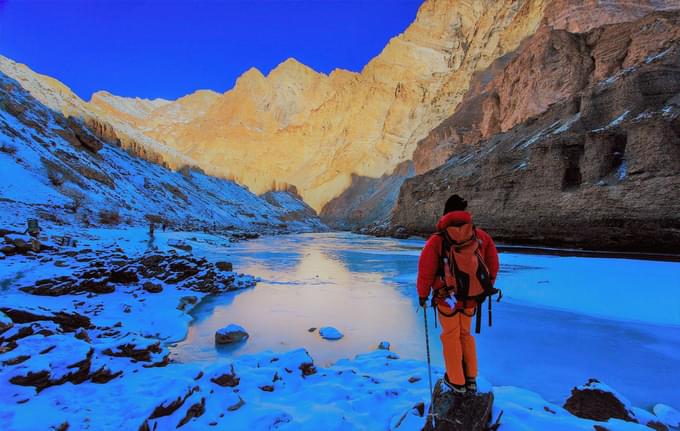
Depart from Leh
- Day 9 will officially be your last day of the Chadar trek as you move back to your home, taking all the memories of the trek with you.
- The day starts with a delicious breakfast, and then you can get ready for checkout from the guesthouse by packing all your belongings.
- Say goodbye to your guesthouse and reach the Leh airport, from where you can head towards your destinations further!
- Your Chadar trek experience ends here.
General Trivia About The Trek
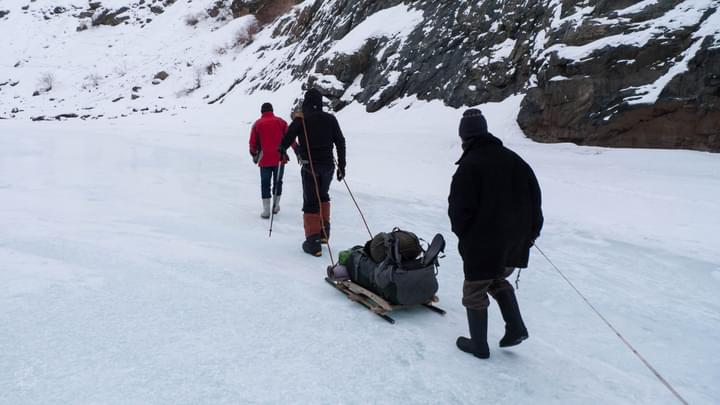
- Chadar trek does not include any kind of ascending and descending paths similar to the other Himalayan treks as you will be walking on a frozen sheet of ice on the Zanskar river all the time.
- Although Himalayan waters are considered safe for drinking, the trekking experts advise purifying the water by boiling it with chlorine tablets during the trek.
- The trade route between Zanskar and Ladakh regions that has existed for more than 1000 years is known as ‘Khado Sanglam’ in the local dialect.
- Zanskar river freezes completely during the months of January and February to form a walkable path of ice.
- There must at least be a group of six to seven people to go on the Chadar trek with a maximum of 15 to 18 people.
- February is considered to be the toughest time to go on the Chadar trek as the fluctuating temperatures during the day and night can cause broken trails along the way.
- The temperature on the Chadar trek drops to as low as -30 degrees Celsius, and thin air keeps flattering your skin at every inch of your walk.
- Chadar trek is unique as it is a complete surprise package of slippery ice sheets, occasional cave stays, unusual campsites, and brisk-changing weather conditions.
- If you are lucky, you may spot an old snow leopard or other wildlife on your trekking expedition.
- Pictures of the beautiful frozen Nerak waterfall are surely a remarkable way to account for the memories.
Know Before You Go to Chadar Trek
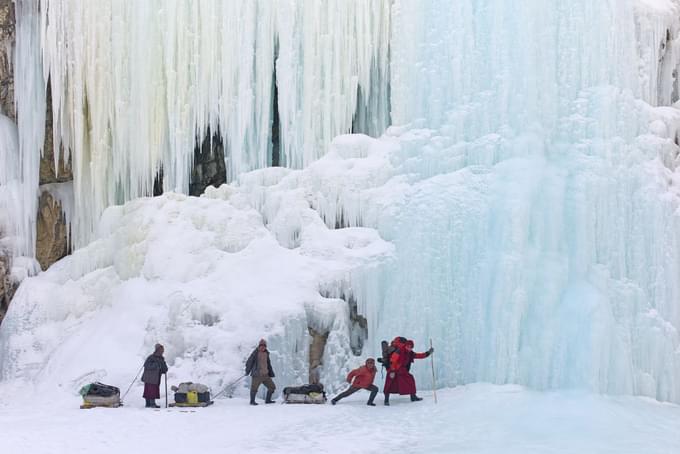
When you are going on a trekking expedition, it is essential to keep the do's and don’ts in mind. These tips will help the trekkers stay connected with their fellow travelers and prevent them in case of an emergency situation. Here are some of the important tips that trekkers should consider on the Chadar frozen river trek:
- Inform your friends and family about the trek and give the number of your trekking organization to them so they can contact you in case of any emergency.
- Wear warm clothes at all times and carry stuff that can keep you warm at all times as the temperature may drop drastically and unexpectedly during your trek.
- Do not forget to carry your first aid kit and all the necessary medications as bruises and cuts are relatively common during treks and hikes.
- Keep yourself hydrated at all times. People are more likely to skip drinking water due to the cold climate.
- Walk actively and carefully as the sheet of ice may be slippery.
- Do not litter everywhere as it is strictly prohibited to throw plastic and biodegradable stuff on the trekking trails.
- Avoid contaminating the waterfalls while bathing with chemical soaps because villagers use this water for drinking purposes.
- Remain polite towards your trek leader and co-trekker at all times.
- Do not skip your meal under any circumstances.
- Always be together with your trekking group, and do not wander anywhere on your own.
- Ensure that you carry all the trekking essentials in your backpack.
- Follow the instructions given by the trekking leader to ensure safety and security at all times.
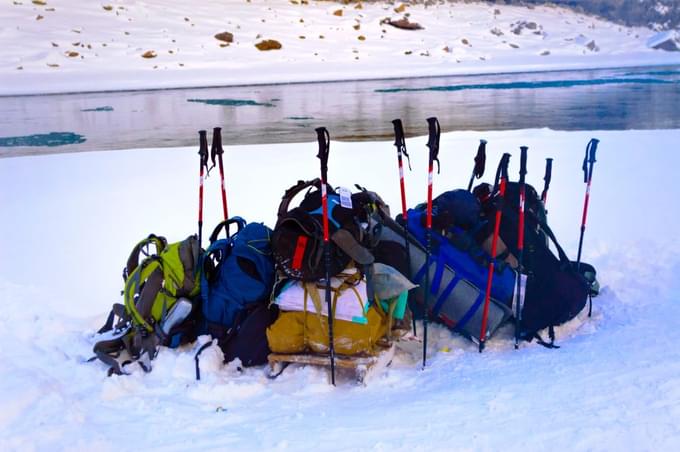
Basic Gear: - Backpack (50 to 60 liters) with appropriate shoulder straps and raincoat- 2 thermos flask water bottles of one liter each- Medical kit after consultation from the doctor- A walking stick- Snacks, like dry fruits, energy bars, electoral / ORS, and much more.
- 1 full sleeves non-cotton T-shirt
- 2 fleece T-shirts
- 1 fleece jacket
- 2 pairs of thermal inners (both upper and lower)
- 1 down feather or hollofil jacket
- 1 pair of fleece or wool gloves
- 1 pair of waterproof gloves
- 1 pair of waterproof jackets and pant
- 1 pair of Windstopper pant
Personal Utilities:
- Antibacterial powder
- Hand sanitizer
- Chapstick or Lip balm
- Moisturizer
- Quick dry towel
- Sunscreen cream
- Toilet paper and wipes
- Toothbrush and toothpaste
Hand Gears:
- 1 balaclava
- 1 head torch
- 1 neck-gaiters
- Dark sunglasses with side cover, UV protected (do not wear contact lenses)
- 1 woolen cap
Foot Gears:
- 6 pairs of cotton socks
- Gaiters (optional)
- Floaters or flip flops (optional)
- 1 pair of gumboots (it is advisable to buy them from Leh)
- 1 pair of trekking shoes (optional yet highly recommended)
- 6 pairs of woolen socks
- Chadar trek route map
- Sleeping bag
- Hot water bag
- Valid ID proofs (passport & driving license) and their copies
- 4 passport size photographs
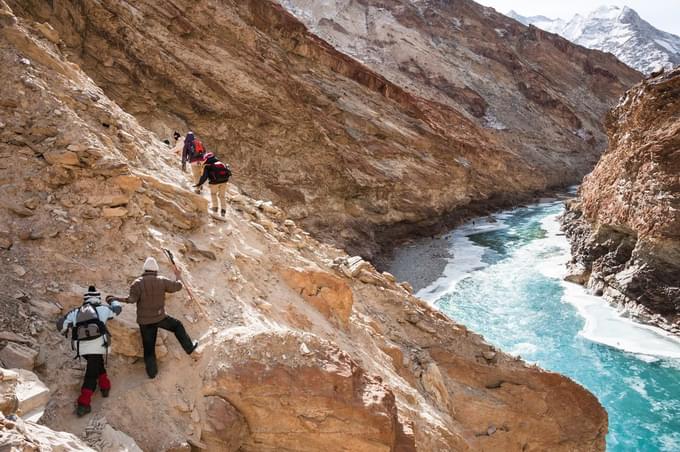
By Air- The easiest way to travel to the starting point of the Chadar trek Ladakh is Kushok Bakula Rimpochee Airport located in Leh. This airport is situated about 4 kilometers from the city's center and receives daily flights from Delhi, Mumbai, Srinagar, Chandigarh, Jammu, and several other places in India. Even if you are traveling from beyond the geographical boundaries of India, you can take a connecting flight from Delhi, Mumbai, and Kolkata to Leh. Go Air, and Air India are some of the airlines that operate frequently on this route. Traveling to Leh by air is an amazing experience, and it makes for a wonderful start for the trekking expedition.
By Train- You can also board a train to Leh. The train used to travel to Leh is New Delhi Jammu Tawi Rajdhani Express, which travels from New Delhi to Jammu. After reaching Jammu, you can take a bus to Srinagar and then to Leh.
By Road- After you reach the Leh airport, you will be traveling through two road routes, namely the Manali-Leh highway and the Srinagar-Leh highway. The visitors will discover beautiful snow-clad mountains and gorgeous roads while driving their way to the hotel. If you are visiting this place in extremely cold conditions (i.e., between October and November), these routes remain closed due to heavy snowfalls. From the airport, your trekking authorities will take you to your hotel so you can relax and start your trek afresh.
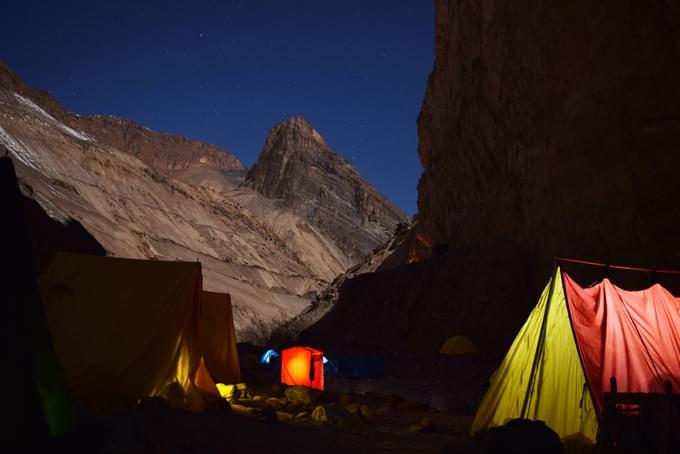
- The best and the only time to go on the Chadar trek is during the winter season, i.e., when the Zanskar river freezes. These winter months of January and February are best suited to admire the natural beauty of the Himalayas that has been preserved for centuries.
- If you are thinking of which month to plan your itinerary for Chadar frozen river trek, it is advisable to do it during the month of February as the ice is the most stable at this time.
- With temperatures ranging between -5 and -25 degrees Celsius, trekkers feel that February is the toughest winter time for Chadar trek.
- The fluctuating temperatures during the day and night in the month of February makes the trekking experience even more difficult as you may encounter broken trails along the way.
- On your trekking expedition, Nerak is the coldest among all the campsites, where the temperature drops down to as low as -30 degrees Celsius at night. You may also get a chance to visit the Nerak Village if you manage to reach the waterfalls on your trek.
- The heavy snowfall of the Pensi La Pass creates a thick sheet of ice on the surface of the Zanskar river and cuts the place from the rest of Jammu and Kashmir.
- Even the locals wait for winters to come so they can create a walkable path of ice and go back home. Hence, the winter season, i.e., January and February are the best months to go on a Chadar trek with your friends.
You May Also Book
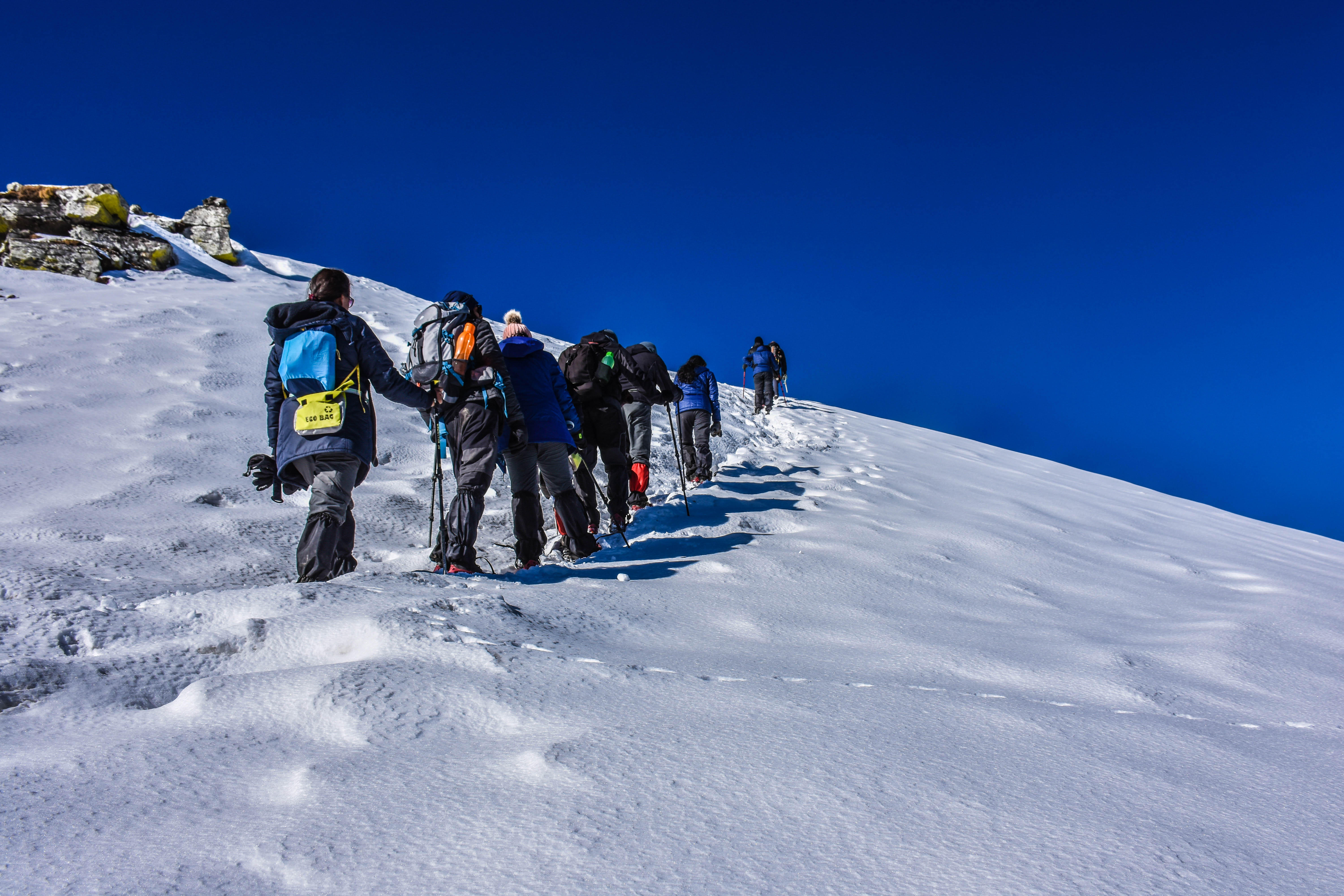
FAQ's of Chadar Lake Trek
How difficult is the chadar trek.
The Chadar trek is regarded to be one of the most difficult treks in India. It gives you a larger-than-life feeling with its extreme weather conditions amidst the natural surroundings. What makes the trek even more difficult is that trekkers are required to walk on the surface of the thick layer of a frozen river. Hence, a trekker should have enough stamina to cover a distance of five kilometers in just 30 minutes is a good fit for the Chadar trek Ladakh.
You can also check your body mass index (BMI) to find if your fitness level matches the difficulty of the trek. If your BMI is normal, you can plan your fitness regime for trekking. On the contrary, if your BMI is not normal, you are required to consult your trusted physician before adopting any fitness regime. Moreover, consultation from a medical practitioner is recommended if you are suffering from any chronic illness.
What are the best months to visit this trek?
The best months to visit the Chadar trek are between the first week of January to the second week of February. During these months, a thick sheet of ice gets formed on the Zanskar river, which makes a great trekking path for adventure lovers.
What is the minimum and maximum age limit of the Chadar trek?
The minimum age limit of the Chadar trek is 13 years, but children between 13 to 17 years of age should always be accompanied by their parents or guardians. For people above 60 years of age, you need to carry a detailed medical certificate that states you are perfectly fit for an adventurous activity like trekking.
What is the cellular network connectivity of the trek?
The cellular network connectivity of the trek is relatively nice upto Leh. But, it becomes difficult to find any network connectivity once you proceed to elevate on your trekking expedition to the Himalayas.
When will there be snow on this Chadar trek?
You will always find snow on this Chadar trek as the trek takes place during the months of January and February when the place experiences extreme snowfall.
What is the cost of the Chadar trek?
The cost of the Chadar trek starts from 17000 to 28000 per person. However, this cost may be subject to change if you may wish to rent a porter or mule. The hospitalization or emergency fees also need to be borne by the trekker apart from the general charges. Hence, you must get all the terms clear with your traveling authority before booking your expedition. On the contrary, if you book your trekking tickets online, you may avail yourself of the additional deals and discounts to make your trip cost-effective.
Is Chadar trek for beginners?
Chadar trek involves walking over a thick sheet of ice on the surface of the Zanskar river. This nine-day trek includes extreme weather conditions with snow all around. It becomes difficult to walk on ice because of the uneven formation. Surviving in the extreme temperatures of -30 degrees Celsius is a remarkable experience in itself. Hence, the Chadar trek is not for beginners as a beginner would not know the knick-knacks of handling the extreme situations of the trek.
What kinds of tents or sleeping bags will be provided to us on the trek?
On the Chadar trek, each trekker is provided with four-season tents and the sleeping bags are rated to prevent people from temperatures between -15 to -20 degrees Celsius.
Are there any toilet facilities on the trek?
No, there are no toilet facilities on the Chadar trek. You need to work in compliance with the rules and regulations of the villagers.
Is it safe for a solo woman traveler to travel in fixed departures?
Yes, it is completely safe for a solo woman traveler to travel in fixed departures. The trekking organization takes complete care of the safety and security of women in the group.
Will I get a certificate of trek completion?
Yes, you will get a certificate of Chadar trek completion once you return from your expedition. This certificate for trek completion will not be available if you return from the trek midway.
Treks in Himachal
Treks in uttarakhand, treks in ladakh, treks in nepal, treks in north-east, treks in kashmir.
.png?w=auto&h=400)
The content and images used on this site are copyright protected and copyrights vests with the respective owners.
© 2024 www.heyhimalayas.com All rights reserved.

Embarking on a transformative journey through six chapters, we traverse India's landscape, exploring pioneering startups and their revolutionary...
- Sustainability
- Agriculture
- Brand Campaigns
- Watch inspiring videos
- Advertise With Us
- Press Coverage
Follow Us On
Download App
The 5-Minute Guide To Everything You Need To Know About The Chadar Trek
Planning to explore the adventurous and beautiful Chadar Trek in Ladakh? Here is all you need to know before you pack your bags. From what to see to what not to do, here is your one stop guide to follow.
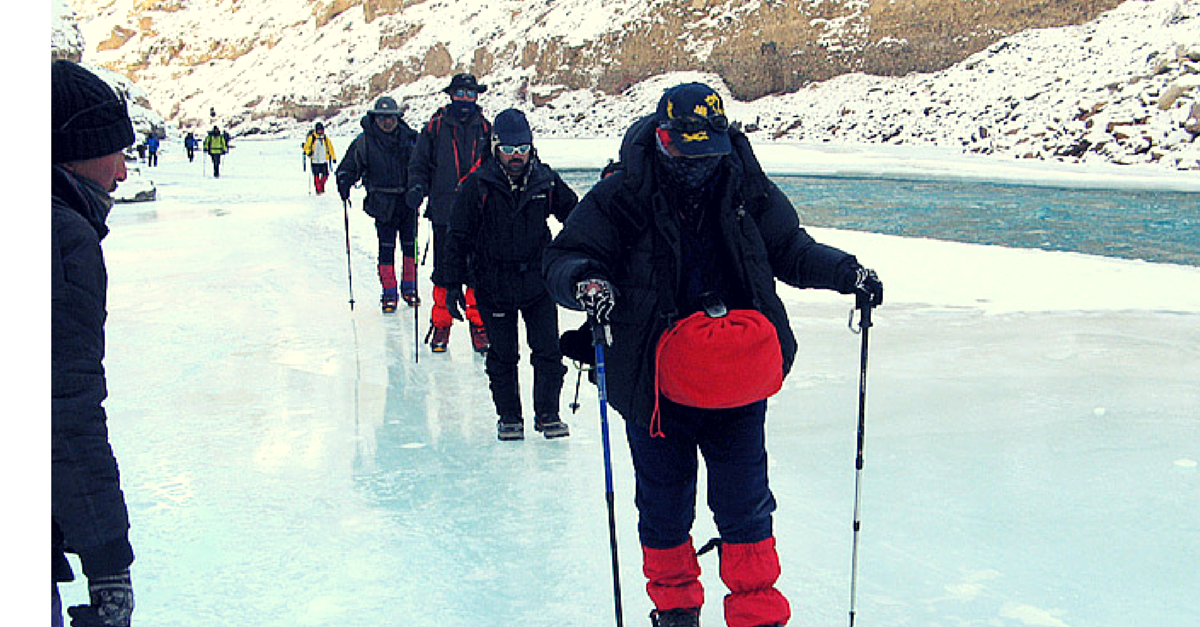
Planning to explore the adventurous and beautiful Chadar trek in Ladakh? Here is all you need to know before you pack your bags. From what to see to what not to do, here is your one stop guide to follow.
“T he ultimate measure of a man is not where he stands in moments of comfort and convenience, but where he stands at times of challenge and controversy. ”
-Martin Luther King, Jr. One of the most stunning and exhilarating winter treks across the blue planet, the Chadar Trek is a thrilling expedition over the frozen Zanskar River. The trail provides an excellent opportunity to explore the ancient culture of Zanskar, which is a blend of Tibetan and Indian cultures. In addition to this, a trekker can also spot some exotic wildlife species such as blue sheep, snow leopard and ibex that can be found in the frozen surroundings. But before you start planning for the next winter, let’s have an in-depth exploration of the Chadar Trek and tips to carry out a successful expedition.
Chadar Trek: Few Forewords
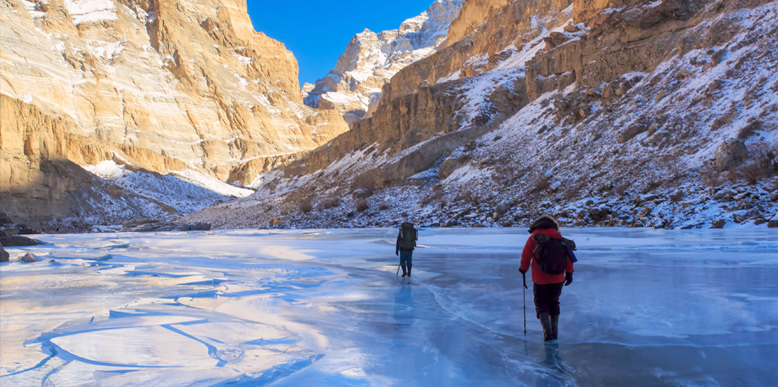
During the winter season, the Zanskar River freezes and appears like a sheet ( chadar ) of ice. This trek is popularly known as the Frozen River Trek. It is considered one of the toughest treks in India.
During the trek, one has to cover approximately 105 kilometers on foot. The mercury count is -15 to -20 degrees in the daytime while it dips to -25 degrees during the night. Most of the trek has to be completed by walking. Moreover, the trekkers even have to hike over icy boulders during the journey. The excursion includes walking on the sheet of ice during the day and staying in the caves during night.
Why should you go on the Chadar Trek?
One of the most popular trekking destinations in India , the Chadar Trek is not merely an expedition. This trek is undoubtedly a way to rejuvenate oneself and get relief from the hustle and bustle of daily life. Success in this strenuous trek offers the trekkers a sense of satisfaction and exhilaration that can be compared to none. The adventure enthusiasts can tread through bone-chilling climate and spell-binding panorama.
Any trekker who is an ardent adventurer and ready to encounter the harshest conditions cannot afford to miss the Frozen River Trek. The high spirits that can be felt by traversing through the snowy boulders is beyond words. However, caution needs to be practiced before anyone can embark on this arduous trek, and a few pointers need to be kept in mind.
Difficulties that you may encounter
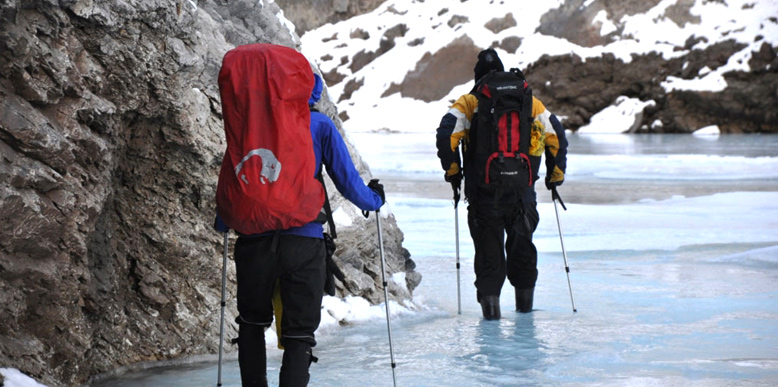
The major difficulty of the Chadar Trek is of getting accustomed to the harsh climate conditions at an altitude of around 13,000 feet above sea level. The long and strenuous journey can cause exhaustion in the trekkers and thus, there is a need of high endurance and expertise. Proper stamina and ability is something that is non-negotiable when embarking on the Chadar Trek.
Some important tips for the Chadar Trek
As the trek requires courage for facing the thrills, there are some certain do’s and don’ts that a trekker must consider. Below-mentioned are some of the do’s and don’ts of Chadar Trek:
What to do on the Chadar Trek
- Let a friend or family member know about your schedule. This way, someone can come for your help in case of any emergency.
- Keep warm clothes with you as the temperature can plunge extensively.
- There can be a scarcity of food and water during the trail. Thus you must keep sufficient edibles and water with you.
- Never forget to bring a first-aid kit and medicines as the trek is demanding and getting bruises and cuts is very common.
What not to do on the Chadar Trek
- Do not litter anywhere and spoil the radiance of the route. The trail holds a gripping panorama and it is the responsibility of every trekker to maintain it.
- Do not use soaps and shampoos in waterfalls as it contaminates them. Moreover, the local inhabitants use this water for drinking purpose; thus you should keep it clean.
- Respect the tranquility of the shrines that fall en route.
- Never disregard the tips and guidelines provided by the guide.
- Never skip a meal as there is a requirement of high energy.
- Do not overlook the weather report.
What are the major destinations covered in Chadar Trek?

The prominent regions that fall en route Chadar Trek are:
Tilat Sumdo – Tilat Sumdo acts as a campsite for Chadar Trek. ‘Sumdo’ literally means ‘the confluence’. There is a small stream meeting the Zanskar at this point. Tilat Sumdo offers splendid vistas of the Himalayan Range.
Shinra Koma – Positioned about 10 kilometers away from Tilat Sumdo, Shingra Koma is a scenic spot showcasing rustic beauty that simply spellbinds the travelers. Shingra Koma is a place with unsurpassed tranquility and a mesmerizing panorama.
Tibb – Tibb is a picturesque place offering a fascinating waterfall and cave. This Tibb cave is also used for overnight stay by the trekkers. The vistas of sun-kissed mountains from Tibb are an enchanting sight to witness
Nerak – Nerak serves as a base camp for the trek. The view of sunset from Nerak is so gripping that an avid adventurer cannot afford to miss it. This region is sheer bliss for a nature lover’s eyes.
Gyalpo – Gyalpo is an enchanting campsite positioned at a bend in the Zanskar River. This region is flanked by imposing peaks and walls of rock faces that look man-made. The tourists can soak themselves in the surreal natural beauty here.
Dibyokma – Dibyokma is a campsite that offers dream-like panoramas including breathtaking views of the Himalayas. The serene and intact environment of Dibyokma makes tourists fall in love with this place.
Lingshed – One of the oldest villages in Ladakh, Lingshed boasts awe-inspiring exquisiteness of nature. This region is prominently famous for the Lingshed Monastery, which is one of the oldest monasteries in Ladakh as well.
What is the best time for Chadar Trek?
The winter months of January and February are the best for trekking on the Frozen Zanskar River. Typically, mid-January to end-February is when most groups carry out trekking in the Chadar Trek.
There ample reasons for a trekker to embark on this adventure. The trek is certainly all about savoring thrill in its rawest form, as long as caution is heeded.
Like this story? Or have something to share? Write to us: [email protected] , or connect with us on Facebook and Twitter (@thebetterindia) .
If you found our stories insightful, informative, or even just enjoyable, we invite you to consider making a voluntary payment to support the work we do at The Better India. Your contribution helps us continue producing quality content that educates, inspires, and drives positive change.
Choose one of the payment options below for your contribution-
By paying for the stories you value, you directly contribute to sustaining our efforts focused on making a difference in the world. Together, let’s ensure that impactful stories continue to be told and shared, enriching lives and communities alike.
Thank you for your support. Here are some frequently asked questions you might find helpful to know why you are contributing?

Sounds Interesting? Share it now!
This story made me
Tell Us More


Adventure Pulse
Feel the Pulse of Adventure !!
- High Altitude Treks
- One Day Treks
Chadar Trek Guide: Walking in -30°C on the Frozen River Trek
- posted on March 31, 2020 April 26, 2021
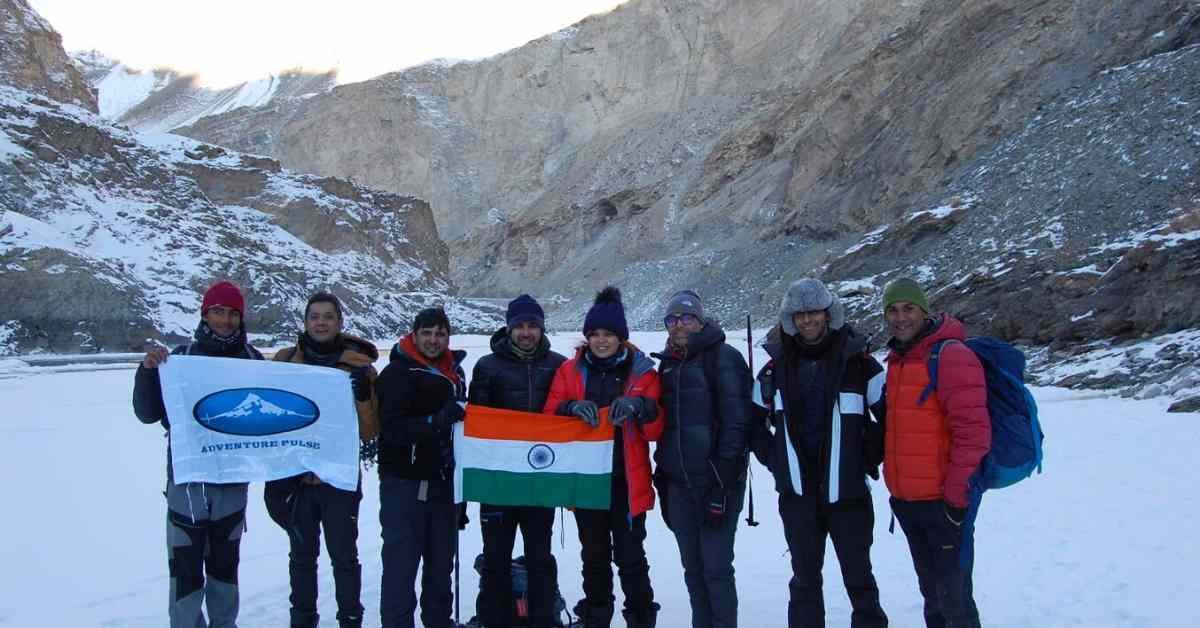
1. How Difficult is the Chadar trek
2. can beginners do the chadar trek.

3. What are the stay arrangements on the Chadar trek
4. why do we recommend the chadar trek as “must do “ for all nature lovers, share this:, « the gokyo ri trek: an awakening with the mountains., the andharban trek in maharashtra: an abundance of nature ».
Sauraj Jhingan
A qualified mountaineer from the prestigious Nehru Institute of mountaineering, Sauraj Jhingan, brings with him, tremendous Human Resource experience, having worked in diverse business verticals, such as ITES, IT and Standard Chartered Bank.
Leave A Comment Cancel reply
Post Comment
Quick Links
- Registration Form
- Upcoming Events
- Our Everest Story
- Media Coverage
WANT TO SHARE YOUR TREKKING EXPERIENCE?
We at Adventure Pulse love to hear your trekking stories, especially the outrageous ones. If you have a trekking story, send it to us at [email protected] as a blog or photo blog and we’ll be happy to publish it on our website. HAPPY TREKKING!
Chadar Trek
🗓 Best Time To Visit: January to February
⏰ Open Hours: N/A
🏞 Things To Do: Trekking, Photography, Camping, Nature Walks
💰 Budget: INR 15,000 - 25,000 per person
🧳 Traveller Types: Adventure Seekers, Nature Lovers, Photographers
🔍 Known For: Unique frozen river trek, Beautiful landscapes, Leh Palace, Zanskar River
📍 Distances: Leh Airport - 9 km, Srinagar Railway Station - 421 km, Leh Town - 5 km
🥾 Trek Difficulty: Moderate to Difficult
🧣 Essential Gears: Thermal Clothes, Trekking Shoes, Trekking Pole, Sunglasses, Sunscreen, Medicines
📜 Permit: Mandatory Ladakh Autonomous Hill Development Council (LAHDC) permit
🔺 Altitude: 3,850 meters
Have you ever dreamed of walking on a frozen river, surrounded by snow-capped mountains and stunning scenery? If yes, then you should definitely try the chadar trek, one of the most unique and adventurous treks in the world. The chadar trek is a winter trek that takes you along the frozen Zanskar river in Ladakh, a region in the northern part of India. The chadar trek is not for the faint-hearted, as it involves braving the extreme cold, the slippery ice, the unpredictable weather, and the remote wilderness. But if you are up for the challenge, the chadar trek will reward you with an unforgettable experience, a sense of achievement, and a glimpse into the culture and lifestyle of the local people who have been using this route for centuries.
In this article, we will tell you everything you need to know about the chadar trek, from what it is, why you should do it, how to reach it, when to go, what to expect, what to prepare, and how to book it.
What is Chadar Trek?
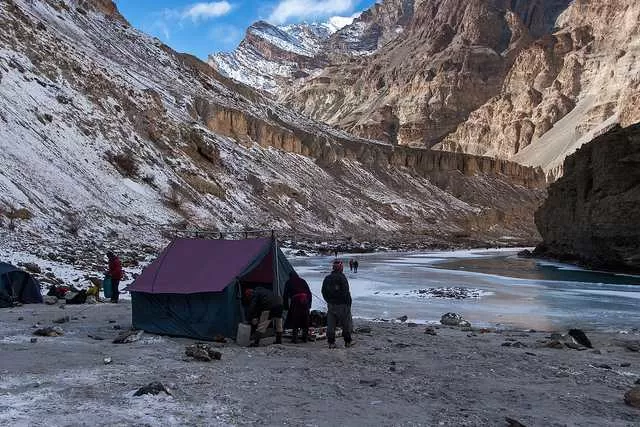
The word chadar means blanket in Hindi, and it refers to the thick layer of ice that covers the Zanskar river during the winter months. The Zanskar river is a tributary of the Indus river, and it flows through a deep and narrow gorge in the Zanskar valley, which is part of the Greater Himalayas. The chadar trek is a trek that follows the frozen river for about 105 km, from Chilling to Naerak and back. The chadar trek is also known as the frozen river trek or the Zanskar trek. The chadar trek is one of the oldest and most traditional routes in Ladakh, as it was used by the local people, especially the Zanskari people, to trade and communicate with the outside world when the road access was blocked by snow.
Why Chadar Trek?
The chadar trek is not just a trek, it is an adventure, a challenge, and a learning experience. Here are some of the reasons why you should do the chadar trek:
1. The chadar trek is a unique and rare trek, as it is one of the few places in the world where you can walk on a frozen river. The chadar trek is also a seasonal and unpredictable trek , as it depends on the weather and the river conditions, which can change anytime. The chadar trek is also a dynamic and diverse trek, as it offers different landscapes, terrains, and views, depending on the time of the day, the angle of the sun, and the thickness of the ice.
2. The chadar trek is a thrilling and exciting trek, as it involves walking, sliding, crawling , and sometimes even swimming on the frozen river. The chadar trek is also a challenging and demanding trek, as it requires a high level of fitness, stamina, endurance, and mental strength. The chadar trek is also a risky and adventurous trek, as it exposes you to the extreme cold, the slippery ice, the unpredictable weather, and the remote wilderness.
3. The chadar trek is a cultural and educational trek, as it introduces you to the culture and lifestyle of the local people , especially the Zanskari people, who have been living in this harsh and isolated environment for centuries. The chadar trek is also a spiritual and inspirational trek, as it passes by many ancient and sacred sites, such as monasteries, shrines, and caves, that are revered by the Buddhists. The chadar trek is also a social and fun trek, as it allows you to meet and interact with other trekkers, guides, porters, and locals, who share your passion and enthusiasm for the chadar trek.
Best Time to Go for Chadar Trek
The best time to go for the chadar trek is from mid-January to mid-February , when the Zanskar river is frozen enough to support the weight of the trekkers. The chadar trek is not possible before or after this period, as the river is either too thin or too thick to walk on. The chadar trek is also not possible during the summer months, when the river is flowing and not frozen.
The best time to go for the chadar trek also depends on the weather, the river condition, the availability, and the preference of the trekkers. The weather in Ladakh during the winter months is very cold, dry, and windy, with temperatures ranging from -5°C to -25°C.
How to Reach Chadar Trek
The chadar trek starts and ends at Chilling , a small village in the Zanskar valley, which is about 65 km from Leh, the capital of Ladakh. To reach the chadar trek, you need to first reach Leh, and then take a taxi or a bus to Chilling. To reach Leh, you have two options: by air or by road.
By air , you can take a flight from Delhi, Mumbai, Bangalore, or other major cities in India, to Leh, which is the nearest airport to the chadar trek.
By road , you can take a bus or a car from Manali, Srinagar, or other nearby towns in Himachal Pradesh or Jammu and Kashmir, to Leh, which is the nearest road head to the chadar trek. The road distance is about 475 km from Manali, and about 420 km from Srinagar, and the road duration is about two days, with a night halt at Keylong or Kargil, respectively.
The best way to reach the chadar trek is by air, as it is faster, easier, and more reliable than by road. However, you need to be prepared for any changes or cancellations, and acclimatize yourself to the high altitude and low oxygen level in Leh, before starting the chadar trek.
The chadar trek is a unique and adventurous trek that takes you along the frozen Zanskar river in Ladakh, a region in the northern part of India. The chadar trek is a winter trek that is only possible for a few weeks in the year, when the river is frozen enough to support the weight of the trekkers.
The chadar trek is a challenging and rewarding trek that requires a high level of fitness, stamina, endurance, and mental strength. The chadar trek is also a cultural and spiritual trek that introduces you to the culture and lifestyle of the local people, especially the Zanskari people, who have been using this route for centuries.
The chadar trek is also a scenic and beautiful trek that showcases the natural beauty and splendor of the Zanskar valley, the Himalayas, and the Ladakh region. The chadar trek is a once-in-a-lifetime opportunity, as it is threatened by the effects of climate change, global warming, and tourism, which may alter or melt the ice in the future.
Chadar Trek Reviews
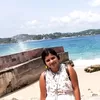
Places To Visit In Leh Ladakh
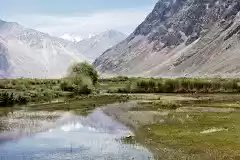
Travel Blogs for Chadar Trek - Trekking In Ladakh - Frozen River Trekking In Ladakh
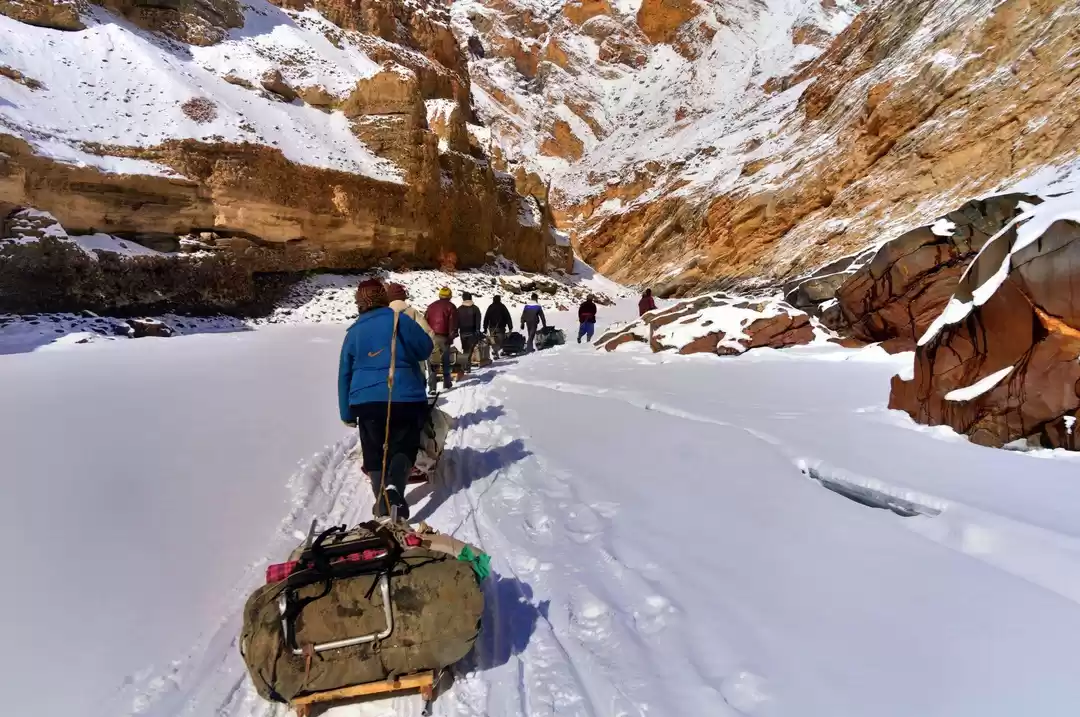
- Group Enquiry? NEW
- A Complete Guide to Chadar Trek
- Jammu And Kashmir
Guide to Chadar Trek, one of the most adventurous and thrilling treks in the world, offers the best chance to explore a whole new world in the Zanskar Valley. This Guide will help the trekkers to beat all the challenges while trekking through the frozen Zanskar River, unfolding the mystery of the Himalayas.Embark on this unforgettable adventure as part of your Leh Ladakh holiday packages .
The lower sections of this gorge are extremely popular in summers with tourists trooping in for river rafting expeditions. In winters the Zanskar River freezes and trekking enthusiasts flock to this region to enjoy hiking expeditions.
During the winters, the road to Zanskar Valley is closed due to snowfall and this makes the frozen river the only way to access the valley. The trek across the frozen river is called the ‘Chadar’ (ice sheet) trek and it holds many surprises and scenes of breathtaking beauty, which attracts tourists and trekkers from all over the country and the world.
Quick Navigation
What is chadar trek.
The Zanskar River freezes in the winters. The entire river looks like a sheet of ice and hence is referred to, in the local language, as Chadar. From a tourism point of view, this trek has been popularized as the frozen river expedition and draws in several amateur and professional trekkers from different parts of the country and the world.
Chadar trek in the beautiful landscape of Ladakh is one of the most adventurous and most difficult treks in the country. The distance that is covered on foot is approximately 105 km and on an average, a trekker covers 15 to 17 km every day. The temperatures are usually 15 to 20 degrees during the day time and plummet to -25 to -35 degrees during the night in this region.
As per the chadar trek guide, while most of the trek is completed by walking, trekkers may even have to climb icy rocks and boulders during the journey. During the journey, the trekkers will walk on the sheet of ice to cover the distance and will rest in caves during the night time.
Due to the extremely cold conditions that a person has to face during this expedition, it is advisable that every aspirant fully understands the conditions that he will face ahead and prepare accordingly. A person should be acquainted with walking long distances and be prepared for tough camping situations. It is advisable that every trekker carries warm clothes, a sleeping bag and sturdy shoes for the trek.
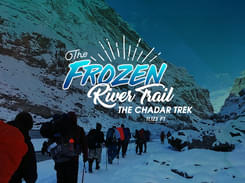
Best Offers on Himalayan Treks: Enquire Now
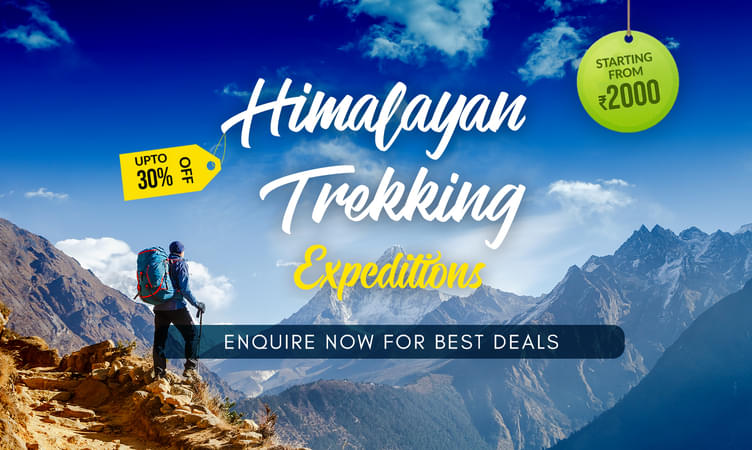
Why Chadar Trek?
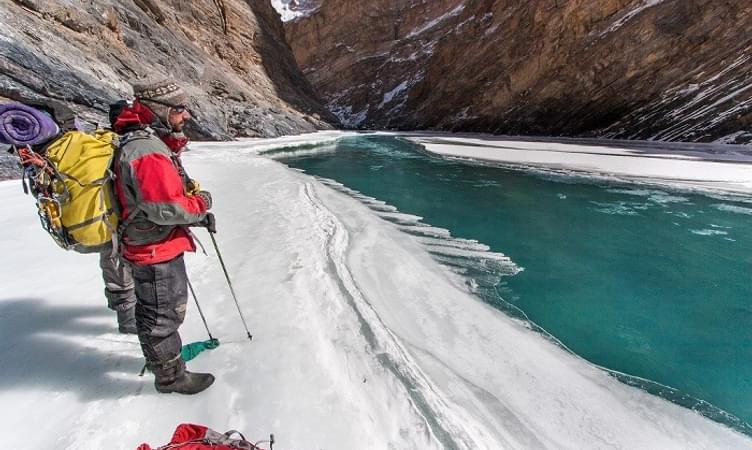
For adventure enthusiasts, trekking is not just an expedition. Trekking is a mode to relieve oneself of the worries of day to day life, revive the spirit of adventure and excitement by undertaking tough challenges and winning them. This trek is not just any other trekking experience.
Trekkers have to face the toughest of challenges, tread through chilly weather and landscape and sleep in caves during this expedition. According to the chadar trek guide, this trek holds the secrets of the beautiful Himalayas and enables a person to enjoy the mesmeric beauty of the snow-clad mountains and beautiful city of Leh.
For every person who seeks adventure and is ready to face the harshest conditions and take up the most challenging tasks, this Guide to Chadar Trek is a must. The excitement of walking on ice and climbing on icy rocks is unbeatable and matchless. This trek is an absolute must-do for those who have a flair for high altitude trekking and taking on challenges as they come in life.
When is the Best Time?
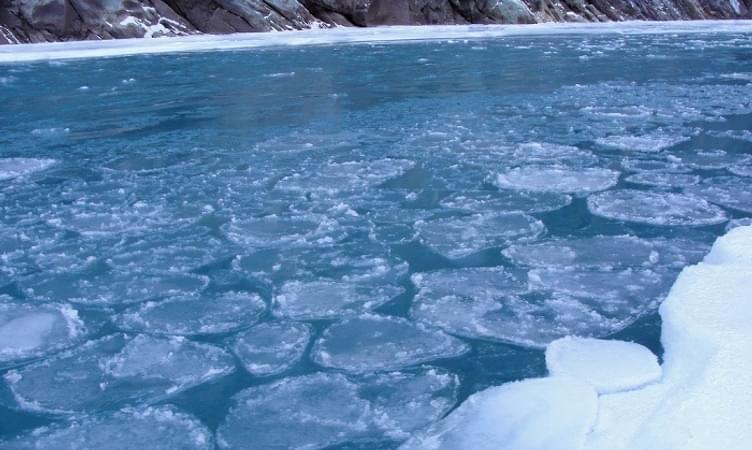
The best time to take the trek is in January and February. Precisely, from January 15 to the end of February is just the right time to set out on this wonderful and adventurous trek. The river freezes into a beautiful sheet of ice and the surroundings are clad in snow presenting a pristine white trail for hiking expeditions.
The snow clad mountain peaks that will accompany you all along your way to your destination glisten and gleam in the morning rays of the Sun. This is a breathtaking view to watch and the trek is incomplete without being able to enjoy such mesmeric beauty.
The beauty of the landscape is the most rewarding part of the trek. Although the trek itself is quite arduous and tasking, the beauty that opens up before the trekkers compensates for the all the trouble and effort put in.
The frozen river trek is the most rewarding trekking trails in the country and will test your physical stamina and mental focus before opening up its secrets to you. Although the summers attract a large number of water sports enthusiasts from all over the country, this trek in the winters still remains the most popular activity in Leh.
How Difficult is Chadar Trek?

As per the Chadar trek guide, this trek is one of the most difficult and challenging treks in the country . The Zanskar River freezes into a sheet of ice and is the only route to access the Zanskar Valley during the winters. All mountain passes are shut down due to snowfall, leaving the Chadar or the frozen Zanskar River as the only route for passage.
The ideal or best time for this trek is in the months of January and February as the swift river is harnessed in the bounds of blocks of ice and the surroundings are all covered in the pristine white beauty of snow. The temperatures are incredibly low during the day time and plummet to uncomfortably freezing temperatures during the night time. Trekkers who want to explore the Zanskar trek must be prepared for facing unsettling temperatures and harsh camping conditions. The total distance covered in the trek is around 105 km, most of which is covered on foot. There might also be instances wherein the trekkers are required to climb icy rocks and boulders. The nights are spent in caves near the frozen river and hence all participants should come prepared with the warmest jackets, sleeping bags and sturdy shoes. The camping conditions, unlike in other trekking expeditions, are extremely tough and hence each participant should be mentally and physically prepared for the challenges ahead.
How Cold Does it Get?
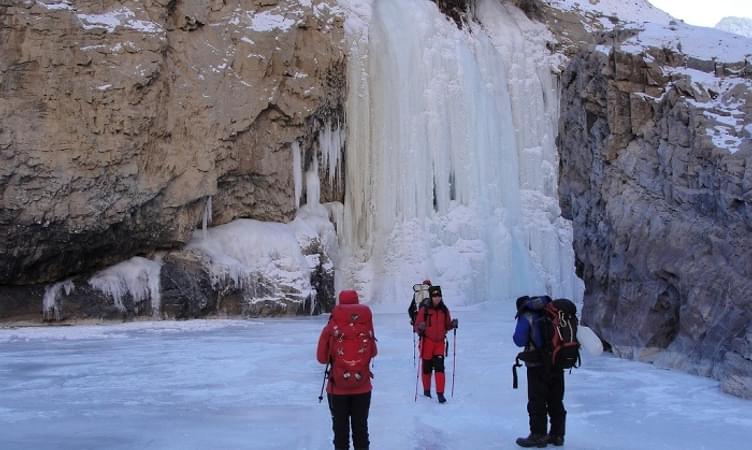
The Chadar trek expedition is conducted in the winters. The best time to set out on this expedition is in January and February. The swift and steady River Zanskar lies harnessed in bindings of ice and everything around is covered in pristine white snow.
The temperatures are amazingly low during the day time and hover between 15 to 20 degrees while they plummet further to -25 to -35 degrees during the night time. The climatic conditions of this region are quite harsh and extremely cold. So for any visitor who wishes to explore the Zanskar trek, it is extremely important that he is physically and mentally prepared for the trek
The total distance covered during the trek is around 105 km and most of it is covered by walking through these extreme conditions. You may also be required to climb icy rocks and boulders during the journey which makes it extremely essential for you to be physically and mentally fit.
The journey is arduous and tasking, especially because of the extremely cold temperatures. Furthermore, while during the day time you will have to walk over the chilly sheet of ice or the frozen Zanskar River, during the night time, you will have to sleep in caves near the frozen river.
How Long Do We Walk Each Day During the Trek?

The total distance covered along the trek is 105 km. Trekkers will be required to walk around 15 to 17 km a day to complete the trek. The trail is along the frozen River Zanskar which lies harnessed and bound in its icy bindings and the snow-clad surroundings are a treat to watch.
The most rewarding aspect of this tough and challenging trek is that it rewards everyone with the secrets hidden in the snow-covered slopes of the Himalayas and opens up a vista of breathtaking Himalayan beauty to its visitors. During this guide to the Chadar trek, you will be required to walk along the length of the frozen River Zanskar and also, at times, climb icy rocks and boulders.
The temperatures are unsettlingly low and every aspirant must be physically and mentally prepared for the tough camping conditions. The Chadar is the only connecting route during winters into the Zanskar Valley and the Ladakhis and Zanskaris use this route twice a year. The climatic conditions may not be exactly favorable but the adventure and challenges that the trek has in store for the adventurous make it one of the most popular high altitude trekking trails in the country.
Most of the journey is covered on foot by walking on the pristine white solid sheet of ice and a little bit of climbing and maneuvering. The nights are spent in chilly caves near the frozen river, which makes it mandatory for every trekker to carry along the warmest of jackets, sleeping bags, and sturdy yet warm shoes.
Trek Itinerary

The journey begins at New Delhi from where participants interested in the Chadar Trek will be transported to Leh. This is followed by a visit to nearby monasteries or any local festivals that are happening at the time.
On the third day you will be taken on a full day tour of Phyang, Liker and Alchi for sightseeing.
On day four, you will proceed from Leh to Chilling to Zaribago and cover the distance over five hours of trekking. You will spend the night in a camp at Zaribago and proceed for the next destination in the morning. On the fifth day, you will move from Zaribago to Deepyokma which is a four hour trek on foot.
The evening is spent in Deepyokma and the next morning i.e. on the sixth day you will trek to Nyrakpulu. This distance is covered in four or five hours of trekking. The next morning you will trek for one hour from Nyrakpulu to Lingshed. You will spend the eight day in Linghshed relaxing, sightseeing and preparing for the next day’s trip.
From Linghshed you start trekking on the Chadar. On the ninth day, you will trek through the icy surroundings of Linghshed. After spending a day in the beautiful environs of the Himalayas and the mystical Zanskar River, you trek on for four hours to Tsomopaldar.
The next day i.e, on the 11th day you move from Tsomopaldar to Tilatdo in a five hour trek. On day 12, you undertake a five hour trek from Titado to Chilling. On day 13, you are transported back from Leh to New Delhi . The entire journey is of 13 days and is one of the most amazing experiences that you can have.
How Big are the Groups?
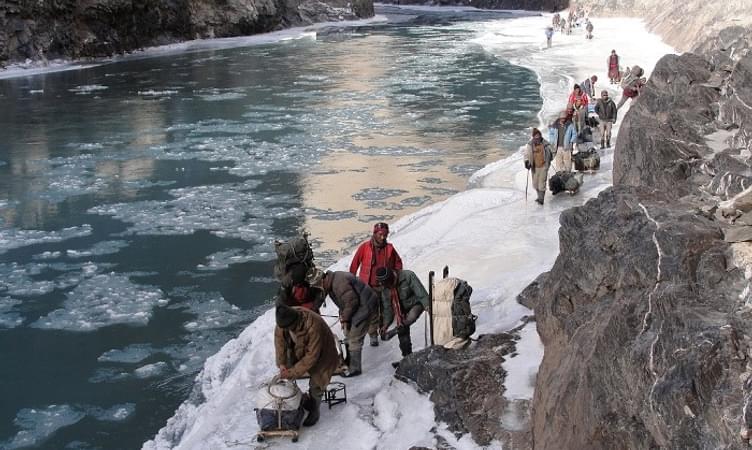
Ladakh Trekking with a group of friends is definitely an enjoyable experience. You can set out on this expedition with your friends, colleagues or family. Usually, at least six persons are required for the expedition. However, as many as 15 or 18 persons can be included in the group. Usually, a large group does not exceed this number.
The objective of keeping the groups relatively small is to ensure good management and also make sure that all guests have a wonderful and memorable experience. Usually, the groups consist of like-minded people who can enjoy and relish the beauty of the region in spite of the harsh conditions.
The groups usually consist of both men and women. To ensure the safety of women during the trek, the guides and other support crew are carefully selected for the trips. The trek is usually led on by a professional trekker who has completed the basic and advanced mountaineering course and certified in the first-aid course.
The team will be accompanied by a local guide, a cook, a helper, a porter and other staff. Complete care is taken to ensure the comfort and safety of all participants during the arduous trek on the frozen Zanskaar River.
Accommodation Arrangement for the Trekkers

In the mainland, all accommodation is made in A Class hotels with all meals included in the package. Comfortable accommodation will be arranged for trekkers. Usually tents are used while camping and persons are generally accommodated in a two man tent. However, due to the harsh and extremely cold climate, trekkers are advised to get some essential items such as steam crossing sandals, insulating fleece jacket, rain proof jackets, insulating gloves, warm sleeping bags etc to protect themselves.
During the trek on the Chadar, the campsites will be set up in caves in the area and hence having all these warm clothes and items is mandatory. Before setting out for the trip, every participant must be fully aware of the conditions that he will have to face during the trek and prepare accordingly.
During the Chadar trek, care will be taken to ensure safety of all participants. However, trekkers will also have to take a few measures for their own safety and health. The trek is usually conducted in groups of at least six persons and is led by a professional trekker who has completed his Basic and Advanced Mountaineering course.
In addition, these lead trekkers are also certified in Wilderness ‘First Aid’ in order to ensure quick medical help during the expedition. Furthermore, other staff such as porters, cooks, helpers and local guides is also sent along on the expedition to ensure successful and fruitful completion of the trip.Trekkers can also enjoy bike trip to Srinagar .
Type of Food Being Served
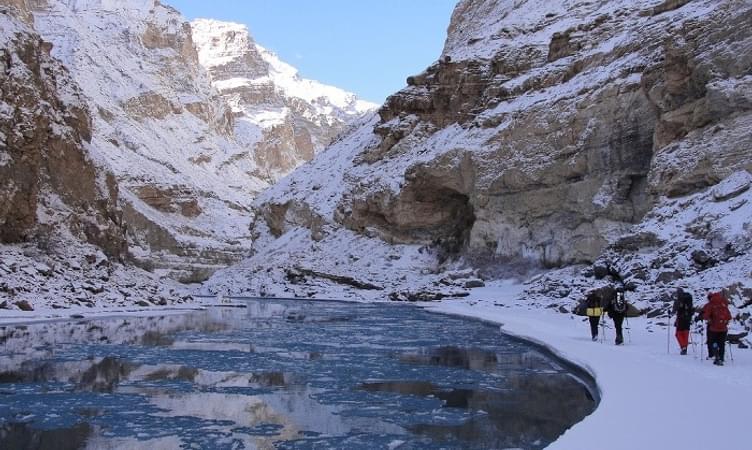
The food that is served during the expedition is decided and cooked carefully. Usually Indian vegetarian dishes and egg dishes are served during the trek. It is important that the dietary needs of the participants are met during the duration of the trek. The climatic conditions of the region are very extreme and different from those in the mainlands.
So in order to keep all trekkers in good health and energised for the journey ahead, well cooked vegetables and eggs are provided in order to keep them fit and healthy for the journey. Hygiene and safety are a priority during the trek and especially while cooking the food. So utmost care is taken while preparing the food for the guests.
The trek covers a journey of about 105 km and most of the distance is covered on foot. For this reason, it is very important that is no mistake or shortcoming in meeting the dietary needs of the trekkers. So a high protein content diet is chosen for the trekkers and this is met by choosing the best vegetables and eggs.
The trek is extremely tough and occasionally requires climbing on icy rocks and boulders. Furthermore, the temperatures of the region hover between 15 to 20 degrees during the day time and -25 to -35 degrees in the night time, which makes it essential for the trekkers to remain energised and high on metabolic heat. Camping in Ladakh will also be one of the perks of this trekks.
How to Get Safe Drinking Water During the Trek?
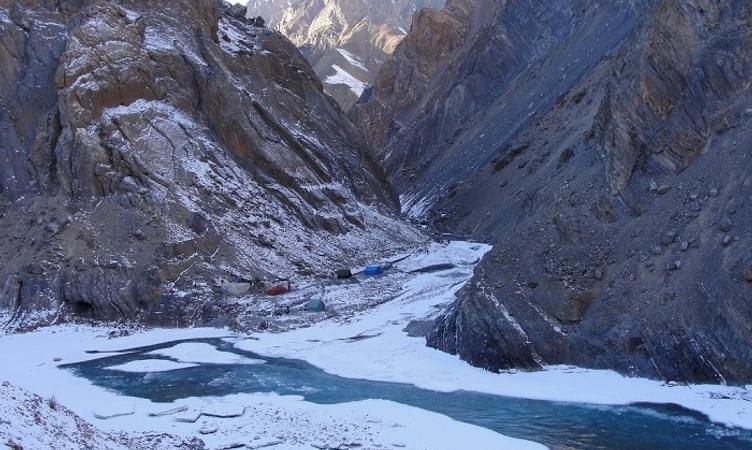
Himalayan water is generally considered safe and pure enough to be consumed directly. However, since the participants or trekkers are from different parts of the country, it is advisable to check with the lead trekker about filling stations. Usually, during the trek, water from the region is purified by boiling with chlorine tablets and then made available for drinking.
It is always best to check with the lead trainer about such arrangements before you start trekking and understand his plan of action. Do not consume water from any source without first checking with your leader. As the region would be new to you, it is always best to consult someone who is well-acquainted with the region.
The journey begins from Chilling in Leh and continues till you reach the Chadar. The distance is about 105 km and the temperatures will vary from 20 degrees to -25 degrees. It is essential that you carry warm sleeping bags, sturdy shoes and warm jackets with you in order to face the harsh conditions of the region.
The frozen river trek does sound difficult but it is one of the most enjoyable and adventurous trekking expeditions you can have in India. With the gain in altitude, the temperatures drop dramatically and blankets of white snow greet you into the mystical land of the Himalayas. To stay safe and fit for the journey, prepare yourself mentally and physically and arrange for all supplies beforehand.
Ground Transportation
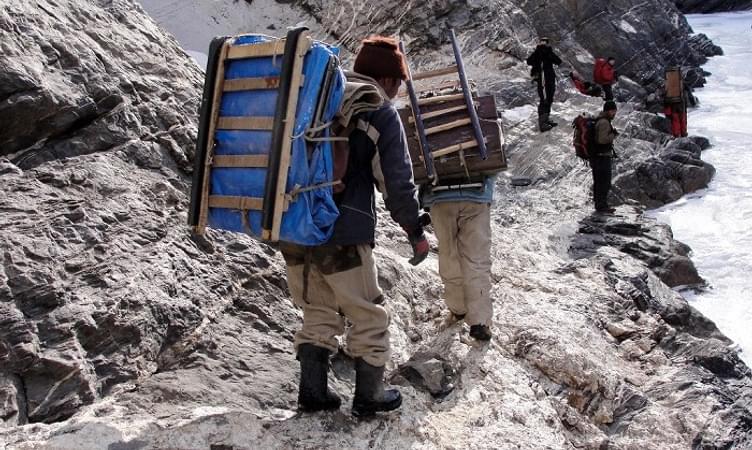
Your journey to the trek will begin from Leh. All ground transportation is done in the best of vehicles that suit the terrain. You will be taken from your source in Toyota Qualis, an Innova or a Scorpio. These vehicles are the best to travel in this rugged region and hence these vehicles are used for all ground transportation of guests. Special care is taken that all guests have a comfortable transportation before the trek begins so as to ensure that they are not worn out or tired before the trek begins.
The journey into the beautiful Himalayan ranges is one of the most sought after experiences among trekkers all around the globe. The mysteries of the Zanskar Valley and the snow clad Himalayas have time and again attracted professional and amateur trekkers and mountaineers from all over the world.
The trekking expedition into the Chadar is one of the toughest and most challenging trails in the country. Nevertheless, more and more trekkers participate in the this trek every year before of the spectacular beauty of the Himalayas that can be enjoyed during the trek.
The Ladakh trek begins from Chilling and continues till the beautiful white blanket of snow which is actually the River Zanskar in a frozen state. The trek involves long distance walking and trekking and hence it is essential for the participants to be fit and healthy. Also the temperatures of the region are incredibly low which make it mandatory for every trekker to carry warm clothes and supplements.
Medical Evacuations/Emergencies
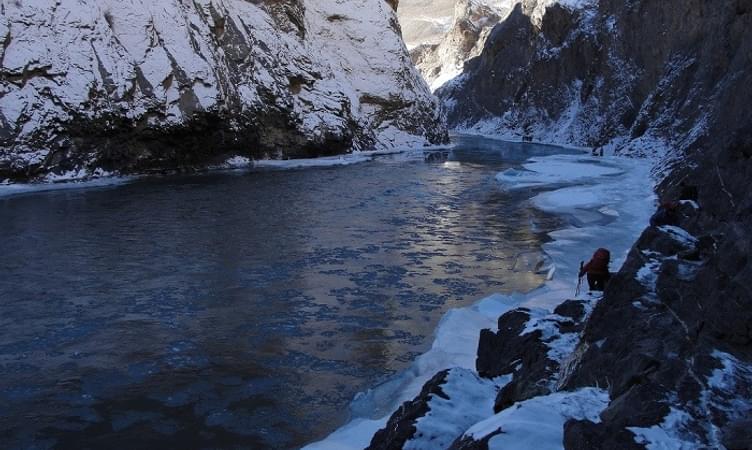
Safety is a priority during trekking trips and Thrillophilia takes measures to ensure that all its guests can enjoy the trip in safety. Although there will be no doctors accompanying the troupe that goes out on the expedition, the lead trekker is usually trained in Wilderness First Aid course, which ensures that primary medical aid is always at hand.
Furthermore, the lead trekker is trained in the basic and advanced courses of mountaineering and trekking and he ensures that all safety guidelines are followed and all trekkers are able to enjoy the beauty of the region by avoiding untoward incidents.
In case you are on any kind of medication or undergoing treatment, consult your physician before deciding to set out on this expedition. Although the beauty and charm of the Himalayan ranges are almost impossible to resist, it is important that you are physically and medically fit for the expedition.
If you need personal trail medications, carry them with you. If you are in doubt about your fitness level for the expedition, consult your physician or a professional trekker for advice. It is important that you gauge your fitness level well ahead and plan your expedition accordingly. If you are declared unfit, do not venture out for the expedition.You must be well aware of Ladakh Weather to avoid medical emergencies.
Other Facts You Should Know
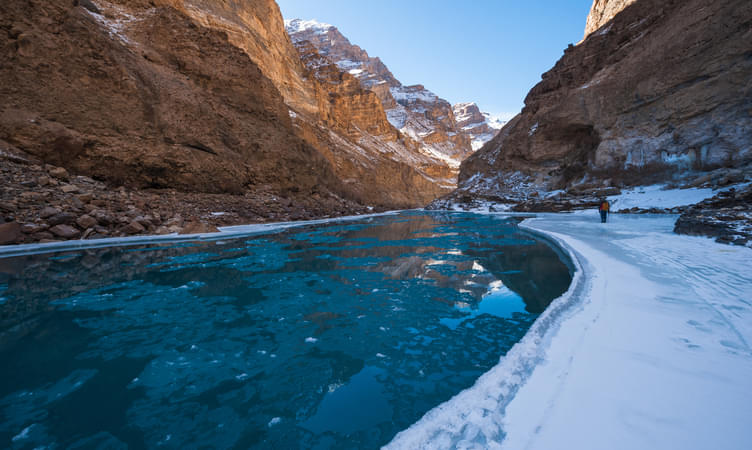
This trek is one of the toughest and most challenging treks in the Himalayan region. The frozen Zanskar River is the only means of communication for the Ladakhis and the Zanskaris in winters. This route is popularly used by trekking enthusiasts in the winters. However, this route will soon be shut down after the road from Chilling to Padum is completed.There are lot of Ladakh tours you can choose from us.
Things You Must Carry
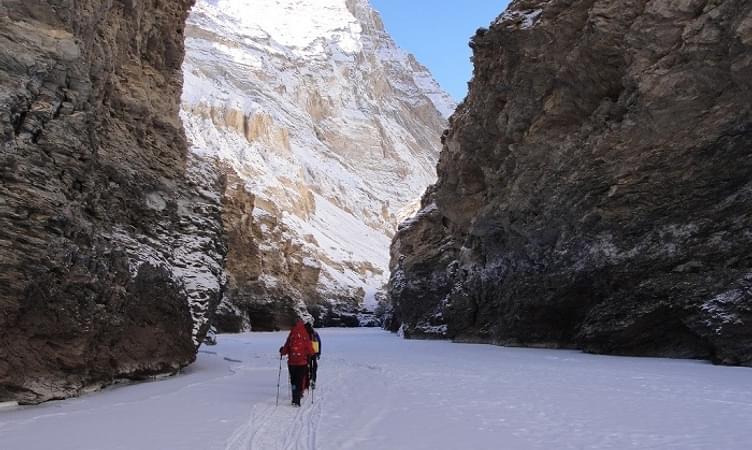
Thrillophilia arranges for ground transportation, accommodation, tents, kitchen and dining tents, kitchen equipments, stools, tables and mattresses, food (vegetarian and non-vegetarian items), cooks, helpers, porters and guides. Furthermore, Thrillophilia will also include the charges of monument entrances, wild life fees and camping charges in your registration fees.
Apart from all this, you will have to carry with you-
In case you do not already own these things, you can hire it from Thrillophilia. You can rent sleeping bags, trekking shoes and clothing etc. The package charges do not include the cost of any kinds of personal expenses such as tips, insurance, laundry and phone call charges, any kinds of beverages or any other cost incidental to any change in the itinerary.
While setting out for the trek, it is essential that you are dressed in long sleeve, hiking shirt; long quick dry hiking pants. You can also carry a hat with a retention cord on windy days.
Your duffel bag can carry your sleeping bag, your complete set of spare clothing, long and regular underwear, inner and outer socks, a pair of fleece sweaters, insulating hats, a pair of running shoes, your toilet kit, your toothbrush, soap, towel etc.
Fitness Required
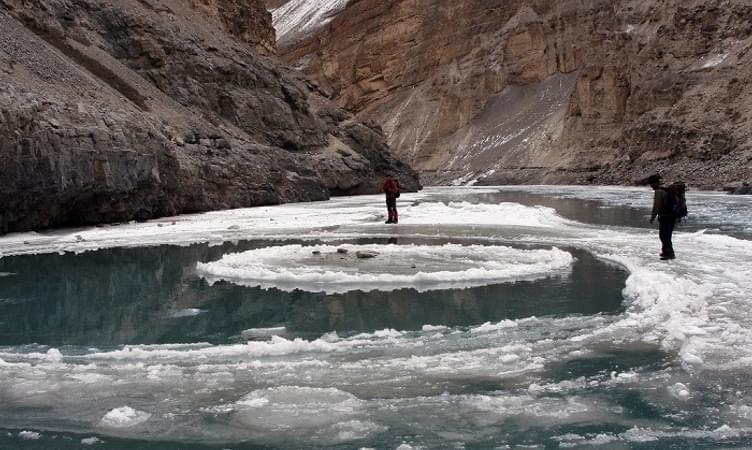
The trek to Chadar is extremely arduous and tasking. Not only does it test your physical stamina but also your medical health. It is essential that you are in the best of health before you set out for this expedition. Usually, the lead trekker is a trained professional in the basic and advanced courses of trekking and mountaineering and also trained in Wilderness first aid.
But to avoid any critical or untoward situation in terms of health and fitness, it is best that you consult a professional or a physician and get yourself checked before participating in the Chadar trek. In case you are on medications, make sure you carry your medicines with you while venturing out for the trek.
The climatic conditions that trekkers have to face during a trip to Chadar are extremely harsh and cold. It is essential that you are physically and medically fit to take up this challenge. The temperatures hover between 15 and 20 degrees during the day time and between -25 and-35 degrees during the night. The nights are usually spent in caves near the frozen Zanskar River in extremely cold conditions.
Hence, it is mandatory that you understand the challenges that lie before you completely and fully before stepping out for the expedition and prepare yourself accordingly. Carry warm clothes, warm bedding and food supplements to keep you energised during the trek. Also, carry chlorine or other water purifying tablets to filter and clean your water before drinking.Special care must be taken during Trekking in Ladakh in Winters.
Approximate Cost
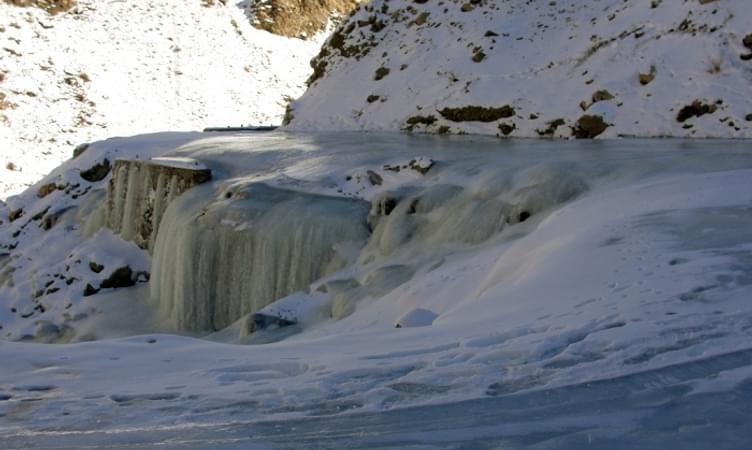
The approximate cost for the expedition of 13 days and 12 nights starts at about Rs 52,000 per adult. The cost may vary from individual to individual depending on the type of accommodation chosen or available, number of people travelling, activities possible and availability, changes in government fee on entry or taxes, credit card fee as per payment gateway charges etc.
The total cost includes the cost of ground transportation using Toyota Qualis, Scorpio or Innova, accommodation in A class hotels including all meals, tents, kitchen equipments, stool, tables and mattresses, meals, support staff and entry fees to monuments, wildlife areas and camping fees.
This package charge excludes the cost of sleeping bags, trekking shoes and clothing, any kind of personal expenses, tips, laundry, insurance and phone calls, any kind of drinks and cost incidental to change in itinerary etc.
Apart from this, you will have to bear the expenses of hiring or buying the equipments and essential items required for the trek such as day size packs, trekking boots, stream crossing sandals, water bottles, fleece jackets, rain proof jackets, insulating gloves, sunscreens, sunglasses, emergency first aid kit etc.
These items are vital for survival during the trek and hence must be carried by everyone participating in the expedition. You will also need special clothes such as long sleeve hiking shirts, long quick dry hiking pants, hiking socks, trekking poles etc. Some of these items can also be purchased from Leh if you do not own them yourself. Apart from Trekking you can also enjoy Bike trip in Leh Ladakh.
How to Plan a Cost-Effective Trek

Planning is very important to make a trek cost-effective. If you wish to cut down unnecessary costs, you need to plan your trip in detail. Just packing a ruck sack and heading for the Himalayas isn’t enough when it comes to planning a trekking trip.
You will need to plan things such as time of the programme, choice of the route and route details, choose the route type, check your capacity, capability and experience of your team members, collect information, plan for food, take gear and equipment, medicines, making the budget etc. For your personal expenses, take account of factors such as items to be packed, guide, porter, cook, check your physical and medical fitness, use of food and dos and don’ts at the campsite.
By planning out all these things beforehand, you can cut down a lot of unnecessary expenses during your trip. Prepare a checklist and tick out everything you have arranged. An organised approach to planning a trip is the best way to make your trip fruitful and cost-effective.
Before you set out for the trek or decide on going trekking, do a little homework by researching on the destination, the geographical and climatic conditions, on the things that you will need to carry and the things that will be provided to you from the agency that will facilitate your travel and then prepare a checklist. With an itemised checklist, you cut down the chances of missing out anything and hence the cost of buying an item or renting it last minute. You can also do budget Jeep Safari in Ladakh that will give you sight to breathtaking views.
Common Trekking Mistakes

1) Lack of Physical Fitness: Get yourself physically checked and only when you have been given a clean chit by the physician should you plan a trekking trip in high altitudes. High altitude trekking requires a lot of physical stamina, strength and endurance and for this reason it is highly essential that you are in the best of form. Persons suffering from heart diseases, high blood pressure, diabetes etc should refrain from trekking in high altitude regions.
2) Poor Packing: While setting out on a trekking expedition in the Himalayas, it is important that you pack all your stuff wisely. Remember that when you are climbing uphill, each and every gram in your rucksack will weigh heavy and hence wise packing is absolutely necessary.
So if you are a beginner, consult an experienced trekker before packing. If you are experienced, prepare a checklist and then pack only the most essential items.
3) Dehydration: Many people avoid drinking water in chilly conditions. This results in dehydration. So keep your water bottles close and drink in as much as you can. This will allow your body to maintain its water balance. By not drinking enough water during trekking, you aid in your body’s dehydration and make it weak and tired during the trek.
4) Wrong Outfit: Dressing up right is not just for parties and night outs. It is important that you are dressed in the right clothes and gear to enjoy your trekking experience at high altitudes. Do not wear flowy or frilly clothes that will make navigation difficult. Make sure you wear warm woollen and polyester clothes that suit the weather and help you trek easily.
5) Trekking at Night: You may feel adventurous enough to trek at night, but the best way to avoid trouble while trekking in the Himalayas is - avoid trekking at night. The slopes are slippery and there are no lights to show the way. If you venture out at night, you are sure to invite serious trouble.
6) Wearing the Wrong Shoes: Since you will be spending most of your time walking, it is best that you choose the right shoes for yourself. Strong and sturdy shoes with metal spikes are perfect for walking in the snow. There are different types of shoes for different terrains and you should choose your shoes carefully if you want to make your trekking experience enjoyable. A wrong set of shoes or even socks in the wrong terrain can spoil all the fun in your expedition.
7) Skipping Food: Eat well when you are on an expedition such as the frozen river trek. Many people skip their food not realising that this can cause a lot of problems. While on such a tough task, it is important that you give your body all the energy and nutrition you can to make it strong and sturdy enough to face harsh conditions. By skipping food, you make your body weak and less resistant to the severe conditions of the region.
8) Avoiding Weather Report: Do not forget to check the weather report before you start trekking. Neglecting or avoiding the weather report can land you in serious trouble, especially at such high altitude regions. Check for websites that offer such information and keep yourself updated before setting out for the adventure.
Is the Trip Customisable?

Yes, the trip is customisable and can be designed to suit your preferences. Himalayan expeditions are carried out in different time frames depending on the weather and climatic conditions. If you wish to travel independently, you can choose your time frame and preferred group size.
The charges will depend on the number of people in your group, trek area, trek style and duration of the trek. Before going on a trekking expedition in the Himalayas, it is best that you take a few things into account such as the geographical and climatic conditions of the region, the things you will require, common trekking mistakes that people make while trekking in such a terrain etc.
Also, plan your journey well ahead of time. Use a very organised approach to plan your travel. Do your homework by researching well on the region, the climatic conditions, the trek route, the different trek styles, the best season to trek in the region etc to make your expedition fruitful and enjoyable.
Armed with this information, you can plan your trip wisely and make it an enjoyable and memorable experience. Most people overlook such matters considering it to be trivial and are in for a big mess when they start trekking.You can also do rafting in Ladakh.
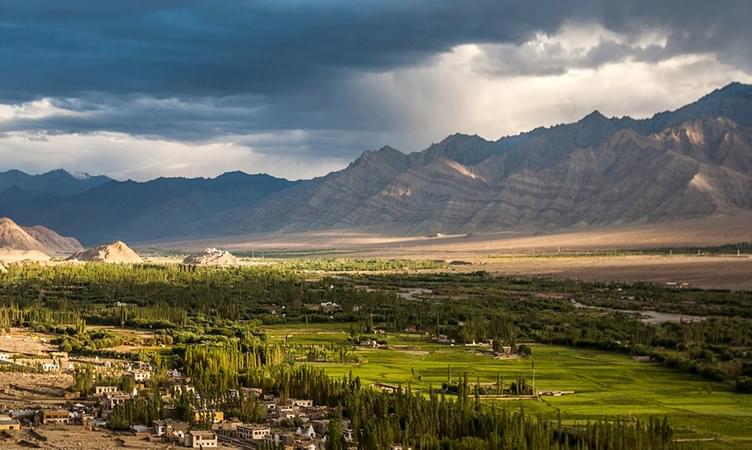
Best of Leh

People Also Ask About Ladakh
Is chadar trek for beginners, is chadar trek dangerous, how long is chadar trek, can chadar trek be done solo, what is the best time to go for chadar trek.
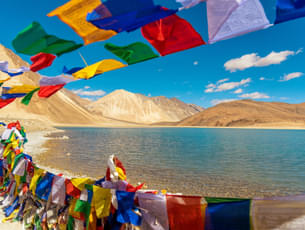
Trending in Ladakh
Trekking in ladakh.
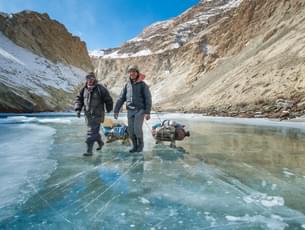
Ladakh Top Attractions

Heaven, Peace, Silence, and Tranquility at one place? Come and spend a few hours at Pangong Lake in Ladakh! A pristine place in Ladakh marked by subtle to high peaks around, crystal blue waters and the vast expansion catches the eye so much, so long as if a magic is happening right in front of the eyes. Let our Ladakh holiday packages transport you to this mesmerizing destination, where nature's grandeur unfolds in every corner.Pangong Lake, also known as Pangong Tso, lies calmly at a breathtaking elevation of 14,270 feet. Interestingly, the lake is 12 km long and marks itself between the laps of India and China. Rather, 60% of the portion is stretching in the neighboring nation and this excites every traveler to be here.The surreal clean blue waters are actually brackish or salty in nature and this feature doesn’t let any aquatic life survive in the same. Moreover, the temperature range between -30 to -10 degrees make even this salty lake freeze with thick ice sheets, which is quite opposite in case of salt ridden water bodies.This picturesque landscape location enhances its beauty with the arrival of migrating birds every year and attracts many travelers in search of adventure, photographs, bird-watching and chilling experience. Pangong has another unique and catchy feature; when it acts like a chameleon and changes its color from blue to green to even grey at times. The brackish water of Pangong attracts the migratory birds every year during winters in Ladakh.
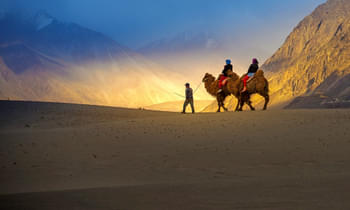
One of the most beautiful parts of the moonscapes of Ladakh, Nubra Valley is a deep-cut gorge created by the combined effects of Shyok and Nubra (Siachen) rivers. A high altitude cold desert, Nubra Valley is actually an extension of the Tibetan Plateau (Qing-Zang Plateau) that starts in China and extends up to Ladakh. This valley in the plateau separates the Ladakh Range from the Karakoram Range. But more than anything, Nubra Valley is the most beautiful region in all of Ladakh. Home to wonders like the Diskit Monastery,Hunder Sand Dunes, Samstanling Gompa, Yarab Tso Lake, and the villages of Turtuk and Panamik.Located about 160 km from Leh, the capital of Ladakh, Nubra Valley is a great attraction to all those who come here. The gateway to the upper reaches of the country, especially Siachen, Nubra Valley has an oasis of a town in the heart, Diskit, making a great place to stop you and reflect at the beauty around. And while you are at it, take a short detour to the famous white sand dunes of Hunder. The shapes and forms that these dunes take during different times of the year mesmerize every visitor who comes here. To make it further interesting, there are the double-humped Bactrian Camels, offering rides through the dunes.And when it turns dusky, head to the Diskit Monastery and visit the towering statue of Maitreya Buddha which looks over the entire valley and blesses it for another day to come.Planning a Trip to Ladakh, Experience of Chadar Trek - The Frozen River Trek
More Ladakh Attractions
Ladakh travel guides.
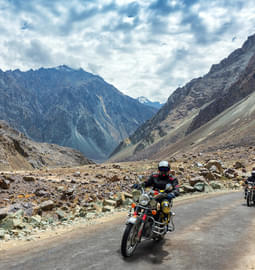
Ladakh Reviews

Popular Nearby Places Around Ladakh
More things to do in ladakh, more on ladakh tourism, popular related destinations.
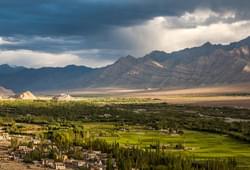
Best Domestic Packages
Best international packages, domestic honeymoon packages, international honeymoon packages, places to visit in india, international places to visit, things to do in india, international things to do, popular on thrillophilia.
- We assure the privacy of your contact data.
- This data will only be used by our team to contact you and no other purposes.
Your enquiry has been received successfully. Our destination expert will reach out to you soon!
Trekking in Ladakh
+91- 9212553109 /9810352536 Email : [email protected]
- Ladakh Treks
- Ladakh Special Tour
- Fixed Depature Trek

Frozen River (Chadar) Trekking
Area : Zanskar (Ladakh Himalaya) Altitude : 3850 mts/12628 ft Grade : Moderate to tough Duration : 13 days Season : Mid Jan to End Feb
The Chadar Trek (Frozen River) is a freezing escape that embarks upon the blanket of a large icecap on the River Zanskar. The strenuous walk connects us from Ladakh to the snow bound villages of the Zanskar Valley, covering a distance of approximately 90-100 kilometers. The trail all throughout leaves you with clattering teeth and frost dried eyes and during the blanched nights it leads to shiver you to empathize the temperature you never experienced before.
The Frozen River Trek starts from an unholy first night at Chilling, a day before you drive to Tilad Do, where the temperature might rove between 1-3 during the day and falling at minus 10 degrees during the night. Hence you got an ARTIC FEELING ahead even being in the Indian Himalaya. The trail from Tilad Do to Gylapo, which is entirely on the frozen river, will knock you the strenuous route ahead. Well, the porters will guide you like sensors, stimulating their sixth sense as to where exactly to step on the icesheet. At places, it might be necessary to wade through ankle deep water, or climb on the cliffs at the side of the river. Eventually you will get used to walking on the Chadar, which appeared like a cross between gliding and skating. The journey thereafter leads to Tibb Cave, which is approximately 14 kilometers en route the deep ravines, mountain caves and frozen waterfalls. The unique part on this trek is the moss covered rock, which is the only greenery and viewed at the plunge of a miraculous waterfall. After camping for the night inside one of the big caves the trail the next morning heads up to Naerak. The journey is simply breathtaking if you can accept the challenges. Up the clear blue sky, down the snow white slippery boulevard, passing through the snow fed walls and gorges, your FRIGID LAG will obviously take away by the colours of nature. Walking few steps up on the frozen floor it heads up to the mother-of-all frozen waterfalls – a huge instance of suspended animation several feet tall and equally wide.
The return trail down from Naerak to Leh follows the same route, covering a total of 7 amazing and tempting days even in the below freezing point.
- Humble and genial Zanskari (local) people, highlighting the tribal and traditional Ladakhi life.
- The challenging lives of porters and nomads and their struggles for surviving.
- Cultural Expeditions by exploring different monasteries like Hemis, Thiksey Monastery and the most famous Shanti Stupa.
- A fantastic glimpse of frozen Nyarak Waterfalls
- Amazing high-end Zanskar ranges
- Incredible sight-seeing at High Stok Kangri ranges and more
Day 01 : Delhi Leh (Complete Rest in Leh for acclimatisation)
Take the morning flight for Leh. Check into the guest house and relax the whole day. This is necessary for getting acclimatised. Overnight at the guesthouse.
Day 02 : Leh Shey Thiksey - Hemis
On this day you will go a sightseeing trip to some ancient monasteries in this area.
Shey Gompa is about 15 kms from Leh. It used to be the summer palace of the kings of Ladakh. There are lots of Stupas and Gompas built around the palace. Shey palace was built by Deldan Namgyal in the beginning of 17Th century AD. Main attraction in Shey is the 12m Shakyamuni Buddha statue inside the Dresthang Gompa.
Thiksey Gompa , close to Shey is about 17 kms from Leh. The monastery is considered to be one of the most beautiful in Ladakh and belongs to the Gelukspa order.
Hemis , about 45 kms south of Leh it is one of the most famous and largest monastery in Ladakh. It belongs to the Drukpa order and was founded in the early 17Th century. The setting is perfect with the monastery cradled in a lovely valley, surrounded by streams and fronted by long Mani walls. Overnight stay at the guest house.
Day 03 : Leh - Chilling(5 hrs drive)
In the morning drive to chilling along with our porters from Pishu village of Zanskar, visit coppersmith workshops. Dinner and overnight stay at guest house.
Day 04 : Chilling - Zaribago
We begin our Chadar trek by walking on the frozen Zanskar river from Chilling to Zaribago. The trek is of about 5 hours. Overnight at Camp.
Day 05 : Zaribago - Deepyokma
Walk on the frozen Zanskar river for about 4 hours from Zaribago to Deepyokma. Overnight at Camp.
Day 06 : Deepyokma - Nyrakpulu
Walk for almost 4 to 5 hours from Deepyokma to reach Nyarakpulu below the Nyarak village. Over night at Camp.
Day 07 : Nyarakpulu - Lingshed
Frozen River (Chadar) Trek Leaving Nyarakpulu it's a one hour walk to the small village of Lingshed. Enjoy the comfort and cozy atmosphere of a private house with central heating.
Day 08 : Lingshed
Spend rest of the day in the warmth of a private home in Lingshed. Explore the nearby monasteries, meet the monks and and hospitable people of the village. Overnight stay at the private home.
Day 09 : Lingshed - Nyarakpulu
Lingshed to Nyarakpulu - a walk of about five hours to the campsite.
Day 10 : Nyarakpulu - Tso Mopoaldar
Nyarakpulu to Tso Mopoaldar a four hour walk to the campsite.
Day 11 : Tso Mopoaldar - Tilatdo
Frozen River (Chadar) Trek Mopoaldar to Tilatdo - another day of walking about 5 hours.
Day 12 : Tilatdo - Chilling - Leh
From Tilatdo walk up to Chilling village from where a Jeep will take you back to the hotel in Leh by evening. Overnight stay at hotel.
Day 13 : Leh - Delhi
Early in the morning transfer to airport and from here catch a flight for Delhi.
Trip & Services Ends Here.
1800 22 7979
+91 22 2101 7979
+91 22 2101 6969
+91 88799 00414
Business hours
Top Recommended Destinations
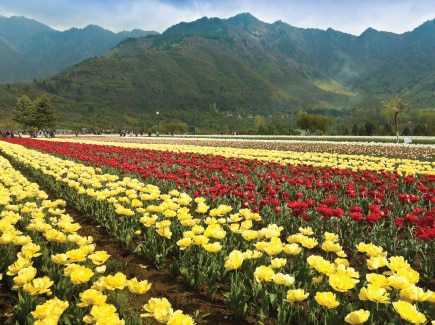
Jammu and Kashmir
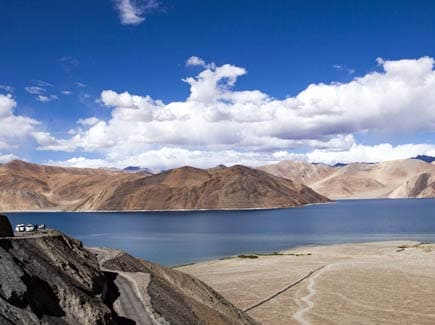
Sikkim Darjeeling
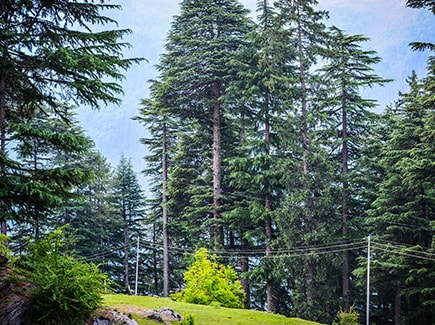
Himachal Pradesh
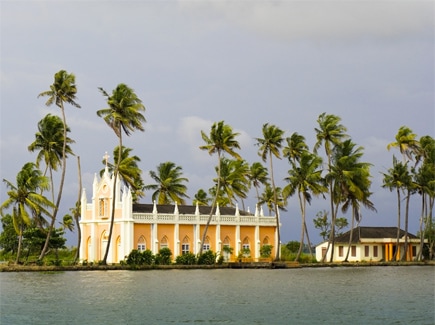
North India
- Chandrataal
- Dharamshala
- Spiti Valley
Nubra Valley
- Pangong Tso
Punjab & Haryana
- Kurukshetra
Uttarakhand
- Jim Corbett Park
Uttar Pradesh
- Fatehpur Sikri
Andaman & Nicobar Islands
- Neil Island
Andhra Pradesh
- Visakhapatnam (Vizag)
- Chitradurga
- Murudeshwar
- Shravanbelagola
- Athirappilly
- Thiruvananthapuram
- Kanchipuram
- Kanyakumari
- Mahabalipuram
- Pondicherry
Arunachal Pradesh
- Kaziranga National Park
- Manas National Park
- Cherrapunjee
- Bhubaneshwar
West Bengal
- Narmada Tent City
- Rann of Kutch
Madhya Pradesh
- Omkareshwar
Maharashtra
- Chittorgarh
- Kumbhalgarh
- Ranthambore
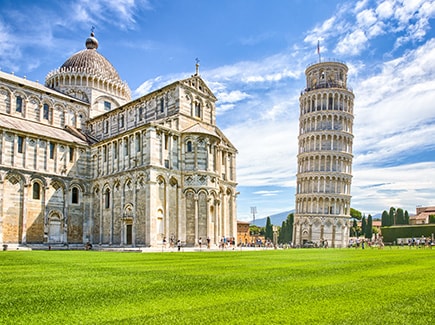
South East Asia
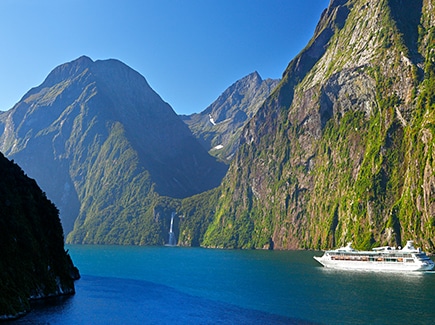
Australia New Zealand

Dubai Egypt Israel
- Nile Cruise
South Africa
- Johannesburg
- Pilanesberg National Park
- Port Elizabeth (Gqeberha)
- Stellenbosch
- Victoria Falls
- Rio De Janerio
- Los Angeles
- Niagara Falls
- Philadelphia
- San Francisco
- Nuwara Eliya
- Kuala Lumpur
- Genting Highlands
- Nusa Penida
- Ho Chi Minh
- Cherry Blossom Tours
South Korea
- Great Barrier Reef
- Great Ocean Road
New Zealand
- Christchurch
Western Europe
- Liechtenstein
- Netherlands
- Switzerland
- Vatican city
Central & Eastern Europe
- Czech Republic
Northern Europe
Mediterranean Europe
- Midnight Sun
- Northern Lights
- Scandinavia
United Arab Emirates
- Ferrari World
Saudi Arabia
An adventure of a lifetime awaits you. Immerse yourself in the untouched beauty of the last frontier on Earth, the serene beauty of icebergs, and witness landscapes that seem straight out of your dreams.

Speciality Tours
POPULAR & available TOURS
Honeymoon special.
Embark on a journey of togetherness.
Inspiring beautiful journeys & Scenic Routes.
Seniors' Special
Golden age celebration tours for 55+ yrs.
Women's Special
Exclusive handcrafted women only tours.
Family Tour Packages
Veena World’s safe, secure, and popular tours
Upcoming Tours
Couples only.
Exclusive tours for middle aged couples.
Luxury Tours
Enjoy the sweet life of luxury & pampering.
One Week One Place
Explore one place at a relaxed pace.
Post Tour Holidays
Explore the city after your big tour.
Short Trips
Quick getaways to stunning destinations.
Treks & Hikes
Exiting adventure & challenges (15-55 yrs).
YOLO Adventures
Experiences for adrenaline junkies (18-35 yrs).
City Walks & Day Trips
Explore the city and culture.
WOW Adventures
Thrilling holidays for family (10-55 yrs).
Students' Special
Dhamaal tours after 10th & 12th exams
Women's Special with Kids
Travel with your kids (boys & girls, under 12 yrs)
Customized Holidays
THEMED EXPERIENCES - Find your reason!
Romantic Holidays
City Breaks
Adventure Stories
Taj Holidays
Air Inclusive Holidays

Luxury Holidays
choose the right tailor-made luxury travel vacations

Island Getaways
explore the tropical island getaways
Buy & Sell Foreign Currency
Aed - uae dirham, gbp - british pound.
All your FOREX needs taken care of
- Chadar Trek, Ladakh: Location, Price And Best Time To Visit
Chadar Trek, Ladakh: Location, Price and Best Time to Visit
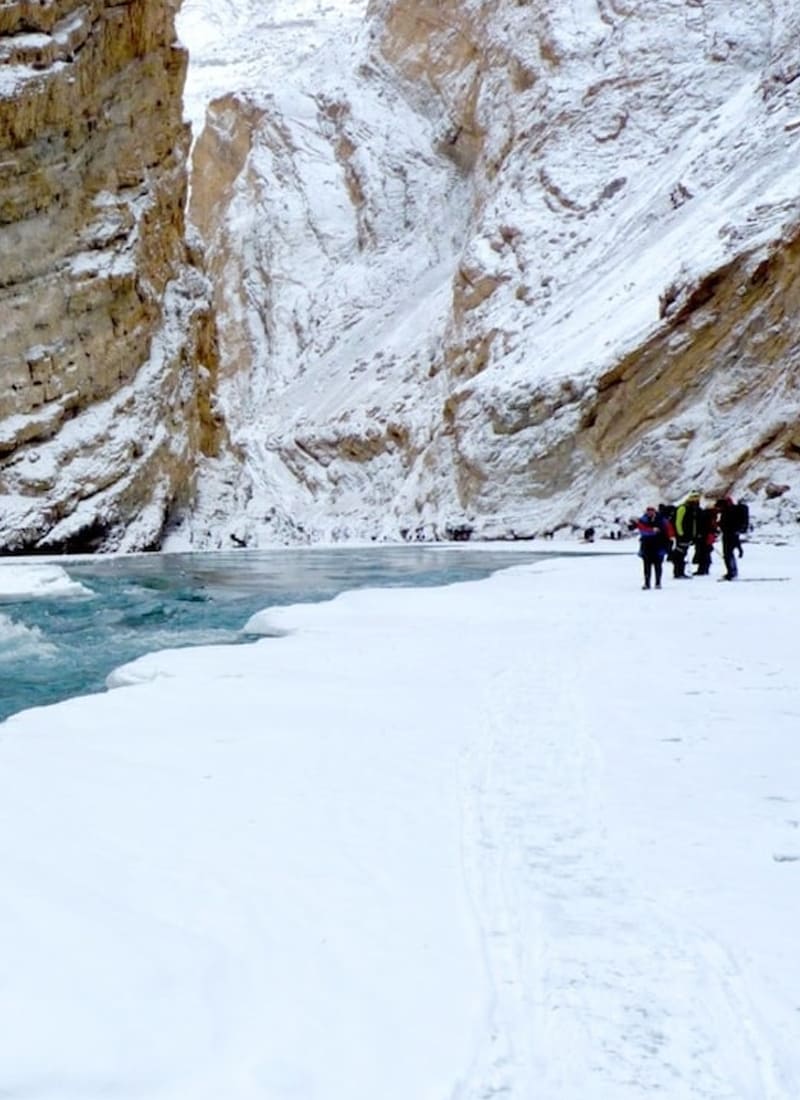
Ladakh, the largest province in Jammu and Kashmir, is surrounded by the Karakoram and the Himalayan Mountains. From scenic valleys to majestic mountain ranges to beautiful lakes and adventure, Ladakh has everything to mesmerize travellers. Ladakh is also called a land of treks or a dream destination for trekking lovers. Chadar trek is amongst the most exciting and adventurous treks in Ladakh, allowing you to witness the surreal beauty of mountain ranges for as far as you can see. The breathtaking Chadar trail on the glorious frozen river of the Zanskar is an exhilarating experience of a lifetime for adventure lovers. This trek is unique as trekkers have to walk on the surface of a frozen river in Ladakh. While most treks go over mountains, old forts, valleys, and caves, the Chadar trek is completely a different experience where you need to walk over the frosted glass-like river.
With breathtaking mountains covered with snow on one side and a lake stream, freezing or melting on the other side, the Chadar trek is one of the most adventurous trekking places in India . Here is everything you should know about the Chadar trek.
Chadar Trek – Location
The thick layer of ice in the Zanskar River looks like a white blanket – called chadar in the local language. Thus, the trek is famous as the Chadar Trek among tourists. This exciting trek is must visit place for those who love challenges and have a flair for high altitude trekking. The location of Chadar Trek will allow you to experience the beauty of the Himalayas. The trek starts from a quaint village named Chilling, from where the gorgeous Zanskar River begins to freeze. On your way, you will cross Tilad and experience the Gurudwara Pathar Sahib – the holy place constructed in memory and honour of Guru Nanak Ji. The distance of this trek is 105 km, mostly covered by walking.
How to Reach
The easiest way to reach the Chadar trek in Ladakh is by air. The Kushok Bakula Rimpochee Airport (IXL) is the nearest in Leh, connected with all major international airports in India. All major cities in India have some direct flights to Ladakh on a regular basis, and you can easily plan a trip to this beautiful place. Moreover, you will enjoy the flight journey as you will get to see an incredible aerial view of the mountain ranges and some untouched areas in Leh.
Chadar Trek Duration
It would take around 8 to 9 days to complete Chadar trekking - including the return from the place to Leh. This trek normally happens during January to mid-February as the lake is frozen, allowing you to easily walk over it. Winter is the best time to experience the ice sheets on the frozen river to be entirely stable. Remember, you should avoid planning to visit the Chadar trek at the beginning of January as the ice sheet is not firm enough to bear any weight that may cause serious problems. However, the best time to visit Ladakh is from April to June during summer and Mid-September to mid-October. It is wise to ensure that you get regular updates on the present weather conditions in the area.
Reasons Why You Should Visit Chadar Trek
Trekking is one of the best ways to relieve daily life stress, relax the mind and revive the spirit of excitement and adventure by accepting challenges and winning them. Also, the fun and excitement of walking on frozen snow and climbing on icy mountains are matchless. With frozen waterfalls, a frozen lake, and snow-capped mountains in its surroundings, the Chadar Trek route presents a different world for tourists away from city life. Here, you are going to walk miles of mountains, seeing and admiring the paradise-like ambience all around. The mesmerizing sight of the snow-capped mountains and the relaxed surrounding will give you a perfect break from your monotonous life.
Difficulty Level at Chadar Trekking
Visiting this place means you will be experiencing the toughest of challenges that you might have never faced earlier, which is a dream for snow and adventure lovers. Trekking in Chadar is recommended for people with good health and fitness as you have to walk a lot and that too through extreme weather conditions. As Chadar Trek is famous as a high-altitude trek, it is only recommended for experienced trekkers. Those suffering from any health problems such as asthma or breathing issues are not allowed to trek here. However, those who have some mild health issues but want to visit this place should contact their doctor and ask for guidance before taking further steps. Remember, you have to show a doctor’s certificate to verify your health condition and evidence of past treks you have experienced to become eligible for the Chadar trek. For some people, it may be difficult to walk on a frozen sheet of water. So, it is recommended to hire a skilled guide to complete the trek.
Chadar Trek Cost
The travel price for the Chadar trek may vary from individual to individual as per the number of people travelling, accommodation type available, alteration in government fee on entry, or taxes and activities. In addition, you have to spend on hiring or purchasing essential items needed for the trekking, including trekking boots, fleece jackets, sunscreens, insulating gloves, day size packs, stream crossing sandals, emergency first aid kit, and sunglasses.
Are Permits Required?
The Chadar trek is called an ecologically sensitive region, so government charges wildlife and environment protection fee from the trekkers. The permission and other related factors are managed by a trekking tour operator and included in the total Leh Ladakh tour packages . However, people who are willing to travel without any professional help need to manage the necessary permits in Leh. Tourists who are especially going for Chadar Trek need to spend 2-3 days in Leh for acclimatization to the weather condition.
Chadar Trek - Itinerary
The total distance of Chadar Trek is around 105 km. You will be expected to walk around 16-17 KM every day to finish the trek. Here’s the itinerary for your guidance and planning.
- Day 1- Arrive at Leh
- Day 2- Chilling and walk to Tilat Sumdo Camp
- Day 3-Tsomo Paladar
- Day 4-Trek to Dibb
- Day 5-Naerak Pullu
- Day 6-Walk from Naerak to Dibb
- Day 7-Trail to Shingra Koma
- Day 8-Trek to Chilling and get back to Leh
- Day 9-Departure
Other Attractions near Chadar Trek and Leh
One of the most beautiful places in Ladakh, Nubra valley, lies 150 km north-eastwards of Leh. Nestled at an altitude of 3048 m above sea level, Nubra Valley is a perfect spot to see the confluence of Shyok and Siachen Rivers, shining streams, green quaint villages, white sand deserts, craggy mountain peaks, and double-humped camels.
Hemis National Park
Famous as the Snow Leopard Capital of India, the Hemis National Park was established in 1981. It is the only national park in the north part of the Himalayas, renowned for sheltering the biggest number of snow leopards in the world. The park is also home to 73 bird species, 16 mammal species, and many other wild animals.
Pangong Tso Lake
Perched at an elevation of 4350 m on the Indo-China border, Pangong Tso Lake is one of the best tourist places in Leh Ladakh . Also called Hollow Lake, Pangong Lake is just 160 km away from Leh city. One of the biggest saltwater lakes in Asia, Pangong Tso Lake, is blessed with crystal clear water that keeps on changing colour from blue to green and breathtaking splendour against the backdrop of huge mountains. The lake turns solid during winters and becomes the spot for the ice skating festival.
Shanti Stupa
Located 5 km from Leh, Shanti Stupa is one of the biggest attractions in Ladakh. Situated on a hilltop in Chanspa that was constructed between 1983 and 1991, Shanti Stupa is a white-domed Chorten. Overlooking the Leh town, Shanti Stupa is a perfect place to enjoy the serenity, experience the stunning views of the surroundings, and meditate in the Buddha hall.
In addition, you can also visit Royal Leh Palace, Diskit Monastery, Tso Moriri Lake, Namgyal Tsemo Gompa, etc., during your trip to Leh. So, if you are planning for the Chadar trek, make sure you include all major attractions in the Ladakh region.
With scenic views, tranquillity, and enthralling experiences, Ladakh is truly a paradise for all adventure lovers. Make sure you choose the best Chadar trek package that takes care of everything in the itinerary.
We are an Indian travel company founded in 2013 and excel at domestic and international tour packages including guided group tours, specialty tours, customized holidays, corporate MICE travel, inbound travel and destination weddings.
Post your Comment Please let us know your thoughts on this story by leaving a comment.
Blog categories.
- Travel Guide
Looking for something?
Embark on an incredible journey with Veena World as we discover and share our extraordinary experiences.
Request Call Back
Tell us a little about yourself and we will get back to you

Our Offices
Located across the country, ready to assist in planning & booking your perfect vacation.
Locate nearest Veena World
Listen to our Travel Stories

5 Minute Travel Tips with Neil Patil
Become a smart traveler in five minutes. Every Monday join Neil Patil and hear about different travel tips and secrets to unlock your full travel Ninja potential.

Aapla Maharashtra
'आपला महाराष्ट्र' ही पॉडकास्ट मालिका म्हणजे महाराष्ट्राची झलकच. गौरवशाली इतिहास , वैविध्यपूर्ण परंपरा आणि आकर्षक भूगोल लाभलेल्या महाराष्ट्राची ओळख करून देण्यासाठीच वीणा वर्ल्डने ही मालिका सुरू केली आहे. या मालिकेतून महाराष्ट्राच्या रोमांचक इतिहासाचे साक्षीदार असलेल्या गड - किल्ल्यांचा थोडक्यात परिचय करुन दिला जाईल. मग दर गुरुवारी न चुकता ऐका ' आपला महाराष्ट्र ' आणि तुमच्या भटकंतीला द्या नवीन दिशा. Looking to explore the wonders of Maharashtra, India? Tune in to 'Aapla Maharashtra', a podcast series that takes you on a journey through the state's rich history, captivating culture, and breathtaking geography. Join us every Thursday for a new episode and discover the many forts that bear witness to Maharashtra's majestic past. Take your travel experience to the next level with 'Aapla Maharashtra'.

Chalo Bag Bharo Nikal Pado
#ChaloBagBharoNikal Pado, a Hindi podcast by Veena World, is here to take you on a virtual tour around the world. Every episode, our host Neil will be joined by expert travellers with years of experience in the Travel and Tourism industry. They’ll share their personal journeys and stories that you’ve probably never heard of before. A new guest, a new experience. New episode every Wednesday. Join us to Celebrate Life virtually.

Know the Unknown
Know something unknown daily in under 3 minutes

Life Stories by Veena Patil
‘Exchange a coin and you make no difference but exchange a thought and you can change the world.’ Hi! I’m Veena Patil... Fortunate enough to have answered my calling some 35 years ago and content enough to be in this business of delivering happiness almost all my life. Tourism indeed moulds you into a minimalist... Memories are probably our only possession. And memories are all about sharing experiences, ideas and thoughts. Life is simple, but it becomes easy when we share. Places and people are two things that interest me the most. While places have taken care of themselves, here’s my podcast, which I consider to be a great platform, through which I can share some interesting stories I live and love on a daily basis with all you wonderful people out there. I hope you enjoy the journey... Let’s go, celebrate life!

Travel. Explore. Celebrate Life Podcast with Neil and Sunila Patil
Travel is indeed one of the things that help us celebrate life. And 2020 has made us realise that more than anything else. With Travel. Explore. Celebrate Life., let's go on a journey around India and the world and talk about culture, history, experiences, food, and more. Your co-hosts Neil Patil and Sunila Patil along with special guests every episode, discuss where to go, what to eat, where to stay, what to pack, what to explore, and much much more. So hop on, chalo bag bharo nikal pado!

Travel Katta
#TravelKatta, a Marathi podcast by Veena World, is here to take you on a virtual tour around the world. Every episode, our host Sunila will be joined by expert travellers with years of experience in the Travel and Tourism industry. They’ll share their personal journeys and stories that you’ve probably never heard of before. A new guest, a new experience. New episode every Friday. Join us to Celebrate Life.
Recommended Tours
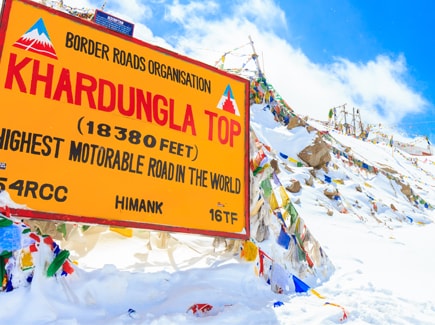
Highlights of Ladakh
Tour includes, super deal price.
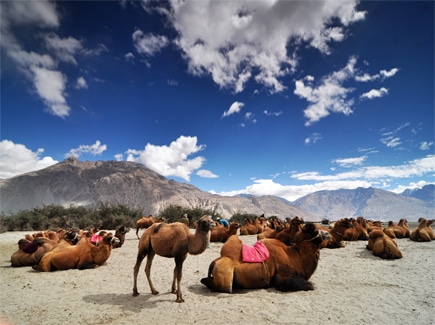
Women's Special Ladakh

Highlights of Ladakh - Pune
(04 may 2024) last 2 seats.
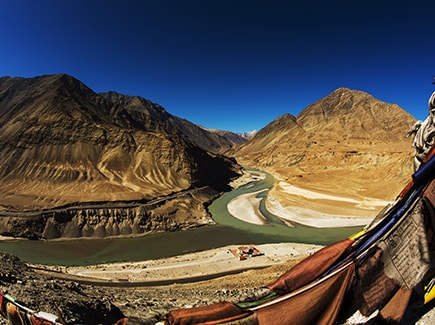
Women's Special Ladakh - Pune

Best of Ladakh
(02 may 2024) last 5 seats, most commented, calling out the spiritually inclined - 10 places of worship worth visiting in india, top 10 places in china - discover the land of oldest living civilization, a 2 week itinerary for a holiday in africa - trace your roots in the cradle of mankind, handpicked wedding destinations around the world for your big day, keep travelling all year round.
Subscribe to our newsletter to find travel inspiration in your inbox.
Trending videos for you

Top Travel Experiences

With Veena World

Dekho Apna Desh

Places to Visit in 2023
Veena world tour reviews, what are you waiting for chalo bag bharo nikal pado, all of ladakh.
"Dear Veena World I , Hemendra Shah and My Wife Sonal Shah , Senior Citizens joined the Veena World Tour of All of Ladakh in June ........ Read more
"Post tour call done : This tour was like dream come true for the guest. They found Leh sector very beautiful. Covered all the sightsee... Read more
"Mr. Manoj Dhangar and Mr. Yednesh both of them has done excellent job also the Guide (Mr. Rik Zin- I may be wrong in the spelling) hel... Read more
"feedback - womens special ladakh trip 11th to 17th may 2023. Tour code: *****A : Hi there, This is Sunita Yadav (Bangalore). I would li... Read more

229 departures
54,083 guests travelled

139 departures
23,331 guests travelled

48 departures
15,977 guests travelled

118 departures
1,06,542 guests travelled

335 departures
74,023 guests travelled
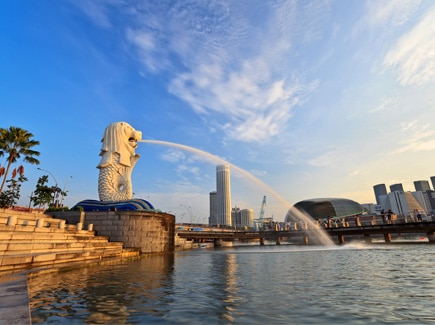
121 departures
1,20,135 guests travelled

28 departures
11,195 guests travelled

16 departures
11,566 guests travelled
Chadar - The Frozen River Trek
Walk on a Frozen River. Literally! / The ultimate Ice Walking Experience of Ladakh
Available Batches
Brief description.
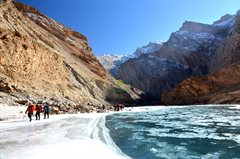
Brief Itinerary
Detailed itinerary.
Arrive in Leh (3,500 M)
The trek starts from Leh, which is a headway into Ladakh that is home to some of the highest peaks in the region. Because the roads are shut, the only way to get to Ladakh in winters is through air. There are flights that fly into Leh through Delhi and this two hour journey is where the magic begins. Try to get a window seat on the plane for the bird’s eye view of the Himalayas is absolutely mesmerizing.
Day one is reserved for you to make your way to Leh and get settled into your accommodation. Since you will be coming to this altitude from sea level, the body will need time to get comfortable with the altitude and the mountain air. Winters in Leh are quite harsh but the cold you experience here is only just the beginning!
Rest and Acclimatization in Leh (3,500M)
Day two is reserved for rest and acclimatization to the altitude, too. This is important to allow your body to adapt to its new environment and reduce chances of adverse health conditions. You can go around and explore the city market, delve into the colors and culture of this high-mountain city and visit some places nearby. A little movement around the city would be good for acclimatization. Also, use this time to go through your checklist and do some last-minute shopping for what you might be missing for the trek. Leh has the best market for trekking essentials.
While the body acclimatizes, we take this time to get together with the group for a debriefing session where we get to know each other better and delve into the happenings of the next few days - schedule, what to expect, basic do's and don'ts in the mountains, how to maintain the sanctity of the environment and other such matters of importance.
Day 3 is also reserved to adapt to the cold winters of Leh. The only other thing on the agenda is a mandatory medical check-up at the Tourist Information Centre which is essential to obtain a NOC from ALTOA and a permit from the Wildlife Department to trek on Chadar.
Leh (3,500M) to Shingra Koma via Bakula (3,215M)
Distance: 70 kms
Duration: 2-3 hours
Today is going to be our first actual day on Chadar – the first day when we trek in this winter wonderland. But not before we drive to Bakula which is the starting point of the trek. We start early in the morning to drive along the beautiful Indus River and past the confluence of Indus and Zanskar rivers at Nimmu. This short 70 km drive which should take close to 3 hours to cover, offers some of the most spectacular views as the vehicle goes around some narrow hairpin bends. As we inch closer to Bakula, we start to see the frozen marvel – Zanskar, waiting in all its glory. Once out of our vehicle and on the Chadar, the trek leaders will give you some quick tips on how to best manage yourself on this sheet of glassy ice. It will take a while to get a hang of it so don’t worry if you don’t get it right, right away – no one does. Walk around as much as you can using the Penguin Walk and you will soon find yourself giving tips to others.
The best thing about Chadar trek is that you walk on a flat surface throughout the trek. There are no steep ascents or descents and very little chance of catching AMS since you don’t gain any altitude throughout the trek. If you are comfortable today, you are already acclimatized and you should be able to finish the entire trek without any major issues.
Depending on the weather, the Chadar changes its forms. It can be hard and glass-like in some patches, or it can have a layer of powder snow on it giving you a better grip, or you could face thin ice in certain areas, so you might have to walk in slush or dodge that entire patch and go over the rocks on the side of the river. Walk together as a team and always follow the sledge route used by the porters as it is the safest route on Chadar.
We should reach the next campsite within 3-4 hours, depending on our speed and will spend our first official night camping on Chadar.
Shingra Koma to Tibb (3,280M)
Distance: 14 kms
Duration: 6-7 hours
The hardest part from here on is getting out of the warm sleeping bag and your cozy tents to step out into the freezing cold. However, the people of Zanskar are known for their hospitality – you will always wake up to a hot cup of tea and a meal waiting for you - all of which makes waking up in subzero temperatures just a little bit easier.
Today is a long day with 14 long kilometers to our next campsite. Since walking on Chadar is not the easiest, this should take anywhere between 6-7 hours to cover. Remember to top up your thermos with warm water – regular water bottles cannot fight the cold of Chadar and the water tends to freeze up. Sunshine in this bend of the land is a scarce commodity as well. You will only see the sun for an hour or two on the trail and that too, in patches since the walking trail is fenced by giant mountains on both sides. Marvel at the views as you walk in this huge valley with nothing but pure crisp air and huge rocks on both sides. The color of the Zanskar river is a vibrant deep blue that matches the blue of the sky on a clear, sunny day. The trail also offers frozen waterfalls all along the way. We stop along the river to cook our meals so that we are not walking empty-bellied. The last 200M to Tibb is stunning. Expect to reach the campsite by late afternoon.
Tibb (3,280M) to Nerak (3,400M)
Distance: 12 kms
Duration: 5-6 hours
At the end of today we get introduced to one of the biggest highlights of Chadar trek, the mother of all waterfalls – Nerak Waterfall. It is going to be another long day, so we begin early and aim to reach the waterfall by late afternoon so that we have all evening to marvel at it. The sun makes an exit from the Zanskar Valley early and the only way to keep warm is to keep moving. The ice in various patches is broken in the middle of the frozen river, forming geometrical structures of various shapes and sizes, which are fascinating to see. The lunch today is peculiar too, inside of a cozy cave, mid-way through our day. The cave is massive and can fit 12-15 people comfortably. Once we make it to the campsite, we feast our bellies to some snacks and make our way to the gigantic Nerak waterfall. It should take us about 30 minutes to get there. Along the way, we might even see a few domestic Yaks grazing the higher grounds. Right next to the waterfalls is a bridge across the river, which takes you up to Nerak village. It’s fascinating to see the old wooden bridge under the new concrete/steel bridge. We spend some time at the Nerak waterfall, before heading back to the campsite for dinner.
Nerak (3,400M) to Tibb (3,280M)
After that thrill of a climax which is Nerak waterfall, we start our journey back to where we came from. Today, we head back to Tibb campsite but nothing on Chadar is ever the same. If you think you know the route back and can predict the challenges for the day, you are in for a surprise. The frozen Zanskar river reacts to the slightest change in temperatures, and constantly keeps changing its form – hence, even though the trail is the same, it is different! Pay close attention to all the changing sounds as you walk on different kinds of surfaces – it is fascinating. Along the way, we see local porters wearing traditional woolen robes called ‘Gonchas’, with colourful beads around their neck and their traditional hats. It’s fascinating to see the locals negotiating the frozen river, as they seem to walk like the wind, absolutely comfortable with the slippery uneven icy surface. They greet you using the local phrase ‘Julley’ which is the Ladakhi term for hello/welcome. You might also catch a few locals singing traditional Ladakhi songs while pulling their sledges and enjoying the journey. We penguin walk our way to Tibb, as the locals zoom past us with such ease.
Tibb (3,280M) to Bakula (3,215M) and drive to Leh (3,500M)
Distance: 12-13 kms
Duration: 7-8 hours
For our last day of the trek, we head back to where we started from – and we’ve come a full circle. To reach Bakula, we should take 7-8 hours. The drive back to Leh should be close to 3 hours from there on. We stay the night at a hotel.
Departure from Leh
The trek ends here. If you plan to stay for a few more days to explore the wonders of Ladakh, the article below might help start you off on what places to consider. Places that you must visit in Leh Ladakh
Like we indicated before, the weather on high-altitude is unpredictable as are many other conditions. We would suggest you keep spare days between the end of the trek and your travel arrangements to head back home.
What's Included
- Camping during the trek on twin sharing basis and hotel stay in- Leh on Day 1, Day 2, Day 3 and Day 8 on twin/triple sharing basis.
- Meals during the trek starting lunch on Day 4 till lunch on Day 8
- Trek equipment includes Dome Tents (twin sharing), Siachen sleeping bags, mattress
- Helmet, Gaiters, Harness & Carabiners as required
- Experienced & mountaineering certified trek Leader with first aid certification.
- Services of Guide, Cook and Support team
- Transport from leh to Road head and return
What's Not Included
- Meals during hotel stay in Leh
- Any expenses incurred on medical examination in Leh
- Gum Boots will not be provided by us. Please carry your own Gum Boots or buy the same in Leh.
- Inner Line Permit Fee
- Any kind of personal expenses
- Any kind of Outdoor Insurance
- Portage of personal luggage
- Anything not specifically mentioned under the head price Includes
- Altoa & Environmental / Wildlife Permit Fee. Approx Charge 6k to 8k to be paid on the spot to the authorities
Are you Eligible for this Adventure?
Climbing up to an altitude of 3,400M, Chadar - The Frozen River Trek is as challenging as it is beautiful. Although it does not involve too much of a gain in altitude, adapting to the extreme temperature which drops to as low as -30 degrees and walking on a frozen river for 9 days is what makes this trek difficult. It is perfect for someone with prior trekking experience looking to level up a notch!
Max Altitude

BRS Level Required
Chadar - The Frozen River Trek is a level 5 adventure on the Bikat Rating Scale.
This makes it mandatory for you to have high-altitude experience of preferably multiple treks marked at level 4 on the BRS. The altitude, the terrain and the nature of the climb demand a certain level of skill and a need for you to be aware of how your body reacts to the various features of a high altitude environment.
If you do not know what level of BRS trek would suit you best, worry not! Fill out this Form:

we will send you a progression chart to help you comfortably get out of your comfort zone in order to level up and ultimately reach your highest potential in the big, bad world of outdoor adventure.
Packing List
This is a list of essential items for individuals doing the trek with Bikat Adventures. This list contains only those items which the participants are required to bring with them. The list excludes those items which are provided by Bikat Adventures on the trek. We have divided the items into five categories. All the items in the list are essential except for those marked as optional.
Trekking Gear
- Ruck sack bag with rain cover. Qty -1
- Day Pack Bag - Recommended for treks with summit day
- Head Torch with spare Batteries. Qty -1
- U V protection sunglasses. Qty -1 Here is how you can choose the best sunglasses for trekking.
- Water Bottles: 2 bottles of 1 liter each
- Non-skid, deep treaded, high-ankle trekking shoes Qty -1
- Pair of light weight Slipper/Sandals Qty -1
- Quick Dry Warm lower or Track Pants. Qty - 2
- Full sleeves T-shirts/ Sweatshirts. 1 for every 2 days of trekking
- Pair of thick woolen socks. 1 pair for every two days of trekking
- Thermal Body warmer Upper & Lower. Qty-1
- Undergarments. Qty - 1 for every day of trekking
- Warm jacket closed at wrist & neck .Qty-1
- Full sleeves sweater. Qty -1
- Rain wear ( Jacket & Pants ) . Qty-1
- Pair of waterproof, warm gloves. Qty-1
- Woolen cap. Qty-1
- Sun shielding Hat. Qty -1
- Personal toiletries kit (Small Towel, Toilet paper, paper soap, Bar soap, toothbrush, toothpaste, cold cream, etc.)
- Sun screen lotion small pack. Qty -1 Here is your Sun Protection 101 to stay safe in the bright sunny outdoors.
- Lip Balm small pack. Qty-1
- Small size, Light weight & Leak proof lunch box. Qty-1
- Plate. Qty- 1
- Spoon.Qty-1
- Tea/Coffee (plastic) Mug.Qty-1
Miscellaneous
- Camera (Optional)
- Carry your medicines in plenty in case you have any specific ailment. Consult your doctor before joining the trek.
- Dry fruits, Nuts, Chocolate bars (Optional)
Frequently Asked Questions
Eligibility, is this adventure good for me, what’s a good fitness benchmark for this adventure, what skills do i need to complete this adventure, what is the minimum and maximum age limit, about the activity, where is it located, what are some of its highlights, what are some of its challenges, what is the best season for this, what is the accommodation type, what is the temperature like here, is it technically challenging, connectivity, how do i reach the starting point, is there cellular network available throughout, where is the nearest atm, if i choose to travel to the base with you, what is the pick-up point, what time is the drop-off on the last day, what are the nearby attractions that i can explore, equipment & gear, what equipment is provided to us, what can i rent from you, where will i receive the rented items, where do i have to return the rented items, what gear do i need to bring, are there local shops to rent/buy equipment, facilities & additional services, can i offload my bag, can i leave any extra luggage i carry at the base of this adventure, what are the meals like, what are the washroom/ toilet facilities like, what should i do if i get my period on this adventure, what are the medical facilities available to me on this adventure, are there any electricity charging points on this adventure, mandatory documents, what documents do i need to carry, do i need insurance for this, do i need a permit for this, certification, do you provide a certificate of completion, when and how will i get the certificate of completion, international travel, will i need a visa, when should i apply for the visa, what kinds of insurance do i need to travel here, what is the specialty of this when compared to other mountain ranges, till which month can i make a booking for this, what is the qualification of the outdoor leader provided to us, how do you choose your outdoor leaders, is it safe for women, what is the ratio of outdoor leader to participants, what do you do in case of an emergency, what are the rescue options on this adventure, how do you choose your equipment, can i attempt this adventure if i have a specific medical condition, sustainability, what kind of camping do you practice on your outdoor adventures, why are you against fixed camping in the outdoors, how do you manage overcrowding on certain trails, what are some things to remember when using a dry toilet, why should i avoid wet wipes in the outdoors, where should i dispose of my sanitary waste if i am on my period, why should i carry my own utensils on an outdoor adventure, booking process, what happens after i make the payment, do you create a whatsapp group of participants before the start date of the activity, do i need to submit a medical certificate, do i need to submit an undertaking form.
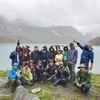
Small Group Size
Our batch sizes are capped at 15 for smaller treks with the trek leader and trekker ratio of 1:8. This ratio, in our years of experience, has proven to deliver the best trekking experience for individuals as well as groups. Capping the size of the group ensures individual attention to each trekker so that no signs of distress or need during the trek go unnoticed. It also helps to form a more cohesive cohort with better group energy which helps define the rhythm and pace of days on the trek. As you go higher up on the BRS scale, since the stakes are higher, expeditions have an even smaller group size with the ratio of expedition leader to climber set at 1:2.
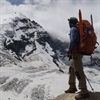
Qualified Trek Leaders
We follow a rigorous regime of hiring and training our experts in the field. Each trek leader is a certified mountaineer with years of experience in the field. In addition to their qualification, they also go through practical and situational training to tackle any and all kinds of sudden conditions that may present themselves on the ground. Being unpredictable is the core nature of the mountains but being ready for any circumstance as best as possible is a controllable asset that we try to nurture. Our field experts are also trained in basic medicine and first-aid response. Watch: Forerunners - The Making of A Trek Leader At Bikat Adventures
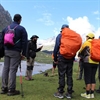

Guided Progression
Since Bikat Adventures is a learning-based organization, we help you climb up the ladder of difficulty within the sphere of outdoor adventure systematically. Our on-ground training modules are designed to handhold you through the upskilling process so that you are ready to take on bigger challenges.
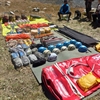
Equipment Quality and Check
All the gear used on our treks and expeditions is tried and tested, maintained for good quality, and is overall top-notch in quality and condition. We are continually looking to obtain the best of everything there is in the market so as to ensure optimum safety.
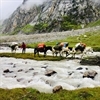
Support Systems
Along with the staff you see on-ground, we have a team of superheroes working in the background to give you the best experience possible. Our background team also comprises local staff from each area who know the region best. Having local support helps with studying the area, pre-planning, execution, and in receiving timely support in case of emergencies in these remote locations.
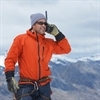
Communication
Our on-field staff is in constant contact with our teams based in primary locations so as to eliminate any avoidable delay in reaching additional help and support when required. We try to use the best tools for communication available, including satellite phones, in regions where they are not restricted.
What our customers Say

Cancellation Policy
Cash refund
Cancellations up to 30 days prior to departure date
5% deduction
Cancellations between 30 days to 15 days prior to departure date
50% deduction
Cancellations within 15 days prior to departure date
Voucher refund
Cancellations up to 5 days prior to departure date
No Deduction
Cancellations within 5 days prior to departure date
- Cash refund is applicable only in case of bookings made without using any promotional offer code or vouchers
- This is only a brief of cancellation terms. For finer details please refer Detailed Cancellation Policy.
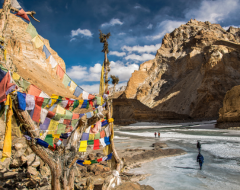
Subscribe for latest updates & offers
Similar adventures.

Sumda Chey Winter Trek
A mystical winter trek where adventure meets culture.
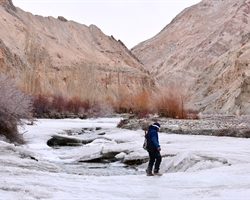
Markha Valley Winter Trek
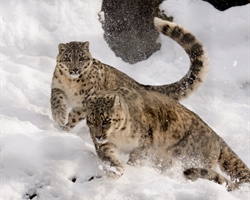
Snow Leopard Trek - Spiti
Trekked by many, discovered by a handful, enter your email, events by categories.

Mountaineering

Scuba Diving
Events by months.
- January July
- February August
- March September
- April October
- May November
- June December
Events By Nights
- 5 & More Night
- Environmental Policy
- Privacy Policy
- Term & Conditions
- Work With Us
- Address: 303, 3rd Floor, Tower B4, Spaze Itech Park, Sector 49. Gurgaon
- Pre Sale - 7838148127 , Post Sale - 8588878499, 9667639126
Bikat Adventures
- Cancellation & Refunds
- Content Sharing
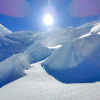
© 2024 Bikat Adventures - All Rights Reserved
Powered by: novel knett software solutions, submit enquiry.

- Pangong Lake
- Popular Ladakh Tour Packages
- Leh Ladakh Bike Trip
- Chadar trek
- Chadar Trek 2023 Booking
- Pangong Lake Tour Packages
- Customize your tour
- Popular Tour Packages
- Family Friendly Tours
- Nubra Valley
- Tsomoriri Lake
- Hemis National Park
- Turtuk Village
- Zanskar Valley
- Hall of fame
- Zorawar Fort
- Kargil War Memorial
- Ladakh Images Gallery
Chadar Trek 2024 – The Chadar Frozen River Trek

Chadar Trek
The exciting and adventurous Chadar Trek in Ladakh is a dream trek for most nature lovers and adventure enthusiasts. This awe-inspiring Chadar trek on the frozen river of Zanskar is a thrilling adventure experience of a lifetime.
Chadar trek trail
The road to the Zanskar valley gets blocked by the heavy snowfall in the winter, and the villages of Zanskar get isolated from the rest of Ladakh. The Zanskar river, which gets frozen during the month of December, creates a trail of thick ice sheets. This trail is the only way that connects the villages of Zanskar to the other places of Ladakh. The trail for the Chadar trek on the frozen Zanskar river gets thick enough in the month of January for the trekkers to walk on.
The above map shows the trail of the Chadar trek through Nerak, Tibb cave, and Gyalpo. So, in the Chadar trek, the trekkers walk on thick ice sheets formed on the river Zanskar. In March, the trail of the frozen river trek starts melting, due to which the Chadar trek can not be done. So, the month of January and February is the only two months for the Chadar trek when the trekkers walk on the frozen river of Zanskar.
An adventurous trek
The majestic view of the mountains covered with snow, the frozen river, and the ice over the lake are the biggest attractions for the people visiting this place. And one glimpse of this enchanting place is more likely than not to entice you to embrace the breathtaking experience of a lifetime.
Chadar trek is known for both its spiritual and physical aspects. The route crossing over the Zanskar River is known for its vast sums of snowfall. However, the journey is not without its dangers. The travel can be both exhilarating and adventurous as you will often encounter breaking ice and jolting mountains to traverse across this vast land.

Location: Zanskar River (frozen) in Ladakh Trekking Time: January and February Duration: 8 Nights / 9 Days Trekking Distance: 62 Km Difficulty Level: High Altitude: 11,000 Feet Temperature: -5°C to -30°C Camps: Leh (Base-camp), Gyalpo, Tibb cave, Naerak camp. Hotels in Leh : The White Yak, Mandalchan Hotel, Welkin High or other same category hotels .
Chadar trek Itinerary:
Day 1: leh arrival -base camp.
- The destination airport is Kushok Bakula Leh Airport.
- Temperature in Leh: -5°C to -15°C
- Night Stay would be at Leh Hotel.
- The road to Leh from Srinagar and Manali usually gets blocked by the end of November. So, you need to travel by air. You’ll be landing at the Leh airport.
- The temperature in Leh would be around -5°C to -15°C. Before you deboarded the plane at Leh airport, make sure you are wearing enough warm clothes. Keep your heavy winter jacket, woolen gloves, and woolen cap easily accessible with you in your hand baggage to wear before leaving the plane.
- Your hotel booking would be in Leh. Complete your check-in procedures at the hotel. After breakfast, you need to rest for few hours for acclimatization. As you have traveled from a lower altitude to a very high altitude place, acclimatization is very important. After taking a nap, in the late afternoon, you can visit Leh market.
- Carry enough warm clothes with you, as the month of January and February is extremely cold in Leh with a freezing temperature beyond -15°C at some point.
- You may also experience heavy snowfall during this time. So, make sure you are wearing enough warm clothes and have enough rest to acclimatize to the harsh weather at a very high altitude. And drink enough water to keep yourself hydrated, which helps your body to regulate temperature and acclimatize faster. Read Details
Day 2: Leh Base Camp – Acclimatisation
• Acclimatization Day • Sightseeing
- While enduring extreme cold weather and maintaining high altitude differences, Trekking is a challenging task your body has to accomplish. So, your body needs to acclimatize properly and get ready for the Chadar trek ahead. And the process of acclimatization for your body would take some time.
- Many tourists faced health issues caused by Acute Mountain Sickness (AMS) due to lack of acclimatization. So, DM (District Magistrate) of Leh Ladakh issued a standard operating procedure which is mandatory to comply with if you want to go for the Chadar trek.
- As per the standard operating procedure , you need to acclimatize for the first three nights and then start the Chadar trek on day 4.
- So, in the meantime, you can visit the surrounding places of Leh. You can discuss the day plan with us and book a taxi to visit a few nearby places.
- As body acclimatization is still in progress, you should not travel long distances or visit higher altitude places . Read Details
Day 3: Leh Base Camp – Fitness test:
- Fitness test at designated medical camp between 2:00 pm to 4:00 pm
- Obtaining permit to continue the Chadar trek
- Completing Insurance formalities if you get the permit for Chadar trek
- Refund/Ladakh winter tour; if you are deemed unfit for the Chadar trek.
- Thank you for your patience and persistent efforts to acclimatize faster. Today your efforts would be finally rewarded.
- As per the SOP issued by the DM of Leh Ladakh, you are supposed to undergo a medical examination to make sure you are fit enough to pursue the Chadar trek.
- And if you have complied with the instructions for acclimatization, chances are very high that you would be qualified to continue the Chadar trek.
- The permit will be issued by the officials at the tourist information center (opposite to JK bank main branch)
- After obtaining the permit, we will complete the insurance formalities.
- However, you can’t continue the Chadar trek in unlucky circumstances if you are denied of permit (very rare chances).
- But don’t worry, we are always there for you to help. You can ask for a refund, or there are many other places in Ladakh where you can travel in winter. And you would definitely enjoy it a lot by walking on the frozen lakes, or the great scenery of majestic mountains covered with snow blankets, and much more. So, discuss the itinerary with us, and we will plan a mind-blowing tour of Ladakh. If the amount of the Chadar trek would cover the charges of the trip, then you don’t have to pay anything. Otherwise, you have to pay the extra charges . Read Details
Day 4: Chadar Trek; First day of trekking:
- Travel to Shingra Yokma (70km) after the breakfast
- Sightseeing on the way
- Trek to Gyalpo/Tsomo Paldar (3km) by walking on the frozen river of Zanskar.
- First Night of camping at Gyalpo/Tsomo Paldar
- Finally, the day is here; today is the first day you would walk on the frozen river of Zanskar.
- To start the Chadar trek, you need to travel to Shingra Yokma, which is around 70km away from Leh. It would take around two hours to arrive, but you will make few stops for sightseeing.
- Some of the famous tourist attractions you will visit on the way are the Hall of fame, Sangam-the confluence of the Indus & Zanskar river, Magnetic hill, Gurudwara Pather Sahib, and more.
- After the sightseeing, you will be heading towards the beginning point of the frozen river trek, which is Shingra Yokma.
- Time to put on your gumboots/trekking shoes and start the walk on the frozen river of Zanskar.
- If you are walking on a frozen surface of water for the first time, you will find it a little challenging. And the gumboot would make this walk more thrilling and wonderful.
- You would need your walking stick (trekking poles) on the first day of the Chadar trek. But later, you would be comfortable enough to walk on the frozen river of Zanskar without a stick.
- The distance you will cover would be around 3 km, and it would take around 2 hours to arrive at the first campsite at Tsomo Paldar.
- After walking for a while on the frozen surface of the river Zanskar, you would start enjoying it a lot.
- You will find a range of different kinds of surfaces on the Chadar trek. Some surfaces are very thick to carry enough weight, and some surfaces are fragile, ready to break. While following your guide and your mates, you’ll also start to learn how to judge the fragile surfaces from the stronger ones.
- After completing the first day of the Chadar trek, you will arrive at your first campsite in Tsomo Paldar.
- Congratulations, you have just proved that you can do it.
- Enjoy the first-night camping at Tsomo Paldar. Read Details
Day 5: Tibb Cave – 6 to 7 hours
- Trek to Tibb Cave
- 15km to cover in 6 to 7 hours
- Lunch will be served on the way to Tibb Cave
- Night Camping Around the Tibb Cave
- After spending the first night camping, you would find the next morning very exciting. Enjoy a hot breakfast on a very cold morning.
- As you are acclimatized properly and trained fully yesterday, now you are ready for the long trekking of today (15 km).
- Today you will witness mind-blowing sceneries on the way to Tibb cave. The enchanting view of the waterfalls and the flowing river with sparkling rocks (reflecting sunlight) around. And the giant mountains of different sizes covered in snow blankets would offer a wonderful view. The most beautiful scenery of this trekking would be the waterfalls which come in the way.
- For the first time after visiting Ladakh, you will feel starving after a long walk. A hot lunch around the cold frozen river would be served. After having lunch, you will continue the walk with a few small stops.
- After covering around 15 km, you will finally arrive at Tibb cave.
- Night camping would be around the Tibb cave. It’s a beautiful place of sand and small stones beside the river. Read Details
Day 6: Nerak – 6 to 7 hours
- Trek towards Nerak after breakfast
- 13km to cover in 6 to 7 hours
- Lunch will be served on the way to Nerak
- Night camping around Nerak
- After breakfast, the trek would continue towards Nerak.
- Lunch would be served on the way.
- Nerak is the last post of the Chadar trek.
- At Nerak, you are going to witness the most beautiful waterfall with unique features you have ever seen.
- Tonight you would witness the coldest temperature of your life, which you heard only in the news. It’s the coldest time of the year in Nerak, and the temperature goes as low as -30°C around Nyerak village. And the heavy snowfall blocks the road to these areas, isolating Zanskar from the rest of Ladakh. And you have accomplished a marvelous task of penetrating this isolation, bravo.
- If time allows, you can visit the Nerak village. Visiting this area would give you a chance to catch a glimpse of the challenging life endured by the people of Zanskar throughout this distinctive time of the year.
- Night camping at Nerak. Read Details
Day 7: Return to Tibb Cave – 5 to 6 hours
- Return from Nerak to Tibb cave
- Night camping around Tibb Cave
- Well done, you are a pro now and a trained walker of frozen surfaces.
- Have a nice and hot breakfast, and then you will start returning to Tibb Cave. Hot delicious lunch around the cold frozen river would be served on the way to Tibb Cave.
- You have covered all the trails of the Chadar trek and endured the weather harshness at its extreme point. But, don’t take the trek lightly from now on, assuming it, as only a trail you have already completed trekking. Be careful and cautious, as you can never predict the weather of these areas.
- Night camping at Tibb Cave . Read Details
Day 8: Return to Leh – 7 to 8 hours
- Return from Tibb cave to Shingra Yokma
- 18km to cover in 7 to 8 hours trekking
- Drive back to Leh from Shingra Yokma
- Night stay at Leh Hotel
- After breakfast, the last day of trekking would start from Tibb cave. Today you will cover a distance of around 18km trekking to arrive at Shingra Yokma.
- Bravo, you have done an incredible job completing the challenging Chadar trek. You are a pro now, and you have really earned it.
- Make sure you have taken pictures and recorded a few parts of trekking to show your family and friends.
- From Shingra Yokma, you will drive back to Leh. If your flight is on the next day, you should buy some souvenirs for your friends and family. If your flight is a day later, you should rest today and visit Leh market the next day.
- The hotel at Leh would be cozy enough to keep you warm tonight after few nights of enduring extreme cold weather.
- Celebrate your achievement, have dinner, and rest for the night. Read Details

Chadar Trek Booking
Inclusions and Cancellation policy for Chadar trek 2024 booking
- Accommodations : 4 nights in Leh, 4 Nights in Camps on a double or triple sharing basis.
- Transportation : From Leh to Chadar trek vehicle-accessible point. Return to Leh after Chadar trek.
- Meals : All meals (Vegetarian) during the Chadar trek on the frozen river.
- Trek equipment : Sleeping bag, mattress, kitchen & dining tent, utensils, tent, and toilet tent
- Permit for the Chadar trek 202 4
- Qualified guide certified for Chadar trek and support staff.
- First Aid Medical Kits
- Oxygen Cylinders
Cancellation Policy
- Transfer of a booking can be done (for the same dates) without extra charges.
- Suppose you want to cancel 24 days before the start date of the Chadar trek. Then you will get a 90% refund, no questions asked. Also, you can opt for a special coupon for the next year (2025) of the Chadar trek. The coupon can be used by anyone approved by you for the Chadar trek. However, the coupon holder has to pay the difference if the rates go higher next year.
- If cancellations are made within 14-24 days before the Chadar trek, you will get a 70% refund. Or you can choose any other date for the chadar trek 2024.
- Suppose you want to cancel 14-10 days before the start date of the Chadar trek 2024. Then you will get a 50% refund . After that no refund, but you can transfer it to anyone else (for the same dates).
- “Please note that refunds for the trek will not be possible in the event of flight cancellations. But we will work with you to find a suitable alternative date for your trek. We understand that flight cancellations can be frustrating and inconvenient, but we are not responsible for circumstances beyond our control. We recommend that all trekkers arrive at least two days before the scheduled trekking date to avoid any last-minute flight cancellations. If your flight is canceled, please inform us as soon as possible so that we can make arrangements to reschedule your trek”.
Things to do after you have booked your Chadar trek with us:
- Book your flight tickets to Leh as per the Itinerary. And book the return ticket to your hometown two days after the Chadar trek ends. If the Chadar trek ends today, your flight should be the day after tomorrow to accommodate any unforeseen circumstances.
- Don’t forget to inform your family and friends about the dates and the location of the Chadar trek; in case of any emergency during the trek, you might need them.
- Keep your documents in order.
- If you haven’t brought your first aid kit from your hometown, buy it in Leh before going for the Chadar trek as there are no shops/chemists around the trekking area.
- After getting the permit for the trek in Leh, show your trekking backpack to our expert guide; they will guide you on what to pack and how. Also, show them the clothing and gears you are planning to wear on the trek.
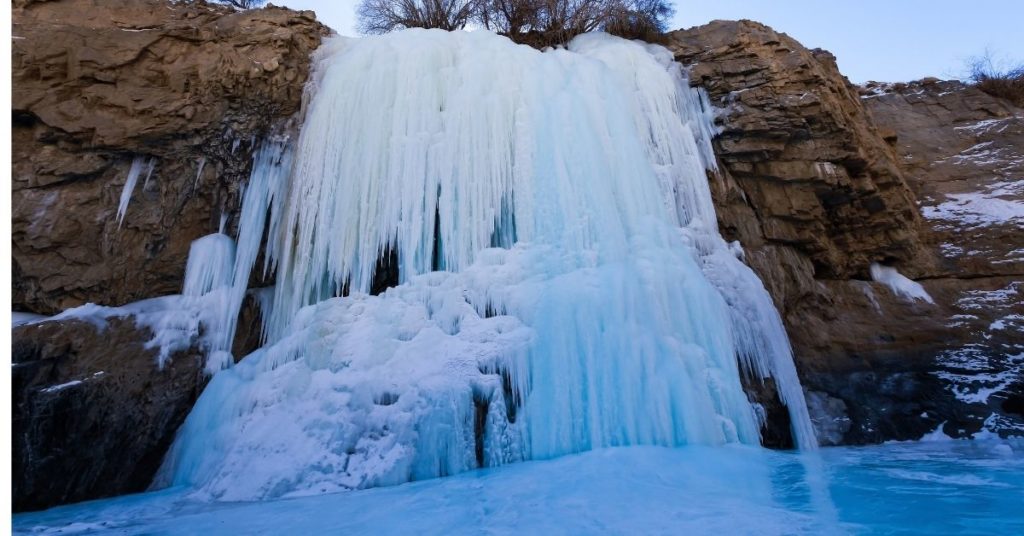
Packing list / Checklist for the Chadar trek:
The famous Chadar trek in Ladakh is highly adventurous yet demanding because you need to consider all of the requirements of the Chadar trek. From basic personal equipment to the emergency kit, you need to ensure you are well equipped before you commence your journey.
The gear includes some-what basic equipment which will allow you to reach Chadar in safety and security. Understanding the local weather condition and adhering to them makes the Chadar Trek a safe and successful journey. Winter is coming, and you are going to challenge it, so get prepared… as you are going to challenge the harshest winter of India at -30°C.
Given below is a comprehensive packing list for the upcoming Chadar trek
Weight restrictions for flights to Leh:
Before starting to pack your bags, keep in mind the weight restriction policies of the flights flying to Leh. Air India allows 30 kg per person. So, check with your airlines to confirm the allowable weight that you can carry to Leh Ladakh.
Dividing the bags
You should carry at least two bags—the main bag to carry on the Chadar trek and an additional bag. In the base camp Leh, you should divide your luggage into the trek and non-trek items. In the rucksack, you should carry all the trek items, and the rest of the items should be stored in another bag.
Backpack for the Chadar trek (55 – 65 L)
Choosing the right backpack. All of your trekking gear and clothes should fit in the backpack. So choose a backpack with a capacity of around 60 liters. Make sure the shoulder straps are comfortable enough with the supporting frames, as you have to trek for around 60km carrying the bag. Choose a backpack made from rugged, waterproof material to keep everything dry. Avoid backpacks with fancy handles and wheels, as these make the backpack harder for porters and mules to carry.
You can also hire a porter from us to carry those heavy bags for you. But you need to inform us at least 15 days in advance.
Carry these items to reduce the risk of getting infected.
- Hand sanitizers
- Disinfectant wipes/spray
- Tissues / Napkins
- Extra towels
Documents to carry:
- A photo ID proof like driving license, voter ID, passport. ID proof would be required at the airport and the hotel. Also, the ID proof would be required to make the permit for the Chadar trek.
- 4 Passport size photos to make the permit and insurance.
- A medical certificate of your fitness for the trek. The medical certificate should be from a recognized doctor.
- Indemnity certificate
- Covid-19 vaccination certificate
Packing items to wear on the Chadar trek:
- Gumboot: Experts recommend gumboot to be better than any other trekking shoes for the Chadar trek. At some point, you might have to walk in knee-deep cold water. The wet hiking shoes, socks, and pants will instantly freeze and won’t dry in the freezing cold temperature of Zanskar. So, gumboots are the best solution during situations like these to keep your feet and shoes dry. At the start, you will find it a little harder to walk comfortably on ice in those heavy gumboots. But soon, when you learn the expert way of “penguin walk” on the ice, and you will enjoy the walk on the frozen river of Zanskar.
- Hiking Shoes: A pair of good-quality (and waterproof) hiking shoes with a sole that would not slip on the glossy ice of the frozen Zanskar river. Avoid shoes with a smooth flat sole and heels. Shoes with plastic and leather-sole tend to be the worst for walking on ice. While purchasing the hiking shoes, make sure that it fits properly after you wear heavy woolen socks.
- Track pants: Carry 2 pairs of synthetic track pants.
- T-Shirts: Carry 2 full sleeve tees with collar.
- Inner thermals 3-4 pairs. Wear two layers at a time.
- Winter jacket/feather jacket
- A waterproof wind protector
- Cap: 2 woolen monkey caps that can cover the ears too.
- Socks: 2 pairs of sports socks and 2 pairs of woolen socks.
- Gloves (touch screen): Woollen gloves + synthetic glove (waterproof).
- Muffler: A woolen headscarf or muffler.
- Sunglasses with 100% UV protection (not polarized) to protect your eyes from sunlight and the reflections of snow. The clean snow on the way reflects most of the sunlight, creating a white appearance, which would be harsh for your eyes. Therefore, sunglasses are mandatory for the Chadar trek. And if you wear spectacles, you can wear contact lenses, so that you can wear sunglasses. Also, a photochromatic spectacle may be a good option if you don’t want to wear contact lenses. But at any cost, if you want to wear your specs, then buy bigger size sunglasses to fit them above your spectacles .
Toiletries and skin care to pack for the Chadar trek.
- Shampoo, face wash, soap, Toothbrush, toothpaste, wet wipes, and toilet paper should continuously be within your quick access during the whole trip.
- Deodorant, Razor and shaving cream
- Chapstick or lip balm and cold cream
- Sunscreen lotion (SPF 40+).
Few other important thing to put on your packing list for the trekking.
- Hot water bottle
- A thermos to carry hot water while trekking
- If you feel cold much more than others, you can carry exothermic warming pads.
- Trekking pole: It is mandatory for walking aid on the ice, and also, you can check the ice to be strong enough to walk on.
- Towel 2-3 small sizes microfiber towels with quick-drying features.
- 2 Water bottles (1 L each). Insulated water bottles are a better option. Also, normal water bottles can do the job.
- Non-prescription medicines kit: You must consider keeping all the basic medication that should keep you safe from potential common medical issues. For instance, you must have remedial medicine for headaches, stomach issues, cold & fever, band-aids for skin cuts, and any other medication you think you might need for yourself. You can slip and fall many times during the Chadar trek, as the ice would be very slippery, but slipping on ice won’t hurt you much, and you won’t need any medication for that. A bandaid will do the job if there is some minor skin injury.
- LED headlamp with extra batteries
- Small repair kit consisting of safety pins, needle, thread, and string (very important).
- Plastic bags: For wet clothes and to carry waste items to dump it later in a trash bin.
- Camera: The camera is a must-have item on the Chadar trek if you are interested in taking pictures. When you would be walking on the frozen river, you will find breathtaking attractions, and you would definitely want to capture the moment. So, don’t forget this ‘magical capturing moment device’ and its charger.
- Mobile phone and the charger: Cell phone is now a part of our lives, so, obviously, you won’t forget it. But still, write it in your checklist to check before leaving. The batteries of your phone can be consumed rapidly in the extremely cold weather of Zanskar. So, try keeping your devices warm.
- A waterproof case for your mobile
- Power bank: Keep your power bank ready with the other things to carry on the Chadar trek, as there would be a lot of power cuts in Leh. And there won’t be any power connection in the camps. So, carrying the power bank is very important to charge your phone. Your phone batteries can be consumed at a very rapid pace by the extreme temperature (-30°C) around the frozen Zanskar river. So, make sure that your phone is not out of power in Leh Ladakh. Always keep your power bank with you to prevent your phone from getting out of battery.
- Watch with alarm (if the mobile battery goes out of power).
- SIM: As of now, postpaid SIMs of BSNL, Airtel, and Jio are functional in Ladakh for roaming service. The signal for BSNL is better than Airtel and Jio. Internet speed is good in the main Leh area, but in remote areas like Zanskar, the signals would be very weak or no signal at all. We highly recommend subscribing to a BSNL post-paid SIM to use it on the Chadar trek.
You can also carry these items (Not very important)
Journal Pen Book/Novel Small binoculars
After packing your trek backpack, measure the weight. It should be below 10 kg if you intend to carry it yourself.
Things to avoid:
- Do not carry non-essential items, as you have to walk 62 km in the ice of the frozen Zanskar river during your Chadar trek. So, make your backpack lighter.
- Denim or jeans – not suitable for the Chadar trek
- Cotton or other sweat-absorbent clothing – Experts considered cotton to be a bad choice for the Chadar trek. It gets dampened when soaked with sweat which leads to rapid body heat loss.
- Junkfood, juice, etc. – Don’t carry too many of these items. Instead, carry snacks with high-fat like chocolate, nuts, etc.
- Don’t carry any disposable plastic bottles like (Bisleri, Aquafina), plastic wrapped/packaged items.
- Do not bring any non-biodegradable material.
- Carry a garbage bag with you to carry the leftovers. The Chadar trek area is an eco-friendly zone, so don’t dump trash there.
- During the trek, you will come across a few waterfalls, don’t use soaps and shampoos as local inhabitants of these areas drink this water. And the chemicals in these shampoos and soaps would contaminate the water.
- You will see a lot of local inhabitants and Lamas (monks) during the trekking. Don’t stare a lot, mock or pinpoint them, as they won’t like it.
Tips on keeping yourself warm during the trek.
- The temperature on this trek can go as low as -30°C, so try keeping yourself as warm as possible. Wear 2 layers of thermal sets, a heavy winter jacket, and a waterproof wind protector on the top.
- Wearing enough clothes is very important, but those clothes don’t produce heat; they just trap the heat produced by your body. So, keep moving or doing something during the trek to make your body produce heat all the time. When you stop for more than a few minutes, wear the windshield jacket to prevent the body from rapidly cooling off.
- Dressing in layers is found very effective in the extremely cold weather of the Chadar trek. The air trapped between each layer will hold your body heat. Plus, layers would help your body to regulate the body heat better and avoid sweating too much.
- Make sure that the warm thermal layer underneath your clothes fits snugly against your body so that your body heat would trap properly in them.
- Walk-in a slow and steady pace like the other trekkers of Chadar. Otherwise, you would sweat and damp your clothes. And wet clothes conduct heat away from your body.
- Sometimes, it would be windy in the freezing cold temperature of the Chadar trek, so you need to wear a waterproof windshield layer of fleece. It would prevent your body from cooling down. Please make sure the fleece is breathable, or it has a working zipper at the front to open it when it’s not windy.
- Fill your thermos with hot water and add sugar to it every morning before you start trekking. The weather conditions during the Chadar trek would be very cold and dry, which would make your body dehydrate more quickly than you realize. So, drink the hot water frequently during the trek.
- Keep the hot water bottle in your sleeping bag to keep you warm during the camp night.
- Make sure to keep your finger and toes warm. If your finger and toes get cold too quickly, it might get swelling which can cause irritation and pain. So, carry two pairs of woolen gloves and socks during the trek. When your finger or toes gets cold, take off the gloves or socks you are wearing. Now, warm your fingers or toes and wear another pair of gloves or socks. Similarly, if your warm cap gets damp by sweating, remove it and wear the spare one.
- Put exothermic pads in your socks and gloves; it would release heat and keep you warm for up to 8 hours.
- Eat chocolates, nuts, and other snacks with high-fat, calories, and protein. It will keep generating heat in your body, which would keep you warm.
- Please don’t sit on the ice of the frozen river of Zanskar, as it will conduct the heat from your body. Instead, sit on the rucksack/backpack.
- Please don’t drink alcohol during the night camps of the trek, thinking it will warm your body. Alcohol will make you feel warmer, but it doesn’t actually keep you warm. Instead, drinking alcohol lowers the core temperature of your body.
Are you fit enough to go on the Chadar trek?
If you are fit enough, with high levels of stamina and strength, then only you should go for the trek. If you have any health issues, consult your doctor.
How to know whether you are fit enough for the trek?
- If you are an experienced trekker with no recent health problems, then you are ready for the trek.
- Your stamina must be good enough to cover 5 km of distance in 45 minutes without stress.
- You should be strong enough to carry a 10 kg backpack on a trek of 6-7 hours.
- Don’t go on the trek if you have health complications like heart problems, asthma, high blood pressure, epilepsy, etc.
Tips on preparing yourself for the Chadar trek:
As mentioned earlier, the Chadar trek is a challenging trek that demands great fitness and prior trekking experience. The weather involved is freezing, and you have to walk on ice. But with the right attitude and perseverance, you can train yourself and get fit for the trek. So, start training yourself and get your body fitter each passing day. The more you train for the Chadar trek, the easier it will be.
- Prepare yourself for the extreme weather you have to endure on the Chadar trek. Be mentally prepared for the cold temperatures, long hours of trekking, and the possibility of changes to the itinerary due to weather conditions. Keep reading and watching videos about the Chadar trek regularly to prepare yourself mentally for the upcoming trek.
- You have to walk for 6 to 7 hours a day for 3 days on the Chadar trek. So, the best way to prepare for a really long walk is to do some long walks. Start with short distances and keep increasing the duration of the walk. You should be able to walk 6 hours comfortably.
- Walk up the stairs to strengthen your legs and to build stamina.
- The altitude in the Himalayas can be a challenge for many trekkers. Arrive in Leh a few days before the Chadar trek to acclimatize to the altitude and give your body time to adjust.
- To prevent acute mountain sickness, you should know about its symptoms, prevention, and treatment. So, start reading about it.
- Train with a backpack. You are carrying a backpack of 10kg on the trek. So, start training with a 5kg bag and then keep increasing the weight until it reaches 10kg.
An Amazing Trek To Explore The Beautiful Valleys:
Chadar Trek is a dream trek for many adventure seekers who want to have an awe-inspiring trek in Ladakh. The frozen Zanskar trail has immense natural beauty and charm. And the surreal experience on this trail leads the trekkers to cherish the moment of a lifetime. The amazing and fascinating nature of the Zanskar gives you a feeling of freedom and makes the journey on this trail amazing. This place, with its unforgettable experience, has been a unique destination for travelers for ages.
The scenic wonderous frozen Chadar trail superbly winds its way amidst lofty mountains, deep valleys, and surging rivers. This forbidding, however, is a pilgrimage of the brave. It is an arduous trek that goes hand in hand with great peril. And It’s a trek to be proud of, with sheer beauty and tranquility, undiminished by clouds of altitude and luring to the heights of mountain ridges abound. Get set for an experience that is here to stay unforgettable.
A wonderful beginning
Your journey to the wondrous and intriguing Zanskar Valley begins at Leh city, best known for its inexpensive accommodations, good restaurants, and central location. The airport is in Leh and around 7km far from the main Leh Bazaar. On your arrival to Leh, you would notice the great scenery this beautiful place has to offer. The majestic view of the mountains covered with snow, the floating ice on the great Indus river, and the ice over the lake are the biggest attractions for the people visiting this place. And one glimpse of this enchanting place is more likely than not to entice you to embrace the breathtaking experience of a lifetime.
Chadar Trek begins from Shingra Yokma. The walk on the frozen side of the river beside the magnificent flowing river – Zanskar River, which shimmers under the sun, makes the trek amazing. It inspires all travelers who come across with a passion for experiencing the astounding beauty that lies beyond the periphery of the human world.
The trail located offers the perfect balance between nature and spirituality, making it a well-renowned and visitor-intensive route. And as you walk across the beautiful and mesmerizing Zanskar River, you encounter great panoramas of the high-altitude valleys and isolated villages. And the awareness of spiritual values, the preservation of local culture, and prayer are often apparent as you get across the marvelous and mystical sunrise over the Zanskar.
The difficulty ahead
The trek on the frozen river of Zanskar is very thrilling and amazing. However, this trekking is not without its dangers. The travel can be both exhilarating and adventurous as often you will encounter breaking ice and jolting mountains in order to traverse across this vast land. The precarious sheet of ice crossing over the river blanks in and out is the most difficult passage, and some travelers even see the “ice smudges” as they slowly move in and out of the land. Thus trudging along the frozen Zanskar river during the Chadar trek is not an easy job, especially when the weather conditions are always unpredictable and you wither unsure what you are likely to see.
To envision your way through these dangerous and trying conditions, you will need an expert guide around you who will remain vigilant, careful, and will be able to predict the weather conditions, and will provide you the right types of equipment and instant support in case of any emergencies. So, don’t worry, we will provide you all with all requirements as mentioned.
The expedition is highly likely to be successful if the objectives are taken a little more seriously as, unlike other individual treks, it requires a great deal of planning to be well-paced. In case you are taking this trail independently, then the best bet is to be accompanied by a local guide who will step by step guide you through the trail and will take care of any emergencies. Contact us for an expert guide for your Chadar trek.
Helpful tips on how to trek on the frozen river of Zanskar:
When you walk on frozen river, it is important to be aware of the dangers that can happen around you. Icy and unpredictable conditions are something that you will have to weather if you are interested in visiting Chadar Trek. Trekking on the frozen river may seem like a fun and easy task, but It is true that you might face some dangers while trekking on the frozen river, but you can also rest assured that those dangers can be avoided if you know some tips about trekking safely on the ice. Here are some tips:
- The first and most important thing you have to remember is not to trek alone on the frozen river. Always make sure to have the guide around you or at least one person close to you.
- Stay alert at all times while walking on the ice. Don’t use a mobile phone while walking.
- Move slowly and keep your hands free. Don’t keep your hands in your pocket.
- Bend slightly forward and walk flat-footed; your center of gravity should be over your support leg.
- You will encounter ice cracks in your way. Instead of trekking near this opening, you may opt to walk through the hips of ice towards the other side.
- You should be wearing a pair of gumboots which does not have any holes or cuts in them. Make sure that your gumboots aren’t slippery, as these would make it easy for you to slip and fall once you start walking on the ice. This might seem strange, but flat-soled shoes are more likely to slip on the slippery ice than those with pointed toes.
- Another thing that you should take into consideration before trekking on the frozen river floors is your weight and how much you are carrying with you as you walk across. So, carry the important things only and walk as lightweight as possible.
- As you trek on the ice, you will also want to wear thick gloves so that if you slip and fall, you might slide a little, and your hand would get injured. Wearing thick gloves would protect your skin not only from the extreme cold but also from getting injured.
- Also, it is a good idea for you to carry a first aid kit with you.
- Ice is not your friend, so you must secure a good pair of ice clothing. Carry an extra set of clothes and keep them in a waterproof bag. So, that if you accidentally fall in the water, you have extra clothes to wear.
- Maintain some distance while walking, as walking closely in a group might put a lot of pressure on the ice, and it may break.
- Bend your back a little and head forward so that if you slip and fall on ice, it will avoid hitting your head against the ground.
- Always follow the guidelines and instructions of your trekking guide. The Chadar Trek is a challenging trek, and it’s important to take all necessary precautions to ensure your safety.
How to know if the frozen surface is safe for trekking?
Seeking professional advice from the local guide will be of great help if you are planning to do a “Chadar trek” as paired with a professional guide, you will be able to evaluate the condition of the trail. You will mentally and physically prepare yourself against deterioration and mishaps.
Enlisted are precautions you need to take during Chadar Trek:
- Always look out for routes with thick ice, for they are best for walking as they are less prone to breakages.
- The thickness of ice should be 4 inches to make it safe for walking. However, the Zanskar river keeps flowing, making the thickness vary from time to time. So, if you have measured the thickness while going towards Nerak, you should measure the surface’s thickness again while returning.
- If cracks appear below your feet, it’s advised to carefully place your trekking poles and move away from the danger zone.
- Be careful if you feel a temperature rise in Zanskar that might impact the ice quality. If the sunshine is of high intensity in Zanskar, then temperatures will vary widely, weakening the ice during sunny days and refreeze at night. As a result, the ice formed at the side of the river would weaken and float away with water flow, making it difficult for you to return.
- Avoid ice beneath the snow, as you can’t see if it’s thick enough or there are cracks. And the ice beneath the snow is often weak because of the insulating effect of snow which slows down the freezing process.
- Newer formations of ice are stronger than the older ones, and clear ice is the newer ones, so walk more on clear ice than white ice.
Be vigilant and careful all the time as your safety lies in your hands.
Three types of Ice to avoid during the Chadar Trek
- White ice is formed by freezing wet snow, and it would not be strong enough to walk. Ice formed by snow has air pockets making it weak and prone to break.
- Grey ice is also weak to walk on, as the color grey shows the presence of water in it, which weakens its density. So, try to avoid grey ice too.
- Slush ice ; the slush is a sign that ice is no longer freezing and might be melting. So, if you find slush on the ice, stay away from it. And if you find a lot of slush on the Chadar trek trails, inform the guide to know whether you should continue the trek.
What to do if the ice breaks and you fall in the water?
If you would be careful enough and follow the instructions properly, it’s very unlikely that you would fall in the water through the ice, but there is a chance that it may happen. That’s why it’s very important to know the tips and tricks recommended by the experts for these types of situations. So, what to do if the ice breaks while trekking on the frozen river and you fall in ice-cold water? Here’s what the Washington Post has to say on what to do if you fall into the water through the ice?
- Stay calm : It’s natural that a person goes into shock in such a situation. But don’t let the shock of falling into the ice-cold water take over. Clearing your mind would make it easier to come out of the water.
- Jacket to the rescue : Your heavy winter jacket would act as a buoy, and it won’t let you drown in the water.
- Kick, and pull ,” Gordon Giesbrecht, a professor at the University of Manitoba who studies hypothermia and is known as “Professor Popsicle,” told ABC News. “Put your arms on the ice, and just kick your legs, and just try to pull yourself along the ice.”
- Stay horizontal : When you come out of the water, lie down horizontally on the ice. As the ice around the hole is weak, it might break again if you stand up too soon. “Roll away from the hole to keep your weight spread out,” the Minnesota guide advises.
- Keep yourself warm: Get out of the wet clothes immediately, as it would start freezing instantly. Wear the extra set of clothes and drink something hot, and keep yourself warm.
How do I get to chadar Trek?
Located in Jammu and Kashmir, Ladakh, the land of high passes and fair valleys, is one of the most beautiful and spectacular places in this world. However, the journey to this place is quite difficult as, during winter, it’s impossible to move around through the high passes, as the road to Ladakh gets blocked by the heavy snowfall. And if one wants to travel, you need to fly miles before you can reach your destination.
The ruthless weather conditions and deep snow can crush any dream of exploring this amazing exotic place in the winter, but what is an adventure without a challenge! Many Indian airlines like Go Air and Air India offer flights to the destination. However, be sure to make your final booking much before you need to go, as flights are sometimes fully booked in advance!
The beginning of the Chadar trek is from Shingra Yokma. To reach Shingra Yokma, you need to follow the given route:
- Arrive, Leh
- Get the permit for the Chadar trek in Leh
- Book a Taxi in Leh to travel to Shingra Yokma
How to reach Leh?
You can reach Leh by plane or land. But the road to Leh would be closed during the months of November to April. And the time of the Chadar trek is January and February, which are the coldest months of the year with heavy snowfall, so the roads would be closed during the season of Chadar Trek. Read this blog post about how to reach Ladakh.
Flight to Kushok Bakula Leh Airport.
The airport of Ladakh is Kushok Bakula Airport, located in Leh. It is around 7 km far from the main Leh Bazaar. There are regular flights to Leh, including direct flights from cities such as Srinagar and Delhi. When the weather is fine, there would be no clouds, and you can enjoy the magnificent view of the Himalayas during your journey to Leh.
Due to the mountain breeze in the afternoon, all flights take off and land in the morning. This method is challenging because it is unidirectional and has high terrain towards the Kushok Bakula Rimpochee Airport’s east end. So, the timings of your flight to Leh would be in the morning.
From these cities flight goes directly to Leh Airport with no stops:
- Air India – Chandigarh, Delhi, Jammu, Srinagar
- SpiceJet – New Delhi
- GoAir – Delhi, Mumbai, Srinagar
- Jet Airways – New Delhi
If you live in one of the above cities, the flight to Leh would be direct from your city. Otherwise, you need to make stops in one of the above-mentioned cities to reach Leh for the Chadar trek.
From Airport to Leh city:
You will find a lot of cabs outside Leh Airport. When you leave the arrival terminal, you will find a taxi booking booth to your left, outside the terminal. You can also book a taxi from there to your hotel in Leh.
Taxi charges from Airport to Leh City:
Suv: ₹ 800/- Van/Omni: ₹ 600/-
Leh to Shingra Yokma:
You can book a taxi to Shingra Yokma in Leh. If you are in a group of four or less, then you should book an SUV. And if you are in a huge group, you can book a tempo to arrive at Shingra Yokma for the Chadar trek. If you have booked your trek with us, we will provide you the transportation to arrive at Shingra Yokma for the Chadar trek.
An interesting fact about Chadar trek
The Chadar trek is an excellent winter trek through the frozen Zanskar River, which lies within the Indian union territory of Ladakh. It is now becoming more popular among foreign adventure tourists. But do you know that the Chadar trek was started as a necessity by the people of Zanskar?
The Valley of Zanskar gets isolated from the rest of Ladakh for around 6 months. And the trekking route is the only viable means of travel from Zanskar to other places in Ladakh. So, the local inhabitants used the route to get their basic supplies and sell utensils, goatskin, and yak butter for livelihood. And the route which they used became the Chadar trek trail. Now it’s an easy task for the locals of Zanskar to trek on the frozen Zanskar river, as for 6 months a year, this is the only route that connects Zanskar to the rest of Ladakh.
During your Chadar trek, you will notice a lot of local inhabitants in traditional wear. You would get surprised at how easily they can walk on the ice of the frozen Zanskar River.
Few of the benefits of Chadar trek:
There are a lot of benefits to going on the Chadar trek. Spending 18-20 hours trekking on the frozen river not only improves your health and stamina but also adapts you to extreme cold weather. And that’s not it; you would also develop some skills.
- Softer skill development: Chadar trek can also benefit your management skills. You have to plan the trekking, set goals, and work as per schedule to stay with the trek group. All of these would make you not only punctual but also mentally strong.
- Reduces Stress: Spending time around rivers and mountains with beautiful sceneries would be the most relaxing time of all, which would reduce your stress.
- Social benefits: During the Chadar trek, you won’t be busy with many devices that give you a chance to interact with your group mates. Also, you would be helping, motivating, and encouraging each other to keep going. So, you will be able to bond with other members of the group, and you can make lifelong friends.
- Less junk or other harmful foods: On the chadar trek, you won’t be eating snacks, drinking beverages, and other junk foods. Also, you would be eating a lot of healthy foods.
Frequently asked Questions:
Do you have qualified and certified guides for the chadar trek.
Yes, all our guides are qualified and certified, and the government authorizes them to lead the Chadar trek. Not only have the guides completed their advanced mountaineering course, but they are well experienced for more than 10 years. We also have guides from Zanskar village, near the Chadar trek area, who lived there for more than 20 years and knew the place very well. A certified guide would accompany every group.
How many guides and staff per group?
All the groups would have at least one authorized guide and one local who knows all the routes of the Chadar trek area. The rest of the supporting staff are from the rescue team, cook, porter, helper, etc.
Chadar trek 2024 dates?
The Chadar trek in 2024 would start from the 6th of January 2024 to the 11th of February 2024. If there is any cancellation or changes in dates, the information would be updated accordingly.
How long is Chadar trek? Duration of Chadar trek?
You have to cover 62 km trekking on the frozen river of Zanskar. However, the duration of the whole trip would be 8 nights and 9 days. For the first 3 days, you have to stay in Leh to acclimatize, and on the fourth day, the trek on the frozen river would start. The duration and the camping locations during the Chadar trek is given below:
- Night 1, 2, 3 – Leh base camp . The permit for the Chadar trek will only be issued if you spend the first three days at Leh. On day 3, after the fitness test, you will get the permit for trekking.
- Night 4 – Gyalpo: On day four, the Chadar trek would start from Shingra Yokma to Gyalpo. Gyalpo is located at a bend in the Zanskar river. You would enjoy the great scenery of the river and the peaks and walls of rock faces that look human-made.
- Night 5 – Tibb cave : Tibb cave is a wonderful place of sand and small stones. It’s a great place for night camping. The view of the majestic mountains from the Tibb cave looks amazing.
- Night 6 – Nerak : – Nyerak is the last post of this trek. After Nyerak, you have to return from you came from.
- Night 7 – Tibb cave: On day 8, you would be returning to Leh from the Tibb Cave. This would be the last day of your Chadar trek.
- Night 8 – Leh
What’s would be the temperature during the Chadar Trek?
The temperature during the Chadar trek can vary from -5°C to -30°C. Chadar trek can only be done in the months of January and February. And these two months are the coldest months of Ladakh, with temperatures dropping below -30°C.
- On the first day of your arrival to Leh, the temperature at daytime in Leh would be around -5°C to -10°C. The temperature during nighttime in Leh would be around -10°C to -15°C. So, for the first three days of your Chadar trek at base camp Leh, the temperature would vary from -5°C to -15°C.
- The fourth day of your Chadar trek would be from Shingra Yokma to Gyalpo. The temperature during the daytime of the Chadar trek would be around -10°C to -15°C. And during the nighttime camping at Gyalpo, the temperature would be around -15°C to -20°C.
- On day 5, the temperature during the daytime would be around -10°C to -20°C. And during the night camping at Tibb cave, the temperature would be around -15°C to -25°C. On the 6th day of the trek, the temperature would be around -10C to -20°C. The night camping at Nerak would be the coldest night of the whole trekking, where the temperature can drop to -30°C.
- After day 6, you have to return from where you came from. So, the temperature would vary according to the places of trekking and camping as mentioned above.
Why is the Chadar trek difficult?
The trekking difficulty is a very common question that is asked by many tourists who are planning a Chadar trek in Ladakh. Many people think it’s walking on the ice sheets of the frozen river that makes this trekking difficult. But no, walking on the ice doesn’t make this trekking difficult, it can be dangerous, but if you follow the guidelines then, it’s actually fun.
So, what makes the Chadar trek difficult? The answer is straightforward… The extremely cold temperature of Ladakh and the Acute Mountain Sickness due to high altitude is what makes the Chadar trek difficult. The harsh weather of Ladakh and the extremely cold temperature can drop to -30°C. But if you read the information given above on how to stay warm and how to acclimatize properly, you can manage through the freezing cold temperature of Ladakh during the Chadar trek.
Is Chadar trek dangerous?
The Chadar Trek is considered to be a challenging and strenuous trek, but with proper preparation, it can be done safely. However, there are some risks associated with the trek that should be taken into consideration before embarking on the journey.
- The main risk associated with the Chadar Trek is the weather. The trek takes place during the winter months, and the temperature can drop well below freezing. The cold weather can lead to frostbite, hypothermia, and other cold-related injuries. Additionally, the ice can be slippery and unstable, increasing the risk of falls and injuries.
- Altitude sickness is also a risk on the Chadar Trek, especially for those who have not acclimatized properly. Symptoms of altitude sickness can include headache, nausea, and dizziness, and in severe cases, it can be life-threatening.
- Another risk associated with the Chadar Trek is the remoteness of the trek. The trek takes place in a remote and isolated area, which can make it difficult to access medical care in case of an emergency.
- Despite these risks, the Chadar Trek can be done safely with proper preparation and the guidance of an experienced trekking guide. It’s important to take the time to acclimatize properly, dress appropriately for the cold weather, and follow the guidance of your trekking guide. By taking the necessary precautions, you can have a safe and enjoyable experience on the Chadar Trek.
The details about how to acclimatize properly and how to walk on the ice are given on this page; please read it before going on the Chadar trek.
How to acclimatize for the Chadar Trek?
Acclimatization is an important part of preparing for the Chadar Trek. Here are some tips on how to acclimatize for the trek:
- Arrive in Leh a few days early: Leh is located at an altitude of more than 10,000 feet, and it’s important to give your body time to adjust to the altitude before starting the trek. Arrive in Leh at least two to three days before the trek to acclimatize.
- Take it easy: During your first two days in Leh, take it easy and avoid any strenuous activities. Relax and allow your body to adjust to the altitude.
- Stay hydrated: Drink plenty of water and fluids to keep yourself hydrated. Dehydration can worsen altitude sickness, so it’s important to drink plenty of water.
- Eat light: Avoid heavy meals and eat light, nutritious meals. Foods high in carbohydrates are a good option as they provide energy and help with acclimatization.
- Avoid alcohol and smoking: Avoid alcohol and smoking as they can worsen altitude sickness and make it harder for your body to acclimatize.
- Take short walks: Take short walks around Leh to help your body adjust to the altitude. Walking at a slow pace will help you get used to the thinner air and increase your oxygen intake.
By following these tips, you can help your body acclimatize to the altitude and reduce your risk of altitude sickness on the Chadar Trek. Remember to listen to your body and take it slow if you experience any symptoms of altitude sickness.
Is Chadar trek for beginners?
Yes, as a beginner, you can go for the Chadar trek, given that you are physically fit for it. The Chadar Trek requires a good level of physical fitness, as you will be trekking on ice and snow for several hours each day. It’s important to train for the trek in advance and build up your fitness level to be able to handle the physical demands of the trek.
If you have a medical condition, you should consult a doctor to confirm whether you can go for the Chadar trek or not.
Overall, while the Chadar Trek is challenging, it can be done by beginners with proper preparation and guidance. However, it’s important to be realistic about your abilities and take the necessary precautions to ensure your safety and enjoyment of the trek.
You should follow all the guidelines not to face any problems during the Chadar trek. This page consists of all the information about the Chadar trek, and the information is given by trekking guides of the Chadar trek, who are experts in this field. So, read all the information given on this page before going for the Chadar trek.
Can the Chadar trek be done solo?
It’s not recommended to go on the Chadar trek solo. Here are some reasons why:
- Safety: The Chadar Trek is a remote and isolated trek, and it’s important to have someone with you in case of an emergency. Having a trekking guide with you can help ensure your safety, as they are trained to deal with any potential issues that may arise on the trek.
- Navigation: The Chadar Trek is a difficult trek to navigate, with the route changing daily due to the shifting ice. A trekking guide will be familiar with the route and will know how to navigate the changing terrain safely.
- Logistics: The Chadar Trek requires a lot of logistical planning, including transportation, permits, and equipment. A trekking guide will handle all of these logistics, making the experience much smoother and more enjoyable.
- Group support: Trekking in a group can provide support and motivation when the going gets tough. The Chadar Trek is a challenging trek, and having a group with you can provide the support you need to keep going.
Overall, it’s not recommended to do the Chadar Trek solo. Hiring a trekking guide and trekking with a group can help ensure your safety and provide a more enjoyable experience on this challenging trek.
You can book your Chadar trek with us; we will include you in a group accompanied by a guide.
How much cash we need to carry with us during the trek?
It is important that you need to keep some cash for emergencies. However , don’t carry too much cash from your home town. You will find ATMs in Leh to withdraw the needed cash. Our guides in Leh would tell you what to carry and how much. So, it would be best if you ask our guides a day before the Chadar trek to know the cash amount carry with you.
Can we smoke or drink alcohol during the trek?
Smoking and drinking at a high-altitude place like Ladakh would harm your body. And it would make it difficult for your body to acclimatize properly. Also, there were few cases when the trekker suffered from acute mountain sickness due to smoking and won’t be able to continue with the trek. So, we strongly recommend not to drink alcohol or smoke cigarettes.
Do we need a trekking pole/walking stick while walking on the frozen river?
Yes, you would need a trekking pole if you are a beginner. However, if you are an expert in walking on ice without the help of a trekking pole, then you won’t need one.
What are the group sizes? How many trekkers are there in one group?
Usually, the least number of people in a group is 8. And the highest number is 22 people per group. However, if you have a group that wants a customized trek, we can arrange the same for you even if the number of people is lesser.
Do girls go on Chadar trek. Is it safe?
Yes, a lot of girls participate in the Chadar trek with us every year. It’s our top priority to provide a safe environment for the girls participating in the trek. Tents and rooms for girls and boys are separate.
Toilet facility during camping?
Toilet tents would be there at every campsite.
How to get hot water to drink while trekking?
Hot boiled water would be provided at the campsite. It is recommended to carry chlorine tablets to use with the boiled water. Also, don’t forget to carry boiled water every morning before you start trekking.
What medical facilities are provided during the trek?
All the needed equipment like oxygen cylinders, stretchers, first aid kits and more, would be available during the trekking. And don’t worry, our trekking guides are certified for first aid medicines.
Can we stay in the caves?
There are few caves with limited seats, so, if you book early we can look for the availability of a cave.
Will there be bonfires during the Chadar trek?
No, a bonfire is not possible, given the weather condition and the non-availability of wood.
What is the emergency evacuation plan?
If someone falls sick and requires medical attention, the support team would take the patient to Leh. The support backup team would always be there to attend to any medical emergency.
Where is the Chadar trek frozen river?
The Chadar trek frozen river is the Zanskar river which gets frozen during the winter, and the ice sheets get thick enough in January for the Chadar trek.
Please read the World health organization’s travel advice, before traveling anywhere.
Read Indian Government travel guidelines .

About the author:
Sam K. Pandepa is a travel enthusiast and right from the early years, he had a thirst for adventure. he likes to explore and document new places, trek in the mountains, and share his travel experiences with other travel enthusiasts. His vision is to explore and document new trails, hike in the mountains and implement sustainable ways of trekking. He loves sharing his Himalayan experiences and motivating people with his travel stories. When not traveling, he likes to spend time with like-minded travel enthusiasts and read books on travel and mountaineering.

Chadar Trek
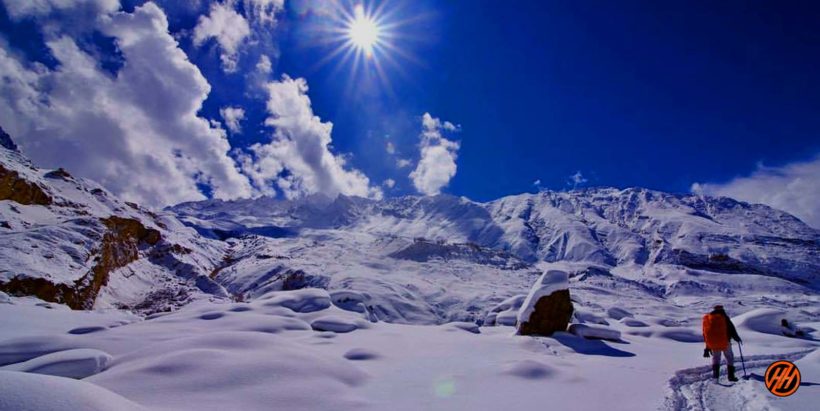
Description
Reviews (2), things to take, available dates, include / exclude, chadar trek in leh – over the zanskar river range of ladakh-2024- complete information, itinerary, costs date.
Your trek journey started with Himalayan Hikers , beautiful mountain town of Leh, all our trekker reach Leh by flight this is best option to you reach to Leh, altitude is 11400 feet above sea level, the trek beautiful Zanskar River which liws totally frozen during the December to Feb, Peak Winters Trek , So, probably the best time to do Chadar Trek is February because the ice remains harsh and stable. Trek starts from the freezing point of Zanskar River and that is Chilling.
Therefore, the “Chadar trek” is also known as “The Frozen River Trek”. This Trek is over a frozen river in the Zanskar region of Ladakh and it is different from all other treks in the Himalayas.
The snow appears as a thick sheet of snow, therefore, it is called “Chadar trek” and it is one of the trickiest treks in the world which is done in peak winter months. On this trek explore the Zankari culture and get to know about it in close proximity and the main highlight of this Frozen River Trek is a completely frozen waterfall “Nerak”.
The Chadar Trek is a popular winter trek in the Zanskar region of Ladakh, India. Here are some highlights of the trek:
- Trekking on the frozen Zanskar River: The highlight of the Chadar Trek is the experience of walking on the frozen Zanskar River, which transforms into a thick sheet of ice during the winter months.
- Breathtaking views: The trek offers breathtaking views of the frozen landscape, towering mountains, and the gushing river beneath the ice.
- Cultural experience: The trek also offers a unique cultural experience, as trekkers get to interact with the local Zanskaris and witness their way of life in the harsh winter conditions.
- Adventure: The Chadar Trek is a challenging trek that requires physical endurance and mental toughness. Trekking on the slippery ice, crossing icy-cold streams, and camping in freezing temperatures make it an adventure of a lifetime.
- Photography opportunities: The trek offers numerous opportunities for photography enthusiasts to capture stunning landscapes and unique cultural experiences.
Overall, the Chadar Trek is a must-do trek for adventure and nature lovers who are up for a challenging winter trekking experience.
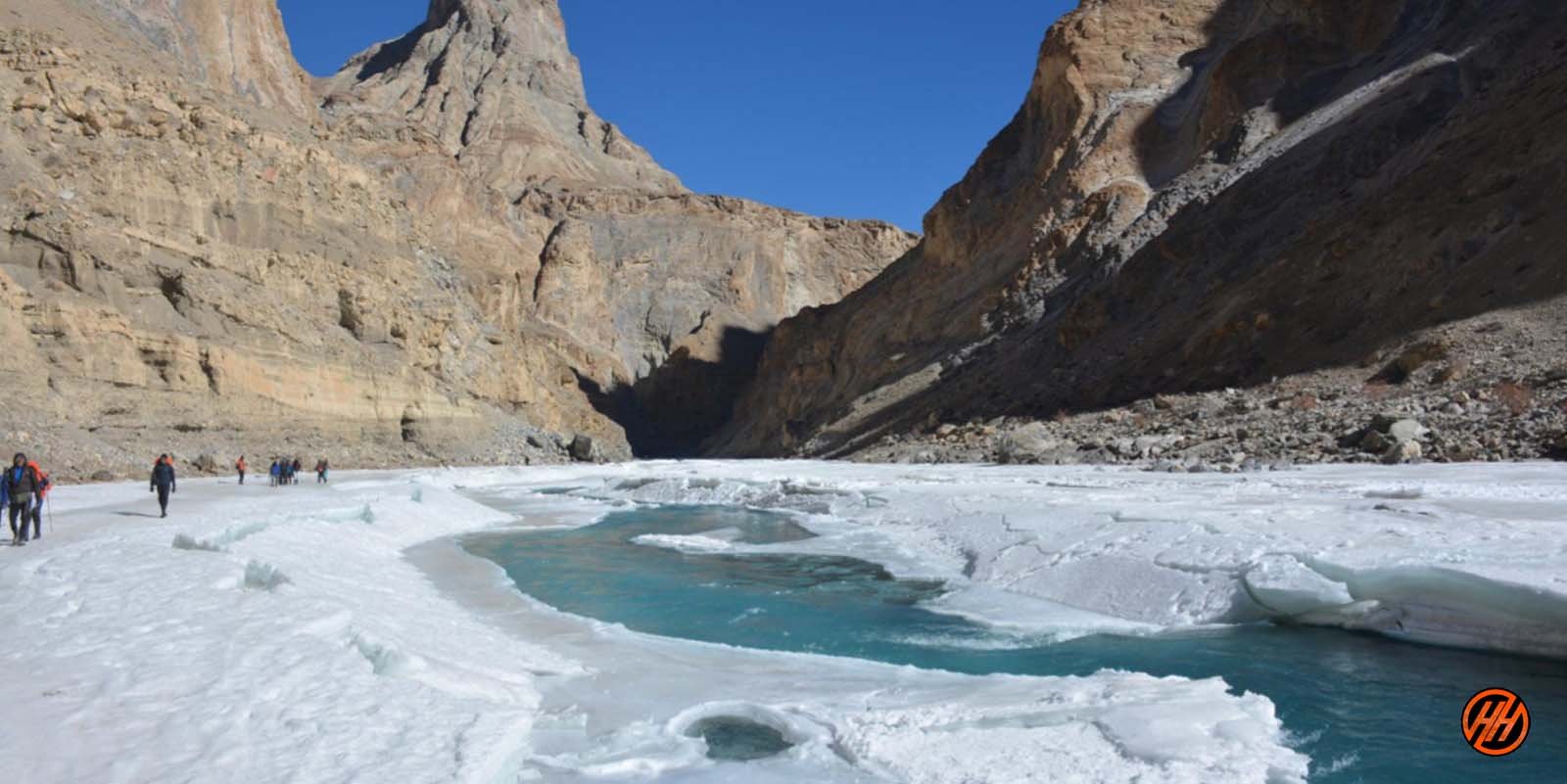
Ice Covering and Freezing Cold in Chadar Trek
The Chadar trek is over a frozen river and the ice can turn dangerous sometimes but can also be safe the other times. But, it is important to find a safe path over the perilous sheet of ice.
During the trek, you do not camp here at the meadows or the forest clearings but inside the caves which are present along the banks or you set up the tents at stable ice.
Here, the temperature remains chilly and freezing (-20) and falls down at night, so keep warm layers to protect the body against chilly cold and prevent the freezing of blood.
Best Time to Visit Chadar Trek
The best time to do the Chadar Trek is during the winter months, from January to February, when the Zanskar River freezes and forms a thick sheet of ice that is suitable for trekking. During this time, the weather is cold and dry, with clear blue skies and minimal precipitation.
It is important to note that the timing of the trek also depends on the weather conditions and the formation of the ice sheet. It is essential to have experienced guides and a reliable trekking organization to provide up-to-date information on the ice conditions and weather forecast.
Additionally, it is recommended to plan the trek in advance and book with a reputable trekking organization like Himalayan Hikers Trekking Organization to ensure availability and to have the necessary permits and logistics in place.
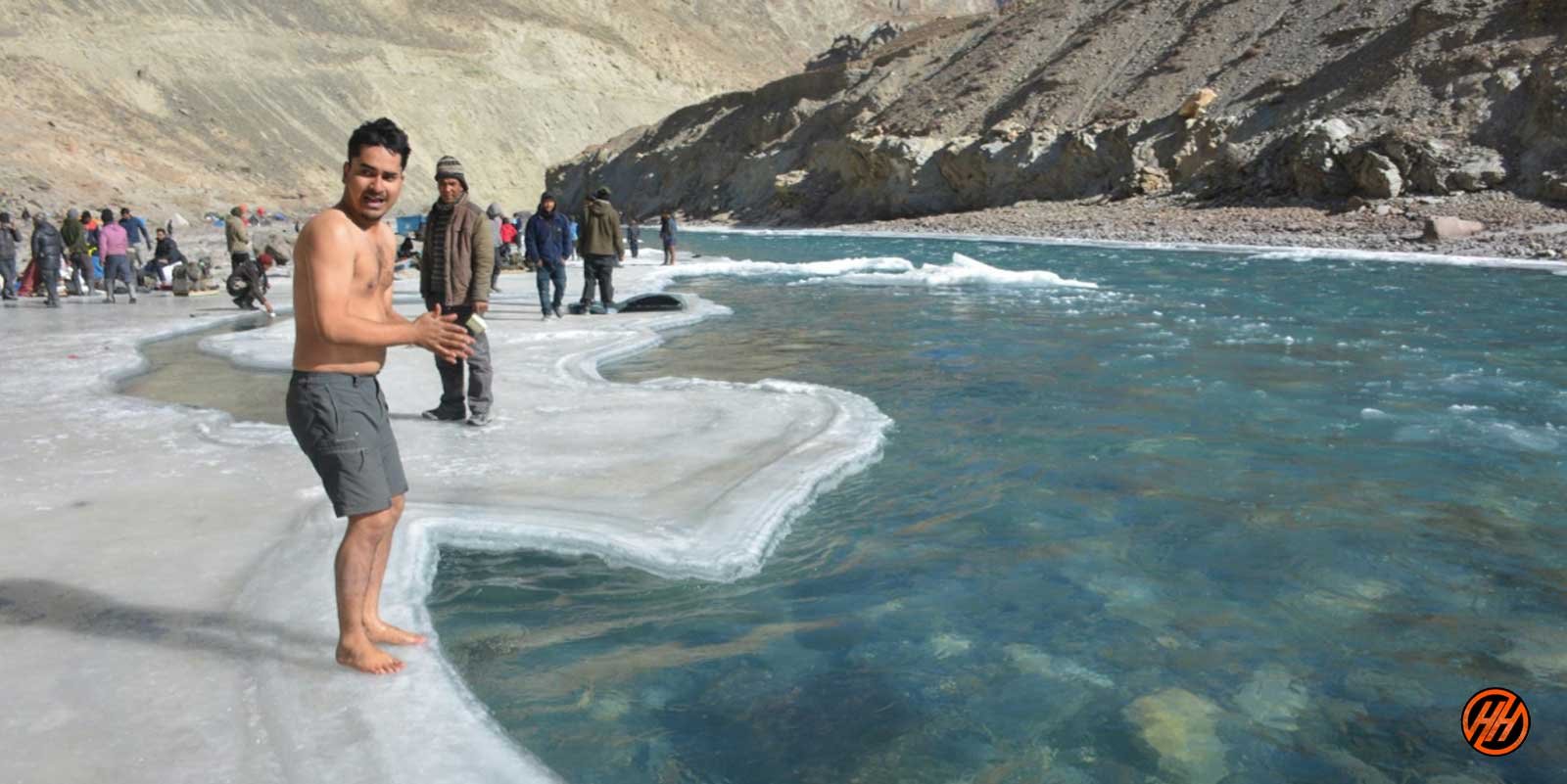
Be Aware During Chadar Trek (Not for Beginners)
You need to be very aware of the stability of ice and conditions below the feet for a safe trek. Sometimes the ice isn’t stable and the choices go wrong so walk carefully if suddenly a crack appears to go fast to the place where the ice is
So, choose a camping spot wisely after properly analyzing the area.
Here are some tips to do Chadar Trek –
Analyze the ice sheet conditions.
Avoid the cracks in the ice.
Walk carefully on the slippery areas.
Run immediately to a stable area if a sudden crack appears under your feet.
Walk on the places with a coating of snow.
Choose camping spots wisely.
Alcohol and smoking are not allowed in during the trek
Level- Difficult
During the trek, proper conditioning & training of body required
Need proper gear & clothing for sub-zero temperature
Shoes are the single most important equipment.
High Altitude requires proper acclimatization. Of base camp Leh
Beautiful landscapes so carry good photo gear & Extra battery backup.
Travel headlight
The backpack should not exceed 12 kg.
Long Gumboots are mandatory to all trekker
About Leh – Ladakh – The Land of High Passes
Area: 98,000sq km
Altitude: 7,500m Max.
Population: 250,000
Religion: Buddhism, Islam. Hindu
Geographical Status: Cold Desert
Across the Kashmir Valley and over the famous Zoji La pass lies Ladakh, the Land of High Passes. It is a magical land, so completely different from the green landscape of some other parts of the Himalayas. It is nature at its extreme. A land of freezing winds and blazing sunlight, Ladakh is a cold desert lying in the rainshadow of the Great Himalayas and other smaller ranges. Little rain and snow reaches this dry area, where the natural forces have created a fantastic landscape.
Ladakh forms part of the state of Jammu and Kashmir in India. Parts of Ladakh are under the illegal occupation of Pakistan and China. The border of Ladakh touches those of Afghanistan, Pakistan, China, the Kashmir Valley (India) and Himachal Pradesh (India). This region is made up of two administrative districts — Leh District, with its headquarters at Leh, and Kargil District, with its headquarters at Kargil –and covers a total area of about 59,000 square kilometers.
Ladakh is at an average elevation of 2,700 m to 4,200 m. The aridity of this region is due to its location in the rainshadow area of the Great Himalayas, elevation and radiation of heat from the bare soil. The most striking physical feature of Ladakh, however, is the parallelism of its mountain ranges. The region is extremely dry, with an annual rainfall as low as 10cubic centimeter.
In Ladakh, large rivers and their tributaries have carved deep gorges far below their steep banks. However, their water is not of much use as the terraced fields lie high above the gorges.
Until the advent of the aircraft, Ladakh could only be reached over dangerous, high passes. The Zoji La pass connecting Ladakh to Kashmir is at 14,000 ft and is the lowest approach from the west. The southeast approach has to cross the 18,200 ft high Tanglang La. And to the north lie the Saser La and Karakoram passes, gateways to Central Asia from where trading caravans used to come for many centuries.
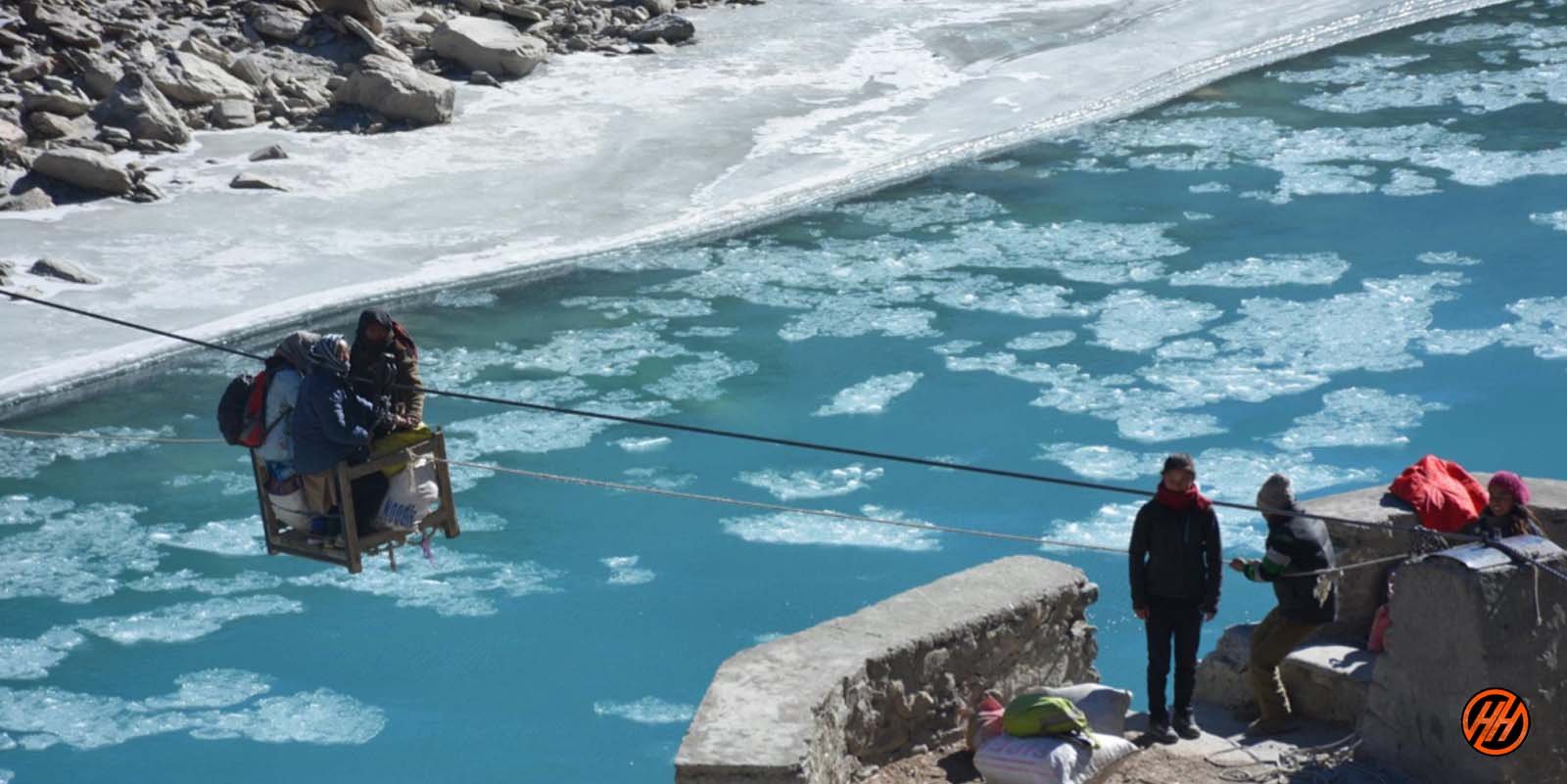
Altitude we are going to cover in Chadar Trek
Leh – 3500 Meters
Tsomo Paldar camp – 3200 Meters
Tibb Cave camp – 3300 Meters
Nerak camp – 3400 meters
The temperatures during the Chadar Trek
The temperatures during the Chadar Trek can be quite cold, as it takes place during the winter months when the region is covered in snow and ice. The average temperatures during the trek range from -10°C to -20°C (14°F to -4°F) during the day, and can drop to as low as -30°C (-22°F) at night. However, it is important to note that temperatures can vary depending on the weather conditions, altitude, and time of day.
It is crucial to have proper clothing and gear to stay warm during the trek, including warm base layers, a down jacket, insulated pants, waterproof gloves, and a warm hat. Additionally, it is important to stay hydrated and eat nutritious food to maintain energy levels and stay warm. Experienced trekking organizations like Himalayan Hikers Trekking Organization provide detailed information on what to wear and pack for the Chadar Trek to ensure a safe and comfortable trekking experience.
ATM Point & Mobile connectivity in Chadar Trek
ATM POINT: Hi trekker ATM available is Leh Withdraw money before your journey,
Mobile Connectivity: There will be available all networks only postpaid
Key Points of Chadar Trek
Duration: – 08 Nights 09 Days from Leh to Leh
Base camp: – Leh
Winter Temperature:- Day -5°C to -15°C) Night – 12° C to -20° C
Chadar trek – Altitude: – 11400 feet
Best Time: – Jan or Feb
Trek Level: – Difficult
Trek distance: – On foot 57 Km – By taxi 140 km
Group Size: – minimum of 05 people maximum of 15 people
Temperature
The winter temp. touches as low as minus 30 degree (Leh & Kargil) and minus 60 degree in (Drass) subzero temp. prevails from December to February throughout Ladakh, whereas, zero degree temp. is experienced during rest of winter months. This results in freezing of all conceivable water resources. During summers the maximum temp. increases from 20 degree C to 38 degree C in July and August
Clothing: Light/Medium woolens in summers to Heavy woolens in winter
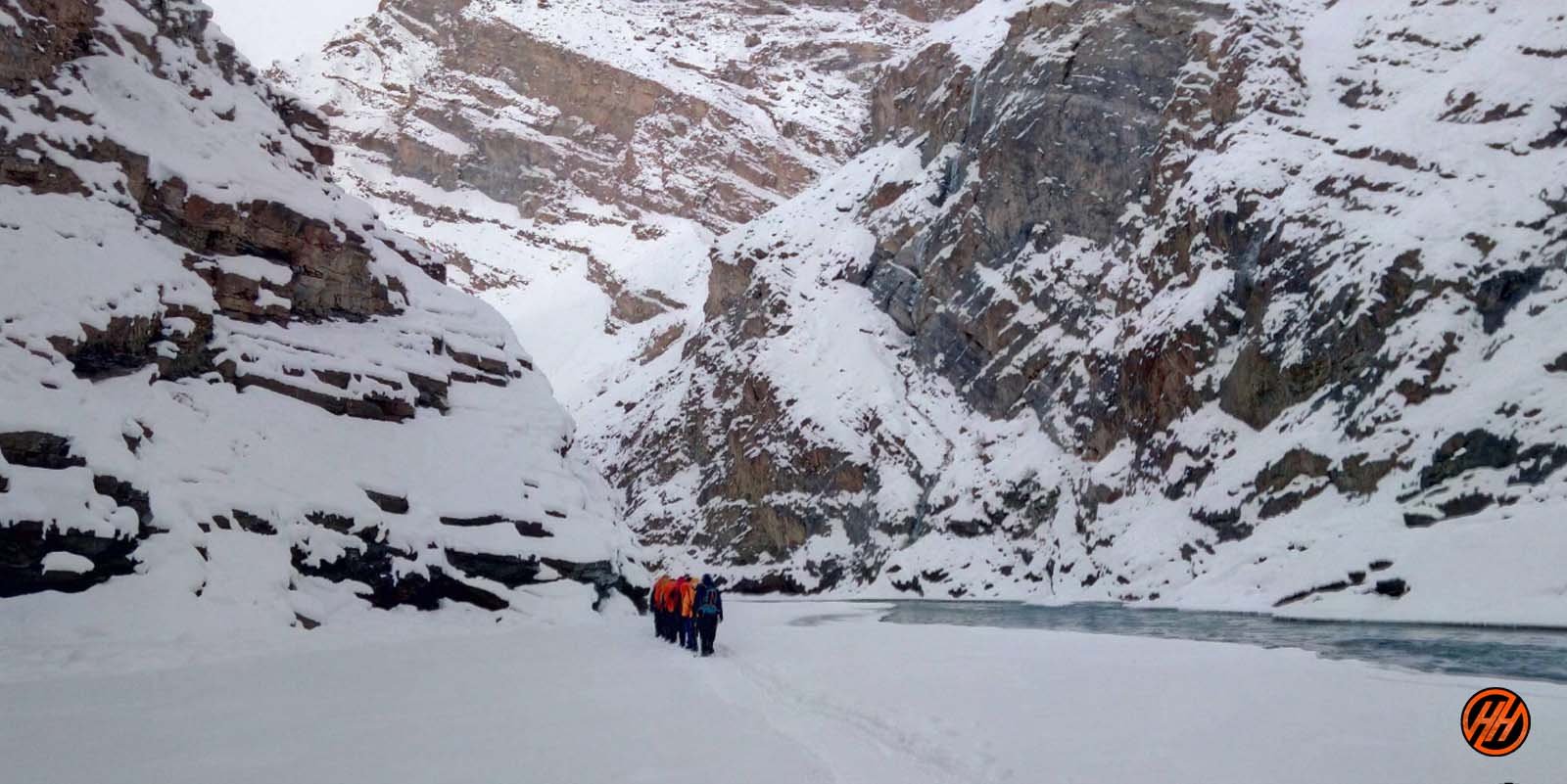
Languages Spoken
Ladakhi is the main language of Ladakh. Other languages spoken are Balti, Shina, Brokshat and Changshat. In hotels and restaurants, staffs speak English and Hindi, while tourist guides are well versed with the language.
Key Points about Chadar Trek
– Level: Difficult (so first-timers trekkers should avoid)
– Proper conditioning & training of body required
– Group size minimum of 05 maximum of 15 people
– Need proper Expedition gear & clothing for sub-zero temperatures?
– Shoes are the single most important equipment
– High Altitude requires proper acclimatization
– Phones don’t work on the trek, we are provide to you Radio Walkie Talkie for Communication
– Beautiful landscape so carry good photo gear (I couldn’t carry my best equipment)
– Travel light (my backpack was heavy at about 12 kg to 15 Kg )
– Keep an extra day in your itinerary for attempt to Chadar trek summit account for bad weather
– Alcohol and smoking is not allowed in during the Chadar Trek Expedition
Difficulty level
Because the top is relatively high in elevation, we strongly recommend a reasonable level of physical fitness. The arduous journey of Chadar trek winter hiking with longer distances and ascending elevations to be covered in a short span of time would require acclimatization. We advise trekkers to physically and mentally prepare themselves prior to this trek. Throughout the course, all groups will be guided by our experts for trekking equipment and any impending terrain.
Any medical assistance that is required will be provided at any point of the journey; however, trekkers must consult their professional care before beginning any trek. We also strongly advise trekkers to learn about altitude sickness and to notify our teams as soon as any symptoms appear.
Short Itinerary of Chadar Trek
Day 1:- Arrival at Leh – pickup to you from Airport drive to Hotel check in Rest and Acclimatization overnight stay Hotel
Day 2:- Trek Planning and Briefing – Acclimatization and Preparation- meet us our Himalayan Hikers Guide overnight stay
Day 3:- Medical Test Day in Leh
Day 4:- Drive from Leh to Bakula (70 km) (2 hours) same Day Trek Bakula to Shingra Koma 2/3 Hours overnight stay Camp
Day 5:- Trek from Shingra Koma to Tibba (16 km) (6/7 Hours) overnight stay Camp
Day 6:- Trek from Tibba to Nerak Waterfall (12 km )( 6/7 Hours) overnight stay Camp
Day 7:- Trek from Nerak to Tibba (16km ) (6/7 hours) overnight stay Camp
Day 8:- Trek from Tibba to Bakula (12 km) (6/7 hours) Same day Drive to Leh Hotel
Day 9:- After breakfast Depart from Leh
permit and passport.
Tourist don’t require permit for Leh, however, all foreigners are required to be registered at Drass, Rumtse and Serchu if they are travelling overland. Those traveling by air get themselves registered at airport. Tourists are required to get permit for restricted areas like Tsomoriri, Tsokar and Pangong Lakes, Dhahanu and Nubra Valley, which can be obtained from District Magistrate, Leh, through Travel Agents at Leh.
Avoid acute mountain sickness
Acute mountain sickness can occur to any one at an altitude above 10,000 ft. above sea level, therefore, make it sure to take complete rest on the day of arrival.
How to Reach Leh or ladakh
Overland Approach
Overland Approach – The overland approach to Ladakh from Kashmir Valley via Kargil is approx. 434 Km, which remains open for traffic from early June to November. The most dramatic part of this road journey is the ascent up the 11,500 feet / 3,505 m high Zoji-La, the pass in the Great Himalayan Wall that serves as the gateway to Ladakh. The J & K State Road Transport Corporation (J&K SRTC) operates regular Deluxe and Ordinary bus services between Srinagar and Leh on this route with an overnight halt at Kargil. Taxis (cars and jeeps) are also available at Srinagar for the journey. Groups can charter Deluxe and A-class buses for Leh, Kargil or Padum (Zangskar) from the J & K SRTC at Srinagar.
Manali to Leh – Since 1989, the 473 km. Manali-Leh road has been serving as the second overland approach to Ladakh. Open for traffic from around mid-June to early October. This high road traverses the upland desert plateau of Rupsho, altitude ranges from 3,660m to 4,570m. A number of high passes fall enroute among which the highest one known as Taklang-La is world’s second highest motorable pass at an altitude of 17,469 feet/5,235m. Himachal Pradesh Tourism, HRTC and J & K SRTC operate daily Deluxe and Ordinary bus services between Manali and Leh. The bus journey between Leh and Manali takes about 19 hours or two days with an overnight halt in camps at Serchu or Pang. Shared taxis are also available both from Leh and Manali
Road Distances
Srinagar-Leh 434 Km
Manali-Leh 473 Km
Srinagar-Kargil 204 Km
Delhi-Leh 1047 Kms
Leh-Kargil 234 Km
Kargil-Padum (Zanskar) 240 Km
Leh-Deskit (Nubra Valley)118 Kms.
Credit Cards & ATM Machine
Credit cards are accepted by very few hotels and tour operators but there will be 2.5% service charge. The Jammu and Kashmir Bank and State Bank of India has placed ATM Machine in Leh. The State Bank of India accepts visa and mastero but this ATM is not very reliable. J&K Bank ATM is more reliable but accepts only Mastero.
Indian Airlines www.indian-airlines.nic.in operates regular flights to Leh from Delhi (fare USD 135), Four flights in a week from Jammu and once in a week from Chandigarh and twice from Srinagar. Jet Airways www.jetairways.com also operates daily flights between Leh-Delhi (fare USD 143).
Internal Transport
The cheapest way to travel within the region is by public buses, which ply on fixed routes according to fixed time schedules. The most comfortable and convenient though expensive mode of travel, however, is by taxi, which are available for hire on fixed point-to-point tariff. For visits to the newly opened areas of Nubra, Dah-Hanu, Tsomoriri, Tsokar and Pangong Lakes. It is mandatory to engage the services of a registered/recognized travel agency for making all the requisite arrangements including internal transport. Detailed information about bus schedules, taxi tariff, travel agencies can be obtained from the Tourist Office or Local travels guide “Reach Ladakh”, available at Book Shops.
Leh is the headquarter of Leh District, and the largest town of the region. It is located to the north of the Indus River at an elevation of 3600m above the sea level. The town is dominated by the nine-storey Namgyal Palace and Namgyal Tsemo (victory peak), built by Tashi Namgyal on his victorious in reunification of the Upper and Lower Ladakh. Leh became the capital of Stod (upper Ladakh) during the reign of king Graspa Bum- Lde,who ruled Ladakh from 1400 to 1430 AD. In the later period, Leh became an important center for trade in Central Asia. Leh remained merely a headquarter of Ladakh district until 1974, when Ladakh was opened for foreign tourists. Since then period Leh became the centre for tourism related activities in the region.
Fact File
Leh provides medium and lower class accommodation, with hundreds of guesthouses and hotels, which can suite every budget. Restaurants offer good multicuisine for a reasonable price. There are number of tour Operator/Travel Agents around the town, which look after traveler’s requirements.
Tour of Buddhist monasteries can be organized in one or two days, as all the famous monasteries are within a drive of one or two days from Leh. For information on monasteries please check monastery section of this web site.
There are several reasons why you may consider going on the Chadar Trek with the Himalayan Hikers Trekking Organisation:
- Experienced guides: Himalayan Hikers Trekking Organization has experienced guides who are familiar with the trek and the local area. They can provide valuable insights into the local culture and help ensure your safety during the trek.
- Safety measures: The Chadar Trek is a challenging trek that requires proper safety measures. Himalayan Hikers Trekking Organization takes safety seriously and provides necessary safety equipment like crampons, ropes, and ice axes, as well as a medical kit.
- Logistics: Organizing a trek like the Chadar Trek can be challenging, especially in a remote region like Zanskar. Himalayan Hikers Trekking Organization takes care of logistics like transportation, accommodation, and food, making the trek a hassle-free experience.
- Reputation: Himalayan Hikers Trekking Organization has a good reputation for organizing treks in the Himalayan region. They have received positive reviews from trekkers who have gone on their treks, making them a reliable choice for the Chadar Trek.
- Support staff: In addition to experienced guides, the Himalayan Hikers Trekking Organization also has a support staff to help with logistics and camp setup. This ensures that you can focus on the trek and enjoy the experience without worrying about the details.
Overall, going on the Chadar Trek with the Himalayan Hikers Trekking Organization can provide a safe and enjoyable trekking experience with the necessary support and guidance.
Day 1 : Reach Leh by Air today is your Reporting day in our hotel (3500 Meter) – night stay hotel
Today arrive Leh, a great tourist attraction. And, the only way you can arrive Leh in winters is by flight, catch the glimpse of snow-capped Himalayas while flying high.
Reach Leh and experience the drastic change in temperature with a touch of cold breeze on your face. Acclimatize and have enough rest today, spend your night comfortably in a hotel.
Day 2 : Rest Day for Acclimatization explore some time Shey Monastery and Thiksey monastery and hall of fame Leh market night stay hotel
Most trekkers go through Altitude Sickness and because of this health issue the government of Ladakh made a rule i.e. anyone who is going for Chadar Trek will spend two days in Leh for proper Acclimatization.
This rule is strictly followed by everyone visiting this place.
Today you can go to the nearby areas, there is a market you can go there. The temperature further will fall when you start trekking over frozen Zanksar, make your body used to the cold temperature.
Stay in a hotel and check all the important things required for your trek.
Day 3 : All trekker wake up early morning or get ready for medical check –up – after lunch our team working insurance working enjoy overnight Leh – night stay hotel
As the rule of Ladakh Government medical check- up of the trekkers in “Tourist Information Center” is mandatory. After the approval you can go for the Chadar Trek and then the trekkers will get their permits and important documents from ALTOA and Wildlife Department.
If you don’t get approved by the officer for Chadar Trek then you can go on “Ladakh Tour” at no extra cost.
Day 4 : Pickup from Leh Drive to Tsomo Paldar by tax
Trek Distance – 73 km – 8/9 Hours journey
Mode of journey – By taxi – 70 km – On foot – 03 km
Altitude – Tsomo Paldar – 3200 Meters
Night Stay – our Camp – on twin/three share basis
Starting of this trek is Shingra Koma, drive through some picturesque places of Ladakh and en route see some place i.e. Magnetic Hill, Gurudwara Pathar Sahib and Indus and Zanskar’s confluence.
Drive is along the Zanskar River and after one and a half hour reach Chilling, the freezing point of Zanskar.
Start your trek over frozen Zanskar, it will be challenging in the starting of the trek to walk with heavy gumboots. Walk carefully and check with the help of your hiking pole if the ice is stable before stepping on it.
Tsomo Paldar is your campsite for today which lies at the river bend surrounded by gigantic peaks and rock faces. Setup your tents after analyzing the place and stability of ice properly.
Day 5 : Trek from Tsomo Paldar camp to Tibb Cave camp.
Trek Distance – 15 km – 6/7 Hours journey
Mode of journey – On foot
Altitude – Tibb Cave – 3300 Meters
You will gain altitude steadily on this trek. Wake up in chilly cold and have hot cup of tea, coffee and salubrious breakfast then head towards your campsite for today i.e. Tibb Cave.
On the way you can have a glance of frozen awe spell binding waterfalls and their origin is not known. Trek next to Zanskar rive which has bluish green water and in middle of the day have your lunch.
Further you will see rock patterns and the campsite today is “Tibb Cave” which is surrounded by sand. Overnight stay in camp.
Day 6 : Trek from Tibb cave to Nerak camp
Total distance – 13 km – 6/7 Hours journey
Altitude – Nerak camp – 3400 Meters
Nerak camp is a frozen waterfall and the most beautiful point of Chadar Trek which lies 13 km away from Tibba Cave and it is your campsite for today. People from different areas desire to come here to catch a glance of this frozen waterfall.
You will get packed lunch which you can have in middle of the journey. This campsite is going to be the most freezing one because the temperature can drop down to -30°C. Wear enough warm layers and stay protected from the chilly cold.
Reach this totally frozen waterfall then go to visit Nerak village. The campsite can be reached in 20 minutes after you’ve reached the frozen waterfall. Setup the tents and retire for the night.
Day 7 : Trek from Nerak camp to Tibb cave (13 km) (6/7 Hours) (3300 Meter) over night stay camp
Trek Distance – 13 km – 6/7 Hours journey
Post breakfast, start the journey back to Tibb Cave. Getting back isn’t easy because the change in temperature changes the Zanksar River and it gets totally different.
While getting back to Tibb Camp you can see the locals wearing their traditional dresses (Woolen Gotchas). The monks can also be seen returning from Lingshed and coming back to Leh. You will be surprised by the way they work in the freezing cold and still have smiles on their faces
Reach Tibb Cave and spend overnight in tents.
Day 8: Tibb Cave to Shingra Koma (13 km) (5/6 Hours) same day drive to Leh
Distance – 83 km – 8/9 Hours journey
Mode of journey – By taxi – 70 km – On foot – 13 km
Altitude – Leh – 3500 Meters
Night Stay – our Camp – on hotel
From Tibb today you will be returning to Leh via Gyalpo and Shingra Koma. On side of the river you can see big and high mountain walls and also the footprints of animals like Fox and Snow Leopards will be visible on the trail.
You can spot Snow Leopards if you’re lucky. Trek over the white sheet “Chadar” this is the last day you will be walking over it. Completing this tricky frozen River trek will be a total different experience.
From Shingra Yokma leave for Leh and you can reach in the evening there around 6:30 am. From Leh return the next day, so book the flight tickets of another day. Stay at hotel in Leh.
Mandatory Documents
Please carry the documents given below.
Original and photocopy of government photo identity card- (Aadhar Card, Driving License, Voters ID, etc, Passport and Visa important to foreigners Medical Certificate (First part should be filled by the Doctor and Second part by the Trekker) Declaration Certificates
Note: – Many trekkers commit the same mistake of carrying unnecessary items on a trek which only makes the backpack heavy. It is important to know the right items to carry. It differs from season to season if you are trekking in summers then carry less layers of warm clothing and if you are trekking in winters carry enough layers to protect yourself against chilly cold.
Necessary Items for trekkers

Backpack (50 to 60 liters) A strongly built backpack with good support is compulsory for a trek. (Rain cover is important)
Sturdy Trekking Shoes The shoes should be strong enough with good support. The people ask if sports shoes would be comfortable but it is good to bring the right trekking shoes.
The Clothes You Should Bring On a Trek Avoid keeping extra clothes because it only makes you backpack heavy.
Trek Pants – The jeans are never suitable for a trek so you need at least 2-3 trek pants for treks carry more for longer treks.
Jacket – Jackets are very important to carry on a trek it protects you against the chilly weather. So carry 2 jackets on a week long trek.
Layers of warm Clothing Carry warm woolen layers or fleece. Carry more layers during winter season (at least 2 to 3) and less during summer.
Thermals – The Temperature decreases at night so you might be need thermals for Night.
T- Shirts – Bring those t shirts which dry fast.
Poncho –They are needed if you are trekking on a Rainy day to keep you dry.
Hiking Pole
Water Bottle 2
Cap or Balaclava
Woolen and Waterproof Gloves
Socks (Woolen and Regular)
Torch head light
Personal Toiletry Items – (toothpaste, toothbrush, toilet paper, sanitizer etc.)
Carry Personal Medical Kit
Personal Medical Kit (Carry minimum 5 tablets and maximum 10)

Diamox – (Prevents altitude sickness)
Digene – (It cures discomfort in stomach, acidity)
Crocin Advance – (Cures fever and headache)
Aspirin/Combiflam – (Pain reliever)
Disprin – (Cures headache)
Avomine – (Prevents motion sickness)
Avil – (It treat allergies)
Norflox TZ & Lomofen – (Prevents Diarrhoea)
Ranitidine – (Reduces the amount of acid in stomach)
Volini/Moov spray – (For sprains)
Betadine/Savlon – (Antiseptic cream)
Stretchable/Elastic bandage
Note:- Use medicines only when prescribed by the doctor. In case you face any problem during your trek, discuss and take advice from the Professional guide.
What is Included In This Trek?
Transport from Airport Leh to Leh.
Sightseeing tour on day two visit Sindhu Ghat Shey palace, 3 Idiot School Thikshey Monastery.
Centrally Heated Rooms – Running hot water ( Day 1, 2,3, or 08 )
Accommodation in Hotel Leh twin sharing Basis
Accommodation in tents on twin share basis
All meals: Breakfast, Lunch, snacks, and Dinner ( provide you During the Trek Day 04 lunch to Day 8 Lunch )
Radio Walkie Talkie for Communication
High quality Dome tents
Sleeping bags
Good comfortable Mattress
Toilet tent
Dining Tent
Kitchen team
Good Experience Trek Leader guide and Technical guide
Medical Kit
Oxygen Cylinders
Technical Equipment for your safety
What is Not Included In This Trek?
Personal Insurance
Personal toiletry Items
Personal trekking gears
Hotel leh food not includes
02 Dose vaccinated certificate please carry with you or Negative – RT-PCR
Domestic flights & Travel insurance ( mandatory)
Please carry your personal use medicine
Backpack and offloading Costs pay to Directly before trek Leh (5000 full Trek)
Inner Line Permit
Meals in Leh and any Sightseeing
ALTOA & Environmental / Wildlife permit fee Approx. 5 k to 8k to be paid on the spot to the Authorities
Note- We serve three meals a day including snacks and soup. A variety of delectable and healthy food is provided which includes; Indian, Chinese and other Western meals. They are nutritious and keep you fit and healthy on the trek. (Veg food or egg).
2 reviews for Chadar Trek
Darshan Shah – November 20, 2020
Please information us about this trek
admin – November 21, 2020
Okay sure, Can you please contact or WhatsApp us at 9756197558 and Main us at [email protected]
Your email address will not be published. Required fields are marked *
Name *
Email *
Save my name, email, and website in this browser for the next time I comment.
Related Tours
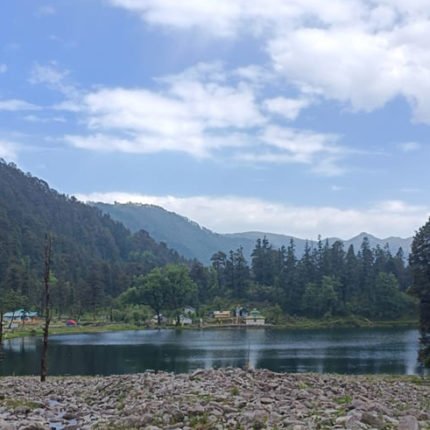
Dayara Bugyal & Dodital Trek
Dayara Bugyal and Dodital Trek follows a similar trek route in Uttarakhand.
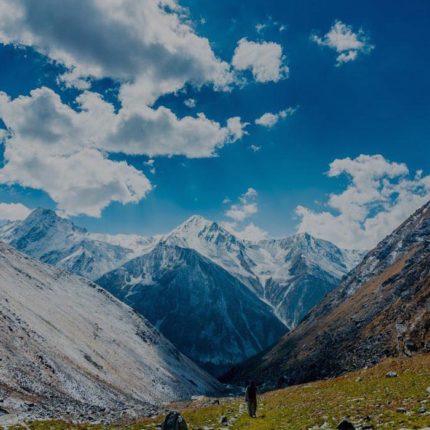
Har Ki Dun Trek
Har Ki Dun Trek is an Enthralling valley in the Garhwal Himalayas
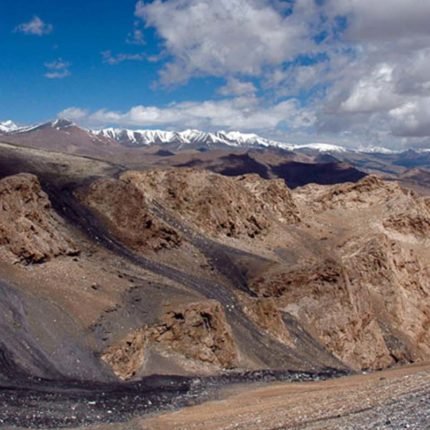
Digar La with Nubra And Pangong Tso Trek
An Amazing “Must Do” Circuit in Ladakh
Price: ₹ 23,000.00
Book the tour
Send a quick enquiry.
- Overview Itinerary Dates Include/Exclude
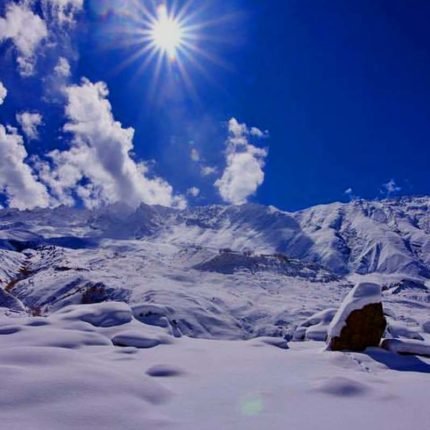
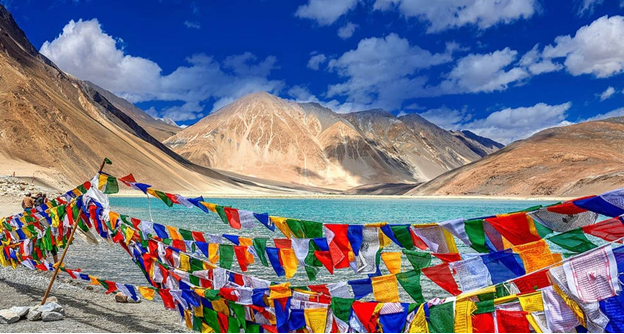
Chadar Trek: A Complete Guide For The Adventure Junkies To Conquer In 2023!
Leh Ladakh the winsome union territory of India. A place for tourists to experience the alluring beauty of the Himalayan peaks. Ladakh is the land full of culture and tradition, and is the best place to experience the playful and cherished atmosphere during the festivals. Being The rooftop of the world and home of some most prominent treks and passes, Leh Ladakh is the best place for tourists to experience the thrill of the mountains. The astonishing beauty of nature and the venture atmosphere all over the land will be a picturesque view. So gear up and get your bikes ready for the trip to Ladakh and experience the mind-blowing activities, treks and campaigns by the side of pristine blue lake, Pangong now. I do not think so, so you have any reason to deny the undeniable trip to Leh Ladakh.
Chadar Trek: An Overview
Ladakh is blessed with numerous natural wonders that make the territory look like heaven, but the best thing needed to be experienced once in a lifetime is the famous trek in Leh. Treks are the first thing that pops up in one’s mind even before planning a trip to Ladakh. The Chadar Trek is the world’s most famous trek in Ladakh. This trek is a beautiful experience with a sight of frozen lake and waterfalls. Chadar trek is all about persistence and survival in the brain freezing sub-zero degree. Zanskar Village’s frozen trail traverses out a white ‘chadar’ that acts as the mirror for the sky. The journey is something that will give you the intrinsic thrill of sleeping in caves and relish the bonfires in the freezing temperature. This trek will let you bump into the rich heritage of the Ladakh people and give you the chance to explore the locals. You will enjoy your trek when you start walking over the frozen Zanskar River with enticing scenic views.
Chadar trek is considered to be one of the most difficult treks. Trekking over the frozen lake and the knee-deep snow make the trek arduous.
The weather in Ladakh will make you shiver during the day and freeze you at night. It will drip down from -5 degrees during the day to -30 degrees at night. The chill atmosphere will make you feel shivery at night. It gives you the feeling of sleeping on a glacial bed. You will experience the lowest temperature while you were campaigning at Nerak during the night.
Your adventure begins when you get the chance to meet the occult Magnetic Hill. Gurudwara Pathar Sahib is also one of the spots where you can enjoy the spiritual sight before going on your journey to the paradise of trekking. Here you will not only get to go on the world-famous trek, but it will also allow you to come across the historical district consisting of rich Ladakhi culture and tradition, even the home for some amazing monasteries representing their patriarchy. Indus and Zanskar will be an ideal spot where you will come through some hallucinatory sights, and the bewildering background of the frozen Nerak Waterfall will leave a strong impression on your mind for a long time on your vacation from this paradise.
Things to Keep in Mind before going Chadar Trek
While trekking at Chadar trek, the most important thing is to be aware of certain conditions. There are some factors to keep in mind to ensure a safe journey.
- You must be aware of the condition of ice sheets.
- While trekking on ice, you have to be attentive and avoid the cracks, if any.
- Thick coated snow is the perfect place to walk over normally.
- Be careful while walking over the slippery portion.
- Yes, a sudden crack may occur under your feet, but you have to be careful and move to the solid footing immediately.
- Choose your camping location wisely, keeping in mind the conditions.
Advisories for Chadar Trek
- Trekking during the night is super risky and can lead to unwanted circumstances.
- This trail is known for its pristine beauty, so it is your responsibility to maintain the serenity of the surroundings.
- Avoid pointing fingers towards the locals, and they might get offended.
- The temperature here is below twenty-degree then freezing point, so choose your attire carefully.
- You have to be fit if you are willing to do this trek.
- A medical certificate is a mandatory requirement for one. Without that, you will not be allowed to participate.
- Please do not take the risk of wearing sport shoes or some casual shoes as it may risk your grip over the snow.
- One must carry their medicines as there are no pharmacies available on the Chadar trek.
- This trek is not recommendable for females over three months pregnant who went through major surgery or had a broken leg or arm for safety purposes.
- Carry some cash as you will find no ATM on your trekking trail.
- Last but most important, if you want your journey to be relished and safe, follow the proper guidelines given by the trek leader.
Things to Carry for Chadar Trek
- Back pack (50l-60l) with waterproof linings
- Day pack (20l-30l)
- Extra batteries
- Woollen cap, socks, gloves and scarf
- Windcheater (waterproof)
- Mosquito repellent
- Walking stick
- Rain cover
- Toilet paper and wipes
- Thermal innerwear
- Water bottle
- First aid kit
How to Reach?
Easiest way to travel to your wonderland location is by airways. You can get a direct flight to Kushok Bakula Rimpochee Airport, the nearest airport to Leh, connected with Delhi Airport and Srinagar, Jammu, Chandigarh and many more major locations. You can also reach the destination by road.
Now, it is time for you to get lost in the alluring beauty of the Himalayas. This trip can be an achievement of your life where you will come through an unknown feeling that will let your soul feel the freeze of the atmosphere. So what are you waiting for? Pack your bag, and Let’s Ride!! Through snow to walk over the ice sheets of the Zanskar river. Also Read, A Mesmerizing Journey to the Valley of Flowers
- Latest Posts
- Discover the Top 5 Skincare Products in India - 3 January 2024
- How To Get Popular on Instagram In No Time?- 6 Expert Tips To Go Viral - 13 December 2023
- Domination of TikTok Marketing: 8 Quick And Effective Tips To Boost Your Likes And Followers - 11 December 2023
Leave a Reply Cancel reply
Your email address will not be published. Required fields are marked *
We are glad you have chosen to leave a comment. Please keep in mind that comments are moderated according to our comment policy .
© All Right Reserve PenYourThought 2024
Altitude Adventure India
The Indian Trekking Tribe
- Destination
- Chadar Trek 2024
Chadar Trek 2024 - 9 Days
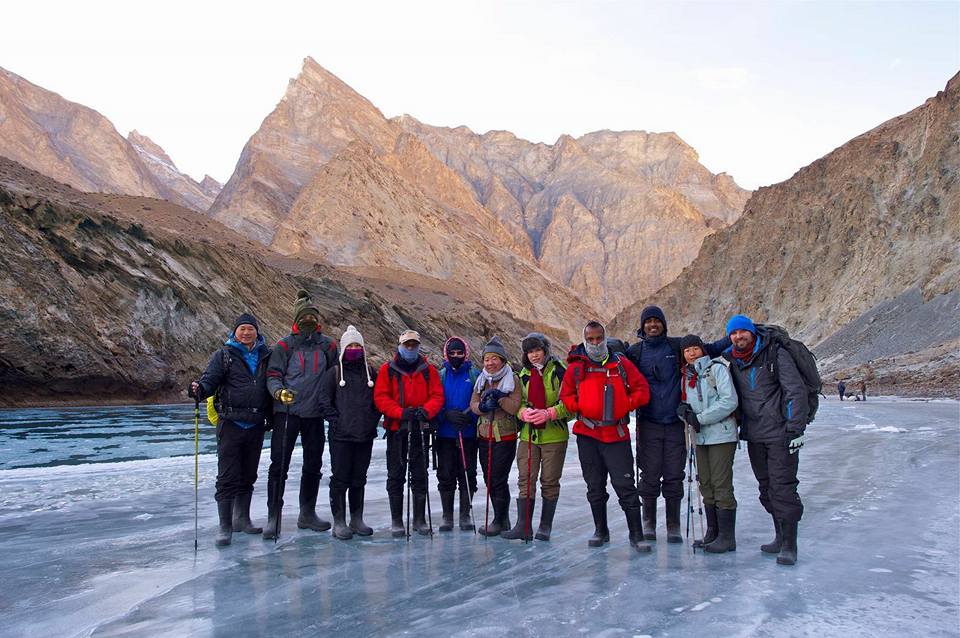
BRIEF Itinerary
Detailed itinerary, cost inclusions & exclusions, things to take, cancellation policy, getting there, trek reviews, altitude adventure india has opened bookings for chadar trek 2024..
All our batches are guaranteed departure.
**SPECIAL OFFER for Limited Period**
Reserve your slot by paying a token amount.
Chadar Trek is one of the most challenging and also one of the most beautiful treks in the Zanskar region of Indian Himalayas.
During winter, Zanskar gets cut off from the rest of the state. The Pensi La, which is the usual route from Ladakh to Zanskar gets snowed out, making vehicular traffic impossible at this time of the year.
For years now, the frozen Zanskar river has been the only way for the people of Zanskar to make contact with the outside world in winter.
It used to be a busy trade route back in the day. The Zanskari used to visit Leh to trade butter, cheese and animal hide for household items such as food grains and clothes.
Though the Zanskaris are self-sufficient these days, there are still a lot of the locals who use this route, keeping the tradition alive. The frozen Zanskar river thus got its name – the Chadar, a magnificent white sheet of ice and snow that flows through some of the most rugged rock faces.
And this setting makes it one of the most stunning treks in the world. Chadar Trek is a walk on the frozen Zanskar River where temperatures drop down to -35 degrees at night in winter.
The ration and all pieces of equipment required for the trek are all transported on sledges.
The real magic exists below your feet and you are unlikely to have seen anything quite as remarkable as this frozen river stretching far away out of sight.
Watching the spell-binding panorama as you walk will give you memories that you will cherish forever.
The highlight of the chadar trek is a beautiful frozen waterfall that you will see near Nerak village. Hidden between two hillocks is this natural formation of a 50ft frozen waterfall masterpiece which can only be seen to be believed.
You get to know the culture of the people living in this region up close through the locals you meet on the trek and also our support staff as most of them are from Zanskar.
The best time to do the chadar trek is in the months of January & February.
Altitude Adventure is reputed as one of the best chadar trek organizers in India.
For FAQs and Complete Preparation Guide of Chadar Trek Click Here
Brief Itinerary of Chadar Trek :
Day 01: Arrival in Leh (3500 m)
Day 02: Acclimatization Walk in Leh
Day 03: Getting a medical check-up
Day 04: Drive Leh to Shingra and trek to Shingra Koma
Day 05: Trek Shingra Koma to Tibb
Day 06: Trek Tibb to Nerak Camp
Day 07: Trek Nerak to Tibb
Day 08: Tibb to Shingra & Back To Leh
Day 09: Departure from Leh
You will arrive by air as there is no road connectivity to Leh in the winter months. Before you land get you get a beautiful bird’s eye view of the entire city and the layers of snow-clad mountains. Ensure that you carry your woolens in your hand baggage and wear them before you exit the plane as you will be greeted with sub zero temperature even during day time. Leh airport is one of the highest airports in the world and also very picturesque but you can’t click any photos as it is a defense airport. When you exit the airport you have a pre-paid taxi corner on the left of he gate where you need to mention your guest house (Name will be given to you) and the taxi will drop you safely to the guest house. The drive is no more than 15 minutes as Leh is a small town with all guest houses near to the airport. Relax at your guesthouse and explore the market post noon. Get used to the cold weather by going outdoors so that it would be easier for you on the trek if you get acclimatized to the cold. Leh is quite in the winters and very few shops and eateries are open for business. Take a stroll through the colourful Leh market during the day and buy your woolens or any other items if you have missed before leaving home. During your stay, drink plenty of fluids in any form including soups, lemon tea, black tea or just plain water during the day to help your acclimatization.
This is your second day of acclimatization. As per the regulations and keeping in mind the health problems that trekkers might face related to Altitude and Cold, anyone doing the Chadar Trek should spend at least three days in Leh for the body to get fully acclimatized to the weather conditions. It is now mandatory and is to be strictly followed by every trekker. Trekkers can spend the day by visiting the places around the city. Drink plenty of fluids in any form including soups, lemon tea, black tea or just plain water during the day to help your acclimatization.
This is your third day &final day of acclimatization. From 2019 onwards, the local administrations has made it mandatory for every participant to acclimatize in Leh for 3 days. Today you will undergo a medical examination at the SNM Hospital in Leh prior to the Trek. They will issue a fitness certificate after the examination and only those who have this certificate will be allowed to Trek. This is done keeping in mind the health problems that trekkers might face related to altitude and cold during the Chadar trek. This is for your own safety and it is to be strictly followed by every trekker. Read our blog about preparing for the Chadar trek so that you can clear the fitness test easily.
Today we leave in our vehicles and drive towards Chilling and further to Shingra. The drive is quite scenic and you get to see the beautiful Indus river on the way and also the confluence of the Indus and Zanskar river at Nimmu. We cover a total distance of 70 kms by road and It should take about 2 hours to reach Shingra. This is the point where the road ends and you will leave the vehicle, collect your backpack and start walking towards the river. As soon as you put your foot on the frozen Zanskar river you will get excited about your trek. Your leaders will soon give you tips on how to walk on Chadar. It takes a while to get the hang of it. It is called the ‘Penguin Walk’ as you need to drag or shuffle your feet the way penguins do. Walk around as much as possible in this style before the trek begins as it will help you get comfortable walking on glassy ice sheet. As the trek begins, you will fall a few times till you fully understand the different ice forms and patterns. Slowly you will know which surface is brittle and which is solid and you will not fall. Falling and learning to walk on the Chadar is all part of the overall trek experience. After couple of hours of trek, you will reach your first campsite at Shingra Koma. You will reach the camp site before sundown. Ensure that you cover yourself with extra layers after reaching the campsite as cold winds start immediately after sundown. Have your dinner and fill your thermos with warm water before you go to sleep . All liquids tend to freeze in this region given the extreme temperatures, so a thermos is extremely important as you may wake up in the night feeling thirsty.
After spending a cold night in the tent, you will be delighted to hear the call for a morning tea from our support staff. The Zanskari people are well known for their hospitality and they will wake up way before you to ensure you have a hot cup of morning tea in the tent. They will also give you a wholesome breakfast and reactivate your energy in the morning in such sub-zero conditions. Today you start trekking towards Tibb cave which is our next campsite. This trek route has some of the most attention-grabbing frozen waterfalls that one can encounter. It also going to be a long walking session, as you will cover a total 14 kms (approx 6-7 hours) on the Chadar. Marvel at the views as you walk in this huge valley with the Zanskar river flowing in the middle. The river is vibrant as it flows by and the color of the water is deep blue. Sometimes you will see water flowing right beneath you under the thick ice sheet. Our staff will cook you a warm meal mid-way to Tibb cave and give you a hot cup of tea after the meal. You’ll be at Tibb around 3 pm. Tibb cave is encircled by dry sand and your tents will be pitched somewhere around the sandy area. Walk around the camp area to keep yourself and also remember to add your layers nearing sundown.
Today it is going to be another long day, so you will start early to move towards Nerak which is the most anticipated campsite of the trek. At Nerak you will get to see a wonderful natural formation, a frozen waterfall approx. 50 feet high, which has become iconic with the Chadar trek. We aim to reach Nerak campsite before 3pm, so you get plenty of time at the Nerak frozen waterfall. Hot lunch will be served on your way to the campsite. Nerak is the coldest campsite on the trek where the temperature can down to -35 degrees at night. Trekkers are advised to wear proper layers to stay safe from the freezing cold. Nerak campsite is 15-20 minutes before the waterfall. Once we reach the camp site. we will have some snacks and then make our way to the gigantic Nerak frozen waterfall. Right next to the waterfall is a bridge across the river, which takes you up to Nerak village. If time permits you may go to Nerak village, else marvel at the beauty of the frozen waterfall and click few pictures before heading back to the campsite for dinner. Camp overnight at Nerak.
Today, we trace our trace our steps back to Tibb campsite. Even though the route remains unchanged, it’s amazing to see how different it appears while we return. This is because the river can rapidly react to any change in the temperature. By this time the icy river might have taken a completely new form. You may not be able to recognize few sights, as it all seems so different on the way back. You might walk on a glass like surface or patches of slush, depending on the weather. You are now more confident of walking on the way back and there is less probability of falling. Admire the beauty of the valley as you walk confidently looking around and click pictures. On the return journey, observe the local porters and their traditional attire. They wear traditional woolen robes called ‘Gonchas’, with colourful beads around their neck and their traditional hats. It’s fascinating to see the locals swiftly walking on Chadar, as they seem to glide like the wind, absolutely comfortable with the slippery uneven icy surface. Greet them in their local phrase ‘Julley’ which is the Ladakhi term for hello/welcome. You might also catch a few locals singing traditional ladakhi songs while pulling their sledges and enjoying the journey. Reach Tibb Cave and camp overnight at Tibb.
Today we have along walk, so we start early afer having a hot breakfast for Shingra Koma. En route you will get a chance to see high mountains and may get to observe pug marks of wild animals like ibex and foxes. If you are lucky enough, you just might spot a snow leopard; and in any case you don’t, then at least be sure, you would be watched by them. Today is your last day at the Chadar and a feeling of missing this beautiful landscape will slowly creep in and you would wish that the trek doesn’t end. When you reach Shingra, it is time to say goodbye to the Zanskar Valley. Vehicles are waiting for you to take to Leh. Some trekkers want to celebrate and instinctively take a dip in the river. This is best avoided as you may not be used to such cold water. As you head back to the hotels in your vehicles you cant help but remember the entire experience like a movie projection in front of your eyes. Reach Leh and stay over nite at your guest house.
The journey comes to an end. You get ready to depart and say goodbye after having your morning breakfast. Return back home with lifetime of memories
How safe is the Chadar trek?
- We have designed our itineraries to allow for adequate acclimatization in Leh, yet there are chances that you will feel the effects of altitude sickness and oxygen deprivation while on this trek. Please be aware that your trek leader may deem it unsafe for you to continue trekking at any time, and arrange for you to return back to Leh.
- From 2019 onwards, the local administrations has made it mandatory for every participant to acclimatize in Leh for 2 days and on 3rd day undergo a medical examination at the SNM Hospital in Leh prior to the Trek. They will issue a fitness certificate after the examination and only those who have this certificate will be allowed to Trek. This is done keeping in mind the health problems that trekkers might face related to altitude and cold during the Chadar trek. Read our blog about preparing for the Chadar trek so that you can clear the fitness test easily.
- Our trek leaders will conduct routine health checks at all camps to measure oxygen saturation, and pulse rate. Altitude Adventure reserves the right to exclude any trekker from continuing the trek without refund if the trekker’s vital readings are below accepted norms.
- This is a high altitude trek with rough, rocky and snowy terrain. It is important that you are a fit and confident walker in mountain terrain, able to complete certain distances by yourself within a reasonable time. Altitude Adventure reserves the right to send a trekker back if, in the opinion of our trek leader, they are unable to complete the itinerary without requiring exclusive assistance. Please realistically self-assess your fitness and suitability for this trek before registering.
The Trip Cost Includes
- Inclusive of Tax
- 04 Nights tented accommodation on triple sharing basis while on the trek.
- 04 Nights Home stay/Guest House accommodation in Leh on triple sharing basis (Day 1, Day 2, Day 3 and Day 8 as per the itinerary)
- All meals (Vegetarian + Egg) from Lunch on Day 4 to Lunch on Day 8
- Tent (Triple Sharing), Sleeping bag, Sleeping Mattress, Tent Kitchen & Dinning tent, toilet tent, utensils.
- Basic First Aid Medical kits
- Qualified and experienced Trek Guide and support staff.
- Transport from Leh guest house to Shingra and return as per the itinerary
The Trip Cost Excludes
- Wildlife Fee/Environment Fees
- Medical expenses (apart from first aid) and insurance of any kind.
- Airport Transfers
- Any expenses arising out of unforeseen circumstances like strike or any other natural calamities or any emergency evacuation expenses.
- Meals in Leh
- Porter to carry personal luggage
- Anything not mentioned in above inclusions.
- – Backpack (50-60 Ltrs) with Rain Cover
- – Trekking Shoes. (Preferably Quechua Forclaz Hiking Boots)
- – Gumboots (Can be purchased in Leh)
- – 4 Pairs of Full sleeve shirts/T-Shirt
- – 2 Pairs of Track Pants
- – 1 Pair of Waterproof Pant
- – 4 Pair of cotton socks. 3 pairs of woolen socks.
- – 1 Full Sleeve Fleece
- – One Down Jacket
- – 1 Wind Jacket
- – 2 Pairs of Thermal Inner
- – 2 pair waterproof hand gloves
- – 2 Pair woolen Gloves
- – 1 Neck Warmer
- – Sun Cap
- – One Scarf
- – Light towel
- – Lip Balm
- – Cold Cream & Sun Screen (SPF 40+)
- – Water Bottle 1 Lt – Thermos
- – Headlamp or torch with a fresh pair of batteries
- – Personal Toilet Kit and toilet paper
- – Personal Medicine Kit
- – Dark Sunglasses (U/V protected)
- – Walking Stick (At least one)
- – People who were spectacles- Should avoid contact lenses and use photochromatic glasses instead.
The Chadar Trek is a moderate trek suitable for first time trekker with basic to above average fitness. The trail is fairly laid out path and doesn’t not have any steep ascends or descends. Water is easily available throughout the trail.
But, at high altitude as the air gets thinner oxygen is less abundant and you will find difficult to breathe. However, the human body has adaptations to altitude that allow it to partially compensate for the lack of oxygen provided you give sufficient time to acclimitise. We have given 3 days in the itinerary to sufficiently acclimatize your body to high attitude and weather conditions.
Trekking Experience: Prior trekking experience is helpful for this trek but not necessary.
Fitness Required: A high altitude trek in the Himalayas requires considerable fitness. Your body needs to train itself to process more work with lower levels of oxygen. Cardiovascular training before a trek is critically important.
Though the trek is in the Moderate category prior training is mandatory before attempting the trek. Registering for the trek is an understanding that you will undertake the mandated fitness training. Altitude Adventure has the right to reject candidates who do not meet our eligibility requirement at the base camp.
Our trek itinerary is planned in a way that on an average you have to cover around 12 kms in 8 hours although there may be slight variation depending on the terrain. This works out to roughly 1.5 kms per hour which is equivalent to walking in the plains at 6 kms per hour.
Here is the training schedule to prepare for the trek.
You can train yourself to run 3 kms in 30 minutes as per the schedule given below. Remember always start your training program with stretching and warm up exercises.
Stretching: Stretch your hamstrings, quadriceps, hip flexors, lower back muscles and shoulders.
Training schedule for 1 Month:
Week 1: Start with 10 minute of brisk walk and then jog for 10 minutes and finally 10 minutes of easy walk.
Week 2: 5 minutes of brisk walk 15 minutes of jog 5 minutes of easy walk
Week 3: 5 minutes of brisk walk 15 minutes of jog 5 minutes of easy walk
Week 4: 5 minutes of brisk walk and jog for 25 min and cool down your body
If you are somebody who prefers cycling over running, then try to cover 22 km in 60 minutes.
Record your run on an app like Nike Run or Sports Tracker to have a better understanding of your routine. Start recording your run when you start running. At the end of your run, hit the stop button. Review your run on the app to see how you performed on that day and continuously monitor your progress
Note: Make sure your GPS is on when you record your run.
Strength Training – There is a lot of trekking distance that you will cover in high altitude carrying your backpacks. It could be taxing for your legs. For this, strengthening your legs will help. You can do some squats to strengthen them. Start with 2 sets of squats with 8 squats in each set and work towards 4 sets of squats with 20 in each set in 4 weeks .
Given below is our cancellation policy.
If a trek is called off by us at the last moment due to a natural calamity/ unforeseen circumstances (like rains, earthquake, landslides, strike, bandh, curfew, etc), Altitude Adventure India will issue a trek voucher for the full amount. The voucher can be redeemed for the same trek or another trek in the next one year.
If you cancel your trek, the cancellation charges are as given below:
- Cancellations prior to 30 days from the start of the trek –full refund.
- Cancellation between 30 days and 20 days to the start of the trek –50% refund.
- Cancellation less than 20 days to the start of the trek –no refund.
Please note:
Refunds will be processed within 7-10 working days from the date of cancellation.
In case of refund, there will be a deduction of 5% (bank charges) from the total fee you have paid.
If you wish to cancel your trek, please e-mail us on [email protected] or fill the Trip Cancellation form . Cancellation requests are not taken over phone.
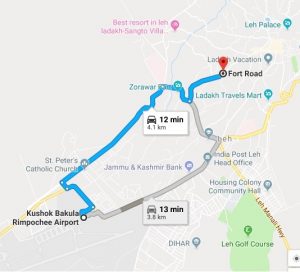
Frequently asked Questions
The best time for Chadar Trek is in the months of January and February. This is the time winter is at its peak in Ladakh and it freezes the Zanskar River and we are able to trek on this frozen Zanskar river.
Chadar Trek difficulty level is considered as Moderate but the weather conditions make it a challenging trek as the temperature oscillates between minus 25 degree Celsius to plus 5 degree Celsius. Though the terrain is fairly gradual as you will be trekking over the frozen Zanskar river which is a flat walk but in case of broken Chadar you will have to climb over some boulders or at some places get into ankle deep icy cold chilling water. If you have proper gear for such situations, like gum boots for walking in ankle deep water then this is not much of a problem.
Chadar Trek temperatures during the day will be -5 to -10 degrees and during night it will in the range of -15 to -25 degree. These readings may sound scary but it just takes few days to get acclimatized to these temperatures. If you have layered yourself with proper clothes then you need not worry. During the day you are walking so you will be warm and during the night your will be safe in your tent and sleeping bags.
Normally our trek are designed in such a way that we reach our camp by before 4 pm and on an average trekking distance is roughly 10-12 Kms each day and it takes around 6-7 hours for an average trekker to cover that distance.
Diamox helps in acclimatization at high altitude. It is absolutely safe to take Diamox and we have some trekkers who start the dose even before reaching Leh when they depart from their home. In case you havent taken beofre arriving at Leh, we will check your oxygen level on arrival. If your reading are not normal then we may advise you to take it.
All our treks are led by experienced trek Leaders. We try and hire from local people only so that they have good opportunity for employment and they know the terrain and conditions exteremely well. Other than a Trek lead we in our team we will have local Guides, Cook, Helpers and Porters from the Zanskar region.
Normally our group size is around 15-20 trekkers only so that the entire group can get along very well and have a memorable trek with us.
Our Fixed departures are guaranteed even if there is a Single trekker we will proceed.
Mountains are much safer then city roads and we say it with conviction. We have lots of solo female trekkers who join us. We ensure that only female trekkers share the tent with other female trekkers.
– Backpack (50-60 Ltrs) with Rain Cover – Trekking Shoes. (Preferably Quechua Forclaz Hiking Boots) – Gumboots (Can be purchased in Leh) – 4 Pairs of Full sleeve shirts/T-Shirt – 2 Pairs of Track Pants – 1 Pair of Waterproof Pant – 4 Pair of cotton socks. 3 pairs of woolen socks. – 1 Full Sleeve Fleece – One Down Jacket – 1 Wind Jacket – 2 Pairs of Thermal Inner – 2 pair waterproof hand gloves – 2 Pair woolen Gloves – 1 Neck Warmer – Sun Cap – One Scarf – Light towel – Lip Balm – Cold Cream & Sun Screen (SPF 40+) – Water Bottle 1 Lt – Thermos – Headlamp or torch with a fresh pair of batteries – Personal Toilet Kit and toilet paper – Personal Medicine Kit – Dark Sunglasses (U/V protected) – Walking Stick (At least one) – People who were spectacles- Should avoid contact lenses and use photochromatic glasses instead.
We expects all trekkers to carry their own backpacks. When you are in mountains you never know what situation you will be in and that is the reason we suggest our trekkers to strictly carry the Chadar Trek essentials list. Yet, if for some reason you are unable to carry your backpack, you can offload the same by paying an additional charge. Backpack offloading charge is Rs. 700 per day. Partial offloading is not allowed. You have to pay for all 5 days i.e 3,500 + GST. The backpack cannot weigh more than 9 kg. No suitcases/strolleys/duffel bags will be allowed. Last minute offloading is not allowed on this trek. You will need to book offloading prior to the trek.
Good trekking shoes and Gum boots are must for Chadar Trek. Gum Boots are easily available in Leh market from Army Canteen shops and almost all trekkers to Chadar trek buy them from these shops. They cost around Rs 800-900 for a pair. You may buy regular trekking shoes from decathlon or any sports store near to you before coming to Leh.
Due to the extreme temperatures it is advisable to have 3 people in one tent. We use three person tent and for couples it will be single tent only.
Good physical fitness as well as mental fitness is required for Chadar trek. To get a optimum level of fitness you can go through our article- How to prepare for the trek.
We server wholesome and nutritious Breakfast, Lunch, Dinner and Evening Snacks. Normally it’s all veg to keep off wild animals but we do serve eggs.
We use natural Himalayan spring water and it is considered absolutely safe and clean.
We use Sumo/Xylo/Innova/Tempo for transportation.
We carry First aid kit and normal medicines with us and in case of other medical emergencies we rescue the trekker till the nearest road head. No doctors are available nearby. A vehicle has to be arranged till Leh to get medical facilities. Additional costs are involved for emergencies and they will be borne by trekker only. Before the trek it’s your responsibility to get a medical fitness certificate.
Yes you have to bring your personal medicine kit which includes your routine medicines and following medicines as well. Bandage for sprains Plasters/Band-aids Iodine or water filter (optional) Moleskin/Second skin – for blisters Antiseptic ointment for cuts Anti-bacterial throat lozenges (with antiseptic) Aspirin/paracetamol – general painkiller Oral rehydration salts Broad-spectrum antibiotic (norfloxacin or ciprofloxin) Anti-diarrhea medication (antibiotic) Diarrhea stopper (Imodium – optional) Antibiotic for Giardia or similar microbe or bacteria Diamox
You can book it online https://www.altitudeadventureindia.com/trip/chadar-trek-2020/ and once the payment is made you will get a trek booking voucher. We will also send you a confirmation mail for the same. In case you don’t hear from us, you may mail us the transaction details with Trek name, Trek dates, Name, Mobile no. on [email protected]
We reserve the right to change the itinerary depending upon the weather condition and other factors. If any extra cost arises it will be borne by trekkers only. Please note that this is a trekking trip into the remotest region & harshest conditions, where many unforeseen events may force us to change the itinerary. In such cases, we or your trek leader will suggest the best alternative similar to your original itinerary.
Yes Chadar Trek can be customized. If you would like to travel independently, you are invited to choose any of the trips at your convenient time frame for any number of people. Cost for private trip is fixed on the basis of group size, duration and trek style. Send us an Email on [email protected] for Customised treks.
We will offer you an alternate trek of equal no. of days depending upon the weather conditions. All the arrangements for the tour are pre-planned and prepaid. In case of not completion of the tour due to any reason whatsoever there will not be any refund for any unutilized services. Any extra expense due any alteration has to be paid extra.
Write a Review Cancel reply
Thank you. Your review will appear after admin approves it.
Please fill all the fields.
Your email address will not be published. Required fields are marked *
Review Title
Date Of Experience
Photo Gallery Invalid File Type. Supported File Type: JPEG/JPG, PNG. Drag & Drop files here or click to browse
Save my name, email, and website in this browser for the next time I comment.
Why Altitude Adventure India?
Best Price Guarantee
Expert guidance on preparation for beginners
Online booking for all treks with instant confirmation.
Have questions ? Get answers to your Trek related queries. Message us on Whatsapp
Payment method.
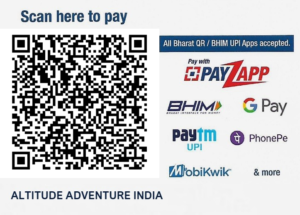
Recent Posts
- Chadar Trek Medical Test
- Our Chadar Trek Guides and Heroes
- Chadar Trek Packages – Complete Information
- Is the Chadar Trek Safe for Girls?
- Brahmatal Trek – An Enchanting Winter Trek
- Sar Pass Trek – An Ideal Trek for Beginners
- Sandakphu Trek – A Complete Trekking Guide
- Leh to Pangong Lake
- Leh to Nubra Valley
- About Rohtang Pass – Manali

Chadar Trek Adventure Right to your Inbox
Even though its still some time for Chadar Trek season to begin, we’ll be in touch with travel stories, updates and tips to help prepare for Chadar Trek.
And don’t worry, we hate spam too! You can unsubscribe at anytime.
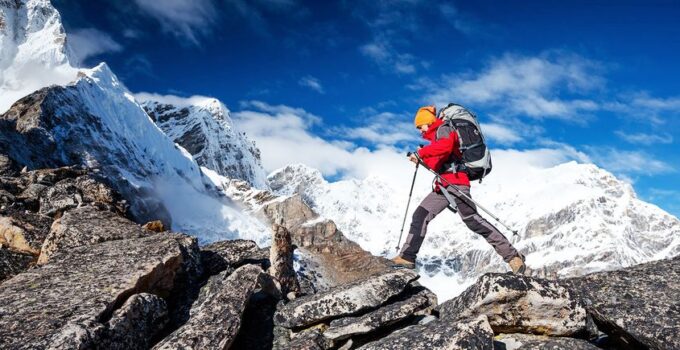
Trek Alert: Plan The World Famous Chadar Trek For 2024
If you are an avid trekker then Chadar Trek in India should be on your bucket list. And you certainly need to plan it for year 2024 as you might not be able to undertake this world famous trek afterwards. Why?
Before we jump into the reasons on why you must plan it immediately, let’s take you back in time to know the history and highlights of this 105 km adventurous frozen river trek. Check the Chadar trek complete itinerary by Bikat Advent ures .
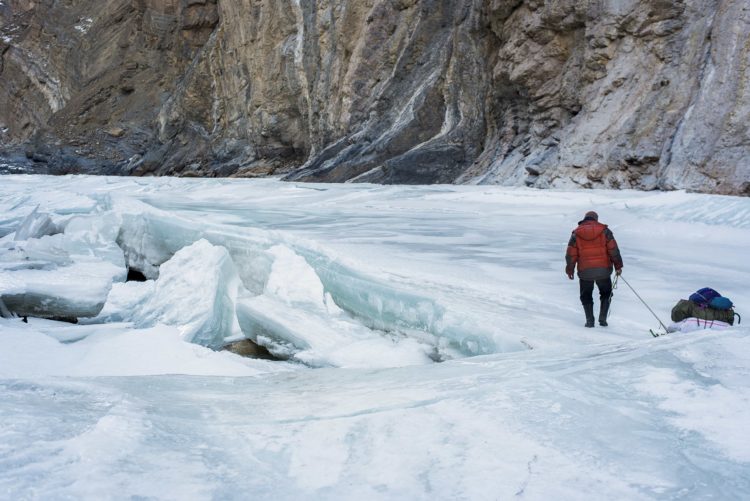
Page Contents
History of Chadar Trek
The Chadar has been a historical trade route between the Zanskar Valley and Ladakh for over 1000 years. Connecting the Zanskar Valley, one of the most isolated regions of Ladakh, with the rest of Ladakh the Chadar has been used by the local Zanskari people for trade and commercial purposes since ages. Known as the “Khado Sanglam” in the local language, it has been a part of the ancient Silk route for centuries.
When the high mountain pass of Pensi La is closed during winters due to heavy snowfall, the residents of Zanskar are landlocked and are unable to move in and out of the valley except for commuting on the frozen river for hundreds of kilometers. These people have been braving such walks for provisions, trade and other commercial reasons.
This route was initially used to trade butter, salt, and other items in winter which was the only time these items could have been carried to the city of Leh without being spoilt. Continuing the same tradition, locals still go back and forth on this route trading modern commodities and gears, taking their children to schools in Leh, and visit places of scared value.
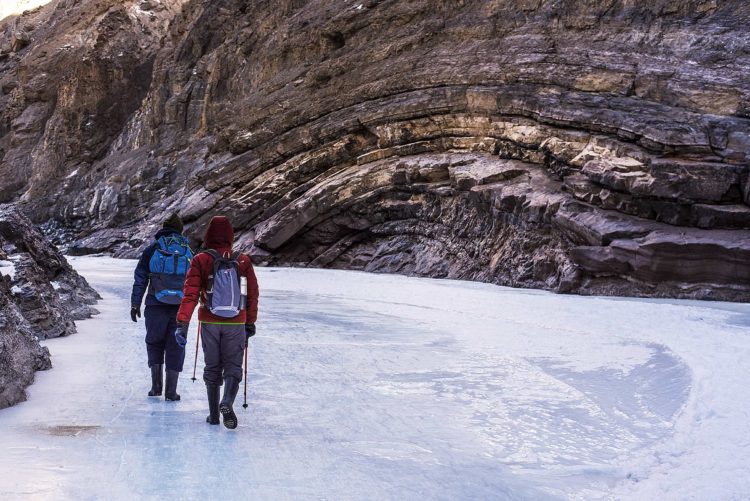
Why is Chadar Trek popular?
For trekkers around the world, the Chadar Trek is no less than a spectacle. The chance of walking on a sheet of ice over a river is the ultimate experience. It gives a glimpse into the lives of people residing in the Zanskar Valley and how they commute during the winter months when they are completely cut off from the rest of the world due to heavy snowfall. Not only do you get to trek on a frozen river, but you also get to bear some of the coldest temperatures in the range of -10 degrees to -30 degree Celsius. Blessed with unique landscapes, habitable caves, and frozen waterfalls, nowhere in this world you will find such a unique trek. A once in a lifetime experience packed with adrenaline.
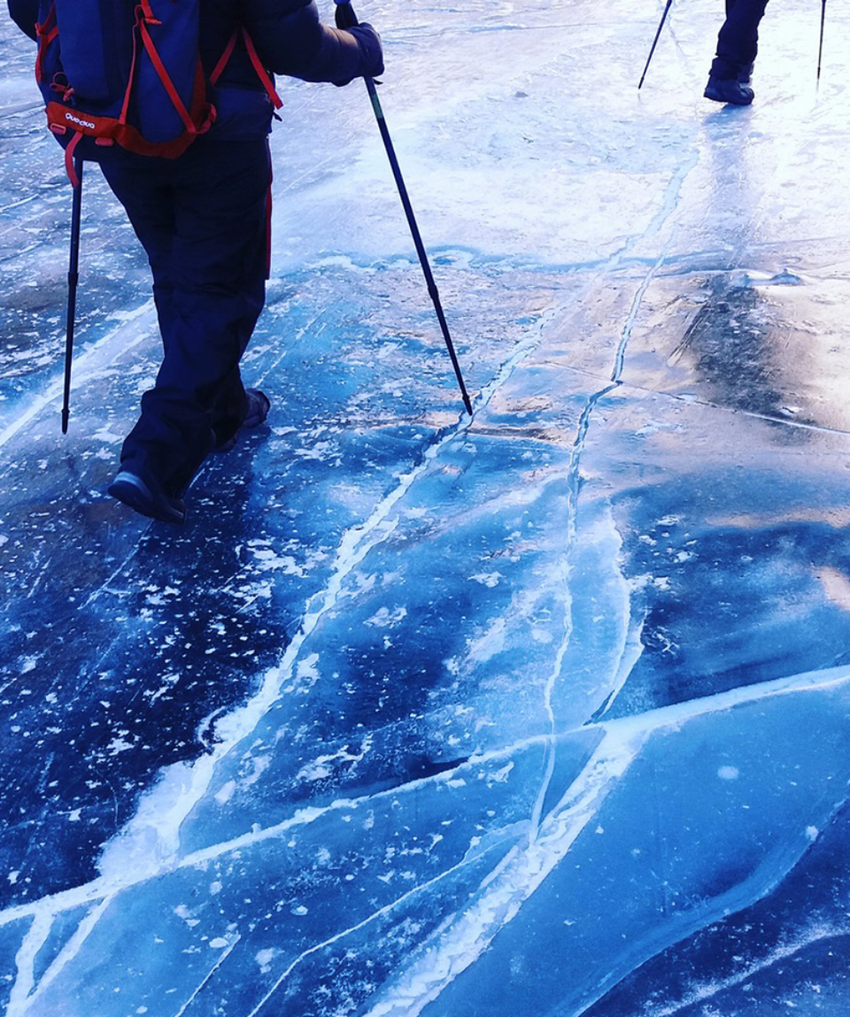
source:medium.com
Highlights of Chadar Trek
The Chadar Trek gets its name from the sheet of ice formed over the river which resembles a blanket (Chadar). This allows people to walk on it freely but in a unique way which the locals refer to as the “Penguin Walk”. This winter trail has become popular among national and international adventure enthusiasts over the years attracting some 300-400 people every year. With an average altitude of over 11,000 ft, it starts from the small village of Chilling from where the Zanskar River starts to freeze.
With a surreal landscape of varying colors, mountain caves, frozen waterfalls, and the roaring Zanskar River accompanying you throughout the trek, the Chadar Trek has some of the most breath-taking vistas and sights in the world. Passing through the deep valley on a sheet of ice over an emerald green river with towering ice walls on both sides and the warm smiles of the locals greeting you with “Juley” is what keeps you enchanted throughout the trek.
But don’t get fooled by the sheer beauty of this trail because this is one of the most arduous treks in the Himalayas taking you through a strenuous route of over 100km with an average walk of 15 km each day in bone-chilling temperatures. With occasional climbs over icy rocks and boulders, the trekkers will have a distinctive experience of camping in the caves at night.
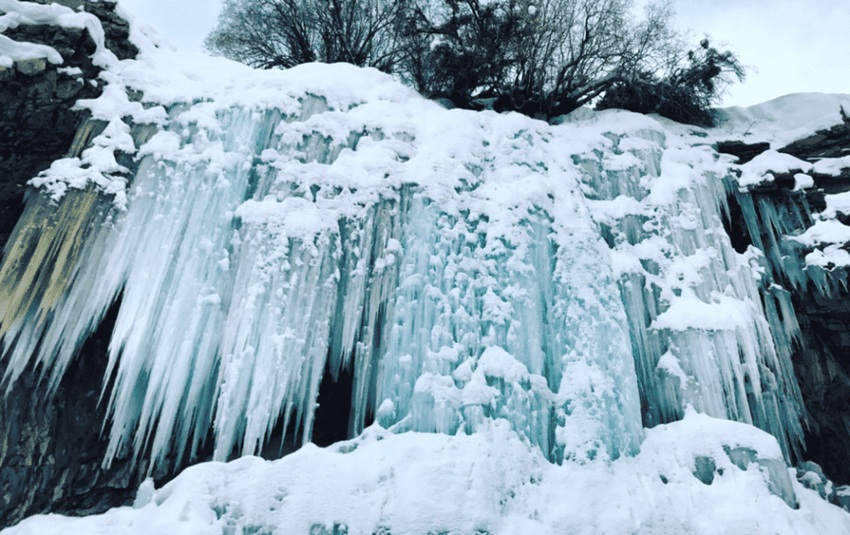
Preparation for Chadar Trek
Inarguably one of the most spectacular yet difficult treks, the Chadar Trek needs significant preparation to ensure the best and most comfortable experience one can have. It is possible only in the months of January and February when the river is completely frozen but it also leads to night temperatures going as low as -30 degree Celsius. One must be physically and mentally fit to tolerate such extreme conditions.
Ice picks, the warmest of jackets, layers of clothes, thermos flask and sleeping bags along with sturdy shoes and good quality gumboots are an absolute necessity. Trekkers must always be aware of the conditions of the ice sheets and the knowledge of how to deal with cracks and slippery ice will help you trek efficiently and safely. In case of cracks in the ice, one has to hike across snowy boulders beside the river and this demands a good level of fitness.
People often wonder how to reach Ladakh in winters when the region is completely cut-off both from Manali and Srinagar side. Well, it is easier to fly to Leh from any of the major cities and spend a couple of days getting acclimatized while you explore the city. Chilling, the start point of the trek is at a distance of 60km from Leh and this could be one of the most scenic drives of your life.
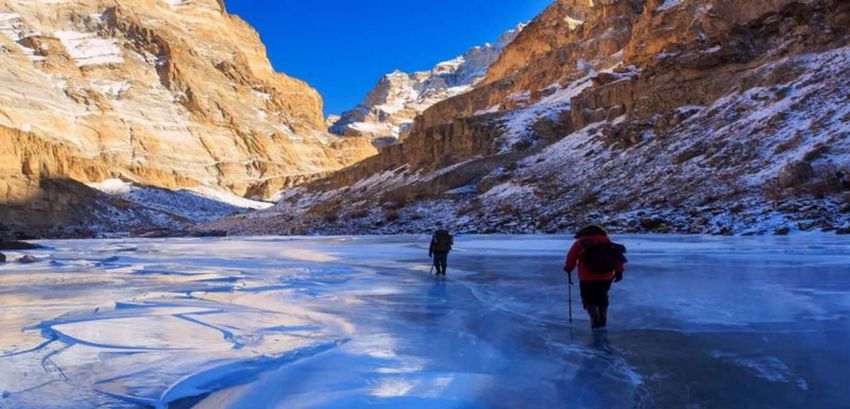
Construction of Zanskar Highway
The Indian government is constructing a brand new Zanskar Highway for connecting the Zanskar valley to the city of Leh all year round. Although the project will take a lot of time to be completed ultimately, it’s going to help around 14,000 people residing in the Zanskar valley to survive and sustain their livelihood.
This step is considered to be really helpful for the residents of Zanskar, as they would be able to remain in touch with the rest of the world even in the harsh winter climate. There won’t be any need to risk their lives by crossing the frozen Zanskar River or Chadar to reach Leh.
With the help of the new road construction, they could easily send their kids to schools, transport goods and even go to work in Leh without any hassle. It’s definitely been a life-changing step for the natives of Zanskar.
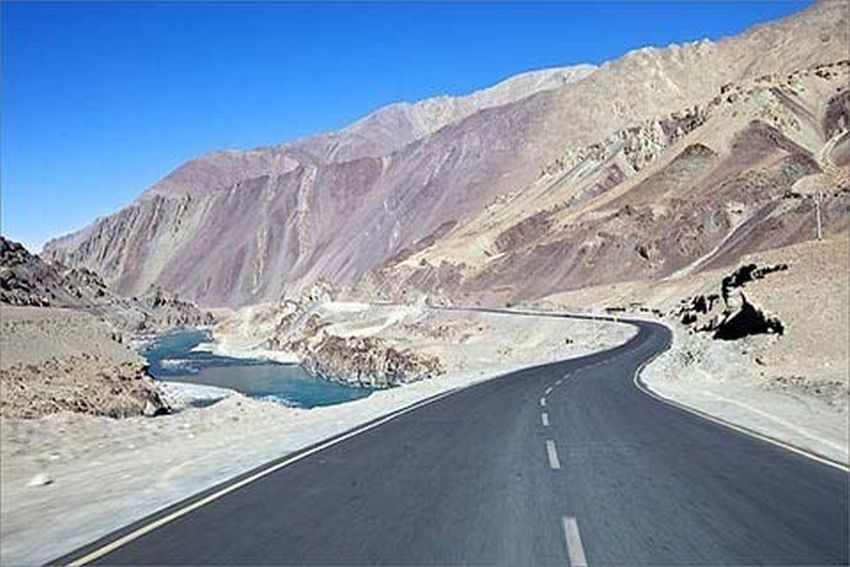
source:greaterkashmir.com
After construction of the new highway, it will be easier to access the region. The tourists might be allowed in small numbers to get a chance to witness the frozen river. The Chadar Trek will thus lose its glory and purpose.
The gorgeous Chadar trek in India is about to close for trekkers and adventure enthusiasts in a year or so because of the construction of a new highway in the region. So this is your chance to experience one of the most glorious treks in the country and tick it off your bucket list. Plan it now and undertake this trek before you no longer can. Hurry up!
Related Posts

How to Study Abroad: Guide for International Students in 2024

Choose your yoga clothes carefully

Best Exercises To Stay Fit
About the author.
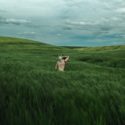

- English News
Chadar to Tso Moriri: 8 treks in Ladakh's land of highpasses
Embark on an awe-inspiring adventure in the Land of High Passes with Ladakh's breathtaking treks, from the frozen wonderland of Chadar Trek to the majestic heights of Stok Kangri, offering a unique blend of natural beauty, cultural encounters, and thrilling experiences
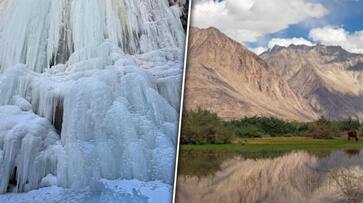
Nestled amidst the rugged and remote terrain of northern India, Ladakh beckons adventure seekers from all corners of the globe. This mesmerizing region, often referred to as the "Land of High Passes," boasts an array of breathtaking treks that offer a perfect blend of natural beauty, cultural exploration, and thrilling experiences. Ladakh's treks are renowned for their pristine landscapes, including snow-capped mountains, turquoise lakes, and ancient monasteries, making it a haven for trekkers and nature enthusiasts alike.
Chadar Trek Among the most iconic winter treks in the world, the Chadar Trek takes you on an otherworldly journey across the frozen Zanskar River. During the winter months, the river transforms into a glistening sheet of ice, providing a unique and challenging trekking experience. As you traverse the frozen waterway, you'll encounter majestic frozen waterfalls and awe-inspiring canyons, creating unforgettable memories. This trek not only showcases the stunning beauty of Ladakh but also offers insights into the traditional lifestyles of the Zanskari people.
View this post on Instagram A post shared by Itshimalayas (@itshimalayas)
Markha Valley Trek The Markha Valley Trek takes adventurers on an enthralling journey through the heart of Ladakh. As you trek along the Markha River, you'll pass through quaint villages, ancient monasteries, and vibrant Buddhist prayer flags. The diverse landscapes along the route include verdant valleys, barren cliffs, and snow-capped peaks, painting a vivid tapestry of nature's wonders. With opportunities to interact with the warm-hearted Ladakhi locals, this trek is a unique cultural experience complemented by breathtaking scenery.
Stok Kangri Trek For seasoned trekkers and mountaineers seeking a formidable challenge, the Stok Kangri Trek stands tall as one of the highest trekking peaks in India. Reaching the summit at an altitude of over 6,000 meters offers a surreal panorama of the surrounding peaks. The trek requires prior acclimatization and basic mountaineering skills, but the sense of accomplishment and awe-inspiring vistas make it worth the effort.
Lamayuru to Alchi Trek The Lamayuru to Alchi Trek is a fusion of spirituality and adventure. Starting from the ancient Lamayuru Monastery, the trail meanders through arid landscapes, rugged terrains, and traditional Ladakhi villages. As you pass Alchi Monastery, renowned for its exquisite murals and woodwork, you'll feel a profound sense of tranquility amidst the stunning surroundings.
Nubra Valley Trek The Nubra Valley Trek offers a delightful sojourn into the "Valley of Flowers." Nestled between towering mountains, the valley surprises trekkers with its lush greenery and sand dunes—a rare combination in Ladakh. Crossing the world-famous Khardung La Pass, the trek provides stunning views of the landscape below. The experience is further enriched by encounters with the warm-hearted locals and the opportunity to ride double-humped Bactrian camels, adding a touch of uniqueness to this Himalayan adventure.
Tso Moriri Lake Trek The Tso Moriri Lake Trek is a mesmerizing journey that leads trekkers to the pristine Tso Moriri Lake, surrounded by snow-capped peaks. This high-altitude lake is a protected area and serves as a haven for migratory birds, making it a paradise for birdwatchers. The trail takes you through nomadic settlements, offering glimpses into the unique lifestyle of the Changpa nomads. As you camp under the starlit skies, the serene beauty of the lake and its surroundings will leave an indelible mark on your soul.
Rupshu Valley Trek The Rupshu Valley Trek offers a glimpse of the mystical Rupshu region, characterized by its high-altitude desert landscape and vibrant Buddhist culture. Trekking through this arid terrain, you'll encounter picturesque hamlets and ancient monasteries. Interactions with the hospitable Ladakhi people will deepen your understanding of their ancient customs and traditions. The stark yet captivating beauty of the Rupshu Valley, combined with the spiritual ambiance of the monasteries, creates an unparalleled trekking experience.
Snow Leopard Trek For wildlife enthusiasts and those seeking a rare encounter, the Snow Leopard Trek in Hemis National Park is a dream come true. This elusive big cat roams the high-altitude regions of Ladakh, and the trek offers a chance to spot these majestic creatures in their natural habitat. As you tread softly through the snow-laden trails, keep your eyes peeled for the mesmerizing sight of a snow leopard. Alongside this thrilling experience, immerse yourself in the pristine beauty of the national park, with its diverse flora and fauna.
ALSO READ: Monsoon season: 7 ways to dry your wet clothes during rain
Trekking in Ladakh is an unforgettable adventure that caters to the souls of both nature lovers and cultural enthusiasts. From traversing the frozen riverbeds of Chadar Trek to summiting the mighty Stok Kangri, each trek reveals a different facet of Ladakh's charm. The region's untouched beauty, coupled with its rich cultural heritage, creates an unparalleled experience for trekkers. As you explore these remote and awe-inspiring landscapes, you'll be left with memories etched in your heart, and a deep appreciation for the boundless allure of Ladakh, the Land of High Passes.
Also Read: Here are 7 best ways to use a sunscreen during monsoon
- Ladakh Tourism

Latest Videos
RELATED STORIES

Maharashtra: Pune man's unconventional farewell to 'toxic workplace' goes viral (WATCH)
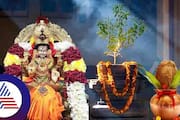
Akshaya Tritiya 2024: Know date, auspicious timings and more

Mexican street tacos to chicken teriyaki: 6 restaurant style dishes to make at home

EPF rates for FY 23-24 increased to 8.25%: When will it be credited? Here's how to check your account balance

Unexplained fatigue to abdominal pain: Lesser-known symptoms of Testicular Cancer
Recent Stories

IPL 2024: Delhi Capitals edge past Mumbai Indians in thrilling encounter at the Arun Jaitley Stadium

ISL 2023-24 Preview: Mohun Bagan SG eye finals berth in clash against Odisha FC; team news, key players & more

IPL 2024, DC vs MI: Rohit Sharma gives Rishabh Pant a kite, here's what DC skipper does (WATCH)
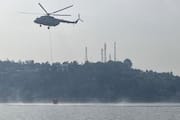
Nainital forest fires: IAF Mi-17 V5 helicopter undertakes 'Bambi Bucket Ops' to douse raging flames (WATCH)

'Focus on Constitution, laws & security': Ujjwal Nikam after BJP fields 26/11 lawyer from Mumbai North Central
Recent Videos

Manipal Hospitals facilitates voting for 50 medically fit inpatients during Lok Sabha elections 2024 (WATCH)

Lok Sabha elections 2024: 78-year-old woman with pneumonia comes to vote on Stretcher in Bengaluru

Narendra Modi EXCLUSIVE! 'I cannot accuse Christians of not supporting BJP'

Narendra Modi EXCLUSIVE interview: 'I am not an astrologer, but I understand the vibrations' (WATCH)

EXCLUSIVE! PM Narendra Modi corrects 3 misconceptions about BJP (WATCH)
Best Treks in chadar-trek
Rent A Gear
Trek Articles
Quick Links
Trekking & Hiking
Mountaineering
Multi Sports
Himalayan Pilgrimage
Website Privacy
Terms & Condition
Contact Info
Get in touch with us. E-mail us Monday-Saturday (10 AM to 6 PM)
Address: Trek The Himalayas, Kaintura Plaza, Badrinath Road Tapovan, Rishikesh - 249201 Uttarakhand
Phone: 8191004846
Email: [email protected]
2010 Trek The Himalayas. All rights reserved
10 Must-Do activities in Ladakh in 2024
Apr 23, 2024
Explore Leh
Begin your Ladakh journey by exploring the charming town of Leh. Visit Leh Palace, Shanti Stupa, and Leh Market to immerse yourself in the local culture, architecture, and vibrant atmosphere.
Credit: Envato
Visit Monasteries
Ladakh is home to numerous ancient monasteries, each with its own unique architecture and spiritual significance. Some must-visit monasteries include Thiksey Monastery, Hemis Monastery, Diskit Monastery, and Lamayuru Monastery.
Credit: Unsplash
Visit Pangong Lake
Experience the surreal beauty of Pangong Lake, famous for its ever-changing shades of blue. Spend a night at one of the camps near the lake to witness the magical sunrise and sunset against the backdrop of the Himalayas.
Explore Nubra Valley
Explore the high-altitude desert landscape of Nubra Valley, where you can ride double-humped Bactrian camels amidst the towering sand dunes of Hunder and Diskit. Don't miss visiting the Diskit Monastery with its giant statue of Maitreya Buddha.
Khardung La Pass
Embark on a thrilling journey to Khardung La Pass, one of the highest motorable passes in the world. Enjoy panoramic views of the surrounding mountains and valleys, and don't forget to capture some memorable photographs at the iconic signboard.
Ladakh offers a variety of trekking opportunities for adventure enthusiasts. Popular treks include the Markha Valley Trek, Stok Kangri Trek, and the Chadar Trek (in winter). These treks take you through remote villages, high mountain passes, and breathtaking landscapes.
River Rafring
Experience the adrenaline rush of river rafting in the Indus and Zanskar rivers. The thrilling rapids amidst the stunning scenery make for an unforgettable adventure.
Attend Festivals
If you're visiting Ladakh during the festival season, make sure to attend festivals like Hemis Festival, Ladakh Festival, and Sindhu Darshan Festival. These festivals offer insights into the region's culture, music, dance, and traditional rituals.
Photography
Ladakh is a paradise for photographers, offering stunning landscapes, vibrant culture, and unique wildlife. Capture the beauty of the region, including dramatic landscapes, colourful prayer flags, and traditional Ladakhi architecture.
With its clear skies and minimal light pollution, Ladakh offers excellent stargazing opportunities. Spend a night under the starry sky, marvelling at the Milky Way and constellations visible in the high-altitude desert.
Musk makes his second trip to China in less than a year to hurry along self-driving tech rollout, reports say
Read More Here

FlickSphere
21 Things About Star Trek That Fans Hesitate to Acknowledge
Posted: April 27, 2024 | Last updated: April 27, 2024

Star Trek Reused the Same Sets Often
There were some sexist vibes.

Star Trek Was Forced to Move With the Times

We’ve All Fancied an Alien on Star Trek at Some Point in Our Lives

Drama in Deep Space Nine’

Star Trek Voyager Criticized for Having a Female Captain

The Story Lines Weren’t Always Great

Some of the Costumes Were Not Good

We Want Captain Picard Back

Most Fans Preferred the TV Series to the Movies

We Have all Tried to Speak Klingon
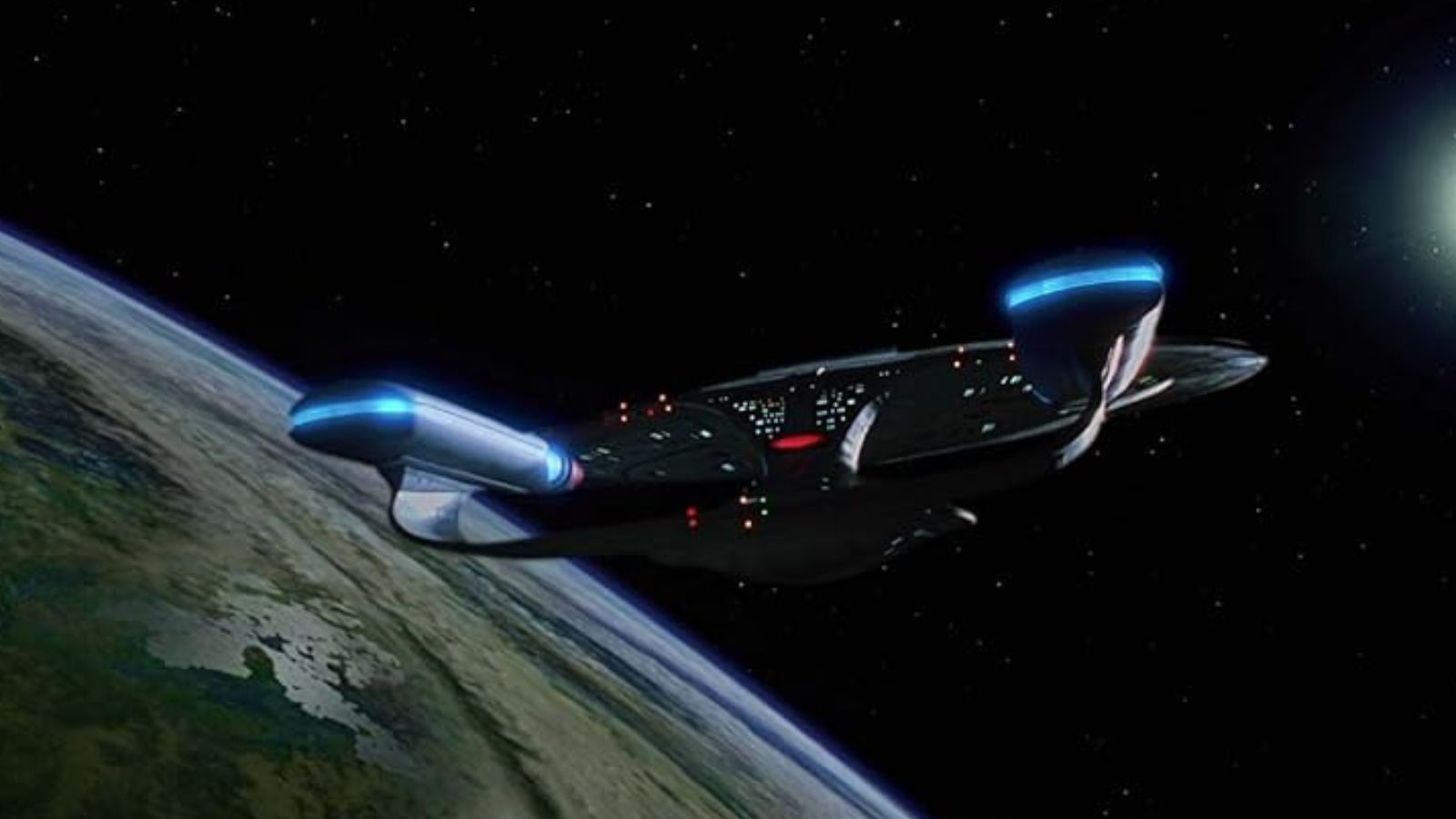
Sometimes, Star Trek Was Scary

The Theme Tune Was Awesome

Star Trek’s Original First Officer Was a Woman

Spock Impressions

Some of the Tech from the Trek Has Already Become a Reality

William Shatner and Leonard Nimoy Both Got Tinnitus

Spock’s Vulcan Salute is a Special Blessing in Hebrew

Star Trek Didn’t Only Recycle its Sets; It Also Recycled Actors

The Star Trek Brand Has Become Over-Commercialized

18 Formerly Beloved TV Shows That Would Flunk the Political Correctness Test Today

18 Films That Went Too Woke in the Last Decade

Empty Screens: 18 Movies Where Almost Nothing Really Happens
More for You
Liz Cheney's Message to Supreme Court After Donald Trump Hearing
Cuban mercenaries eliminate Russian regiment commander in Donetsk region
Man loses 450 pounds after reaching 'rock bottom.' 1 key diet change helped
Ranking the 21 'American Idol' winners
19 Things That Will Happen When You Stop Drinking Alcohol
Large amount of Gen Z workers set to be laid off and replaced by AI, study finds
The first interracial kiss aired on TV more than 55 years ago—and more shows that broke racial barriers
11 Facts You Should Know About Hard-Boiled Eggs
I Lost 50lbs With 3 Lifestyle Changes
Ghosts of the USA: The Most Haunted Places in America
Baking Soda Makes a Great DIY Weed Killer—Here's How to Use It
The seven new types of old age – and how to tell which one you are
7 Ways People Destroy the Value of Their Homes, According to a Real Estate Agent
Blood pressure is best lowered by 2 exercises, study finds
NFL Chiefs eye new home after voters reject renovation tax
The 1.6 million-year-old discovery that changes what we know about human evolution
29 common human foods you may not realize are poisonous to your dog
Luke Grimes Supports Kevin Costner's Decision On ‘Yellowstone'
9 Reasons Not to Use Miracle-Gro Soil In Your Garden
Bill Gates: 7 Expenses He Spends the Most Money On
17 of the most famous cliffhangers in TV history
- Cliffhangers are an important part of television history.
- Iconic sitcoms, prestige TV shows, and soap operas have used cliffhangers in their storytelling.
- Some of the most famous were on "Game of Thrones," "Grey's Anatomy," and "Lost."

Writing for television is all about how to keep your audience tuning in.
One way to do that is to get viewers emotionally invested … only to put their beloved characters in mortal peril , emotional hell, or a combination of the two.
In the era of television before streaming, cliffhangers used to be a way to keep viewers tuning in every week. During "sweeps week" — ratings periods held four times a year — networks would bring out their biggest, most shocking storylines to try to lure in the most viewers to boost viewership and, therefore, ad revenue.
Some of the most iconic moments in TV history — including some of the cliffhangers below — took place during sweeps weeks.
However, streaming has changed the game when it comes to retaining viewers, and it seems like almost every episode of a Netflix series ends in a cliffhanger to keep you binging.
Here are some of the most iconic cliffhangers in TV history — not all of which ended up satisfying viewers in the long run. But they all got people talking and kept them watching week after week.
The final shot of "The Sopranos" has been debated for years.
As the final season of " The Sopranos " progressed and the bodies kept piling up, it became clearer than ever that Tony, the head of a New Jersey crime family played by James Gandolfini, wouldn't have a happy ending to his story in the 2007 finale, "Made in America."
Audiences didn't expect the show's final scene to be the Soprano family meeting at a diner while "Don't Stop Believin'" played on a jukebox. The camera showed the front door of the diner opening before cutting to black, ending the show.
People across the country thought HBO had crashed. But the show's creator, David Chase, made it clear that this was the end and that he had no intention of telling us whether the person who arrived at the diner was there to whack Tony.
"Game of Thrones" had several cliffhangers throughout its eight-season run, but its most troubling was the stabbing of Jon Snow in season five.
By the time season five of " Game of Thrones " was airing in 2015, audiences knew not to get attached to anyone.
But if "Thrones" had a main character by season five, it was Jon, played by Kit Harington.
So when the season concluded with the episode "Mother's Mercy," in which his so-called brothers conspired to kill him via group stabbing, fans were shocked — well, the ones who hadn't read the books at least.
After the season ended, Harington swore he wasn't returning to the world of Westeros, which made viewers wonder: What would happen next? You'd have to tune in to season six to find out.
The sixth season of "The Walking Dead" used an inventive camera trick to hide who exactly Negan was beating to death with his beloved baseball bat, Lucille.
" The Walking Dead " waited until the finale of season six in 2016 to properly introduce viewers to Negan (played by Jeffrey Dean Morgan) after teasing him for the entire season.
And what an introduction it was. After terrorizing the main characters off-screen, Negan realized he couldn't decide who to kill and used a game to pick his victim in the episode "Last Day on Earth."
But we didn't get to see his selection — the camera switched to the point of view of the victim, who was then viciously bludgeoned by Negan.
Viewers didn't find out until season seven who was on the receiving end of Lucille's wrath.
You might not think of "Star Trek: The Next Generation" as a show capable of cliffhangers, but when Jean-Luc Picard was turned into a Borg, viewers worldwide were desperate for the next season.
" Star Trek " is a fairly episodic show by design. But when the season-three finale aired in June 1990, it became clear that even "Star Trek" knew the power of a good cliffhanger.
The third season ended with the episode "The Best of Both Worlds," in which Jean-Luc Picard (Patrick Stewart), the brave captain of the Enterprise, is taken captive by an evil alien species called the Borg, who have the power to eventually take over the galaxy.
Picard's friend and first officer, William Riker (Jonathan Frakes), is left with a choice: Does he mount a rescue mission or take the opportunity to wipe out the Borg, Picard included?
The episode concludes with Riker firing on the Borg's ship before hitting us with a "To be continued…" leaving Picard's fate up in the air until season four.
When the door of the hatch was blown off its hinges in the season-one finale of "Lost," it became clear this wasn't just a show about a group of plane-crash survivors.
Throughout the first season of " Lost " in 2004 and 2005, fans kept getting hints that this wasn't your typical deserted island.
But in the episode "Exodus," when Jack (Matthew Fox) and Locke (Terry O'Quinn) blow the door off a mysterious hatch they found on the floor of the jungle and realize it goes deep underground, we get confirmation that something's wrong on this island.
Meanwhile, Walt (Malcolm David Kelley), a young boy on the plane, is snatched from a rescue raft by a mysterious group of people known only as the Others.
In retrospect, it's wild that we had to wait months to find out who took Walt and what was at the bottom of the hatch.
Two seasons later, the rug was pulled out from under "Lost" fans again. One word: flash-forwards.
From the first episode of " Lost ," it was clear each episode would split the action between present-day happenings on the island and flashbacks, usually focused on one survivor.
But the season-three finale, "Through the Looking Glass," which aired in 2007, seemed different. We watched as Jack became heavily depressed, even suicidal, and hooked on painkillers — a previously unknown part of Jack's history.
But the last scene of the finale showed us that this wasn't a flashback but a flash- forward , letting us know that at least Jack and Kate (Evangeline Lilly) would be rescued from the island at some point and that Jack would tearfully tell Kate they had to go back to the island, changing the course of "Lost" forever.
In 1980, it was impossible to watch TV without CBS asking, "Who shot J.R.?"
By the time " Dallas " entered its third season, audiences were captivated by the wheeling and dealing of the Ewing oil/cattle dynasty.
And no character was more admired (or reviled) than J.R. Ewing (Larry Hagman), a scheming oil tycoon who stopped at nothing to get what he wanted.
When the season-three finale, "A House Divided," concluded with his shooting by a mysterious gunman, TV audiences became consumed by the question "Who shot J.R.?"
It could've been anyone, as everyone on the show had a reason to kill J.R. In fact, everyone on the show was filmed shooting J.R. to keep it a secret from audiences and the crew alike.
It took four episodes of season four before the shooter's identity was revealed.
"The Simpsons" poked fun at "Dallas" with its two-part episode "Who Shot Mr. Burns?"
Fifteen years after the "Dallas" episode, " The Simpsons " concluded its sixth season by showing Mr. Burns (Harry Shearer), the greedy owner of the Springfield Nuclear Power Plant, getting shot.
The first part of the episode contains many clues (and some red herrings) about who shot Burns — but as with Ewing before him, everyone had a reason to want him dead.
We won't spoil it here, but the season-seven premiere clarifies who shot Burns, and the reveal's certainly worth the wait.
Another cliffhanger involving a shooting is the first season finale of "The West Wing," which ends with a Secret Service agent asking who's been hit.
" The West Wing " became a phenomenon throughout its first season in 1999 and 2000, but it took the cliffhanger in the season-one finale ("What Kind of Day Has It Been") to put it on the map.
The senior staff of President Jed Bartlet (Martin Sheen) is at an event where the president's speaking when a gunman opens fire.
In the chaos, we see each member hit the ground. But before we can assess who's safe, the camera pans out, and we hear a frantic Secret Service agent over the radio asking who's been hit.
We didn't find out the answer until the season-two premiere months later.
We should've known that "Scandal," another show about the White House, would also use an assassination attempt as a cliffhanger. But it was shocking just the same.
This wasn't a season finale, but it was still very nerve-racking to wait a week to see if President Fitzgerald Grant III, played by Tony Goldwyn, had survived getting shot while entering his birthday party.
The season two episode, "Defiance," was wild enough without the attempt; it was mainly about James, a reporter, investigating the claim that the voting machines had been rigged in the election that resulted in Fitz's win.
But then, in the last two minutes — bang. Fitz was shot by an unseen assailant, thrown back into his limo, and rushed to the hospital, his fate unknown.
The next episode, "Happy Birthday, Mr. President," revealed that Fitz was alive, but he wouldn't wake up for a few more episodes. Classic " Scandal " drama.
The final cliffhanger involving a shooting on this list comes from the first season finale of "Twin Peaks" in 1990.
It's impossible to predict what will happen on " Twin Peaks ," which began as a murder-mystery show and ended as something quite different.
In the first season, the show's creator David Lynch mainly adhered to the mystery aspect of the show, down to the last moments of the finale, when FBI agent Dale Cooper (Kyle MacLachlan), the main character, is shot on his doorstep by an unknown gunman.
There are theories to this day about the identity of Cooper's would-be killer, making it an all-time cliffhanger.
"Grey’s Anatomy" fans won't forget where they were when they discovered Derek Shepherd had a wife.
Season one of " Grey's Anatomy ," which aired in 2005, had a lot of characters to juggle, but perhaps the most compelling plot line at the time was watching Meredith Grey (Ellen Pompeo), a surgical intern, fall in love with her boss, the neurosurgeon Derek Shepherd (Patrick Dempsey).
It seemed they'd finally figured out their issues in the finale of season one, "Who's Zoomin' Who?" — only for a statuesque redhead (Kate Walsh) to greet Derek and say to Meredith, "You must be the woman who's been screwing my husband."
Around the country, jaws dropped. Answers would come months later, in season two.
And do you remember where you were when Ross said "Rachel" at the altar on "Friends"?
Ross (David Schwimmer) and Rachel (Jennifer Aniston) were one of the greatest will-they-won't-they couples of our time.
It was a huge surprise when Ross decided to marry Emily (Helen Baxendale), his British girlfriend of only a few months, in the 1998 finale of season four, "The One With Ross's Wedding."
But the pull of Ross and Rachel's unfinished business was too strong for Ross, and viewers (and Rachel) gasped as Ross said, "I, Ross, take thee, Rachel" at the altar.
The officiant asks Emily if he should continue. Before we find out her answer, the episode ends, leaving Ross' marital status up in the air until the season-five premiere, aptly titled "The One After Ross Says Rachel."
Speaking of will-they-won’t-they duos, it seemed the central couple of "Alias" was going to figure it out before a two-year surprise time jump ruined everything.
" Alias " starred Jennifer Garner as the superspy Sydney Bristow and Michael Vartan as Vaughn, her handler.
Their explosive chemistry was a huge part of the show's success, but it became increasingly ridiculous that these people wouldn't fall in love by season two.
And so they did — until the season-two finale, "The Telling," in 2003. After surviving a particularly nasty fight, Sydney wakes up in Hong Kong, asking for Vaughn.
He arrives, only to tell Sydney that she's been missing for two years and that in that time he's married someone else. A true gut punch, even 21 years later.
How could there be a "Buffy the Vampire Slayer" without Buffy? Fans were forced to ask this question after the fifth season finale.
Throughout the first five seasons of " Buffy ," the titular vampire slayer (Sarah Michelle Gellar) gave more of herself than any teenager should be expected to give.
But in the season-five finale in 2001, titled "The Gift," she sacrificed herself to save her sister, Dawn (Michelle Trachtenberg); her friends; and the town of Sunnydale.
The episode's final shot is a close-up of Buffy's gravestone, which declares: "She saved the world. A lot."
How could there be a season six of "Buffy" without Buffy? Fans were asking this question until the show came back and it became clear that Buffy's death would have long-term consequences for the show.
The sixth season of "ER" in 2000 employed a rare midseason cliffhanger when a patient attacked John Carter and Lucy Knight.
Throughout the first episode ("Be Still My Heart"), Lucy Knight (Kellie Martin) is trying to tell her boss, Dr. John Carter (Noah Wyle), that she's concerned about her patient's mental state.
Busy with other things, John ignores her, with disastrous consequences. The patient stabs them both, and the episode ends with a haunting image of John and Lucy staring at each other on the floor next to a hospital bed.
That's nothing compared with what happened the following week when their colleagues found them in this state, in the episode "All in the Family."
After a season of teasing a future wedding, the sixth season finale of "How I Met Your Mother" finally revealed that Barney was the groom.
"How I Met Your Mother" frequently employed cliffhangers — in fact, the whole show could be considered a cliffhanger, as Ted didn't meet the titular mother until the series finale.
But one of the longest-running cliffhangers was first hinted at in the premiere of season six, when the gang was seen in the near future attending a wedding where Ted was the best man — but fans didn't get a glimpse at the bride or the groom.
That is, until the season finale when it was finally revealed that the groom was notorious womanizer and commitment phobe Barney Stinson (Neil Patrick Harris).
But who was the bride?
We had to wait an entire season until the finale of season seven, when it was finally revealed that Barney would eventually marry Robin.
And then they lived happily ever after, as long as you ignore the events of the controversial series finale.
When you buy through our links, Insider may earn an affiliate commission. Learn more .
- Main content

IMAGES
COMMENTS
The Chadar Trek is one of the most wild and beautiful hikes on the planet. Frequently covered by the world's top adventure channels and media outlets, the Chadar Trek takes hikers through a frozen river valley into the very heartland of India's Ladakh region. The region's harsh desert environment and towering mountains make the Chadar trek ...
The Chadar Frozen Trek is renowned as one of the world's most iconic and challenging treks, offering a unique and extraordinary experience for adventurers. Takes trekkers through the starkly beautiful and remote landscapes of Ladakh, providing an opportunity to witness the untouched beauty of the region. Trekkers traverse the frozen Zanskar ...
Best Time to Visit Chadar Trek. The ideal time to visit the Frozen River Chadar Trek is between mid-January to February as during this time the upper layer of the Zanskar River freezes. The river looks like a sheet of ice; hence, it is referred to in the local language as 'Chadar' which means blanket. Read more: Hidden Hill Stations In India.
The Chadar Trek or the Zanskar Gorge trek is a winter trail over the frozen Zanskar River, which lies in the Indian union territory of Ladakh. It is traditionally the only means of travel in the area during the harsh winter months. The trail has become popular with foreign adventure tourists.
Situated in the Leh region of Ladakh, the Chadar trek is one of the most magnificent treks in the Himalayas that allows you to cover a distance of 62 kilometers in just nine days. It is one of the most popular and longest trekking trails that provides a dream come true experience to the trekkers while hiking along the dramatic mountains.
Chadar Trek: Few Forewords. During the winter season, the Zanskar River freezes and appears like a sheet ( chadar) of ice. This trek is popularly known as the Frozen River Trek. It is considered one of the toughest treks in India. During the trek, one has to cover approximately 105 kilometers on foot. The mercury count is -15 to -20 degrees in ...
The Complete Guide for The Chadar: The Frozen River trek in Ladakh. With temperatures as low as -30C it is one the coldest treks in the world. ... I often refer to the Chadar trek as the 8th wonder of the world, the landscapes, ... In fact, as the famous Sherpa's are to the mountains in Nepal, the "Zanskari's " ( people from Zanskar) ...
The chadar trek is also known as the frozen river trek or the Zanskar trek. The chadar trek is one of the oldest and most traditional routes in Ladakh, as it was used by the local people, especially the Zanskari people, to trade and communicate with the outside world when the road access was blocked by snow.
Chadar trek in the beautiful landscape of Ladakh is one of the most adventurous and most difficult treks in the country. The distance that is covered on foot is approximately 105 km and on an average, a trekker covers 15 to 17 km every day. The temperatures are usually 15 to 20 degrees during the day time and plummet to -25 to -35 degrees ...
The best time for the frozen river trek is between mid-December and Mid-February. This is the time when the upper layers of the Zanskar River freeze due to the dip in temperature. The temperature in Ladakh during these months remains between -5 degrees Celsius to -35 degrees Celsius. Due to such low temperature, the river looks like a sheet of ...
Ladakh Frozen Trek - its world famous trek which is well known as Chadar trek formed by the freezing of the zanskar river. Best time to visit Jan to Feb. ... The Chadar Trek (Frozen River) is a freezing escape that embarks upon the blanket of a large icecap on the River Zanskar. The strenuous walk connects us from Ladakh to the snow bound ...
Chadar Trek - Location. The thick layer of ice in the Zanskar River looks like a white blanket - called chadar in the local language. Thus, the trek is famous as the Chadar Trek among tourists. This exciting trek is must visit place for those who love challenges and have a flair for high altitude trekking. The location of Chadar Trek will ...
Ofcourse the frozen Zanskar river. Zanskar River is located in the Ladakh region, home to a vast array of natural wonders but one of the most magnificent beauties of Ladakh is the Zanskar River and it is most appealing when it is in its frozen form. The Chadar trek starts from Chilling to Shingra Koma.During the harsh winter months, the Chadar trek offers connectivity between the remote ...
BRS 5. Chadar - The Frozen River Trek is a level 5 adventure on the Bikat Rating Scale. This makes it mandatory for you to have high-altitude experience of preferably multiple treks marked at level 4 on the BRS. The altitude, the terrain and the nature of the climb demand a certain level of skill and a need for you to be aware of how your body ...
It is a 6-day trek in inhospitable conditions. It is a trek over a frozen river in Ladakh. The average mean temperature during the day is minus 10. At the night, temperatures fall to minus 20 and 25. Ice forms break and change colour on the river every few hours. In places, the Chadar (or ice) does not form over the river.
The Chadar trek frozen river is the Zanskar river which gets frozen during the winter, and the ice sheets get thick enough in January for the Chadar trek. ₹ 26000 ₹ 18000 / Person. Call us @ 9469823116. Please read the World health organization's travel advice, before traveling anywhere.
Chadar Trek In Leh - over the Zanskar River range of Ladakh-2024- Complete information, Itinerary, Costs Date. Your trek journey started with Himalayan Hikers, beautiful mountain town of Leh, all our trekker reach Leh by flight this is best option to you reach to Leh, altitude is 11400 feet above sea level, the trek beautiful Zanskar River which liws totally frozen during the December to Feb ...
The Chadar Trek is the world's most famous trek in Ladakh. This trek is a beautiful experience with a sight of frozen lake and waterfalls. Chadar trek is all about persistence and survival in the brain freezing sub-zero degree. Zanskar Village's frozen trail traverses out a white 'chadar' that acts as the mirror for the sky.
Experience the mesmerizing Chadar Trek with the best chadar trek organizers. Operating from Leh, Double Sleeping bags & Guaranteed departures for Chadar Trek. ... And this setting makes it one of the most stunning treks in the world. Chadar Trek is a walk on the frozen Zanskar River where temperatures drop down to -35 degrees at night in winter.
History of Chadar Trek. The Chadar has been a historical trade route between the Zanskar Valley and Ladakh for over 1000 years. Connecting the Zanskar Valley, one of the most isolated regions of Ladakh, with the rest of Ladakh the Chadar has been used by the local Zanskari people for trade and commercial purposes since ages.
Among the most iconic winter treks in the world, the Chadar Trek takes you on an otherworldly journey across the frozen Zanskar River. During the winter months, the river transforms into a glistening sheet of ice, providing a unique and challenging trekking experience. ... Crossing the world-famous Khardung La Pass, the trek provides stunning ...
Chadar Trek Frozen River; Chirbatiya Weekend Trek ; Chopta Chandrashila Tungnath Trek with Deorital; Dayara Bugyal Trek; Deo Tibba Peak Expedition; ... Trek The Himalayas, Kaintura Plaza, Badrinath Road Tapovan, Rishikesh - 249201 Uttarakhand Phone: 8191004846. Email: [email protected]. 2010 Trek The Himalayas. ...
Popular treks include the Markha Valley Trek, Stok Kangri Trek, and the Chadar Trek (in winter). These treks take you through remote villages, high mountain passes, and breathtaking landscapes.
Ladakh's famous Chadar trek, a rare adventure sport involving a 15-day trek to cover 105 km mostly over the frozen Zanskar river, has been halted due to increase in daytime temperature, and ...
The Deep Space Nine (DS9) series, which aired between 1994 and 1999, holds a special place in many people's hearts. It featured some of Star Trek's most legendary characters, such as Worf ...
Patrick Stewart in "Star Trek: The Next Generation." Paramount Domestic Television "Star Trek" is a fairly episodic show by design. But when the season-three finale aired in June 1990, it became ...